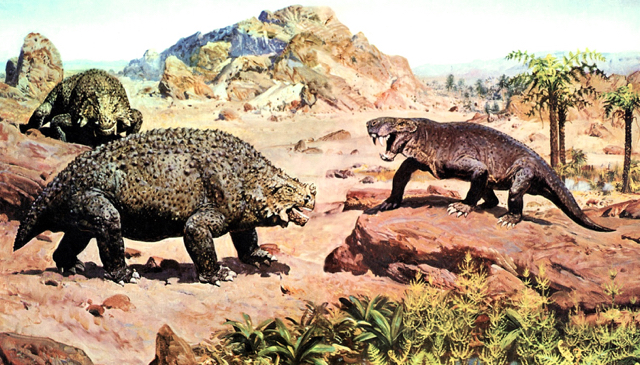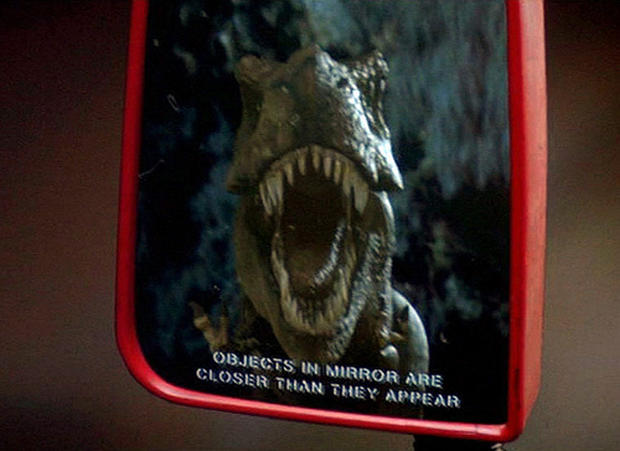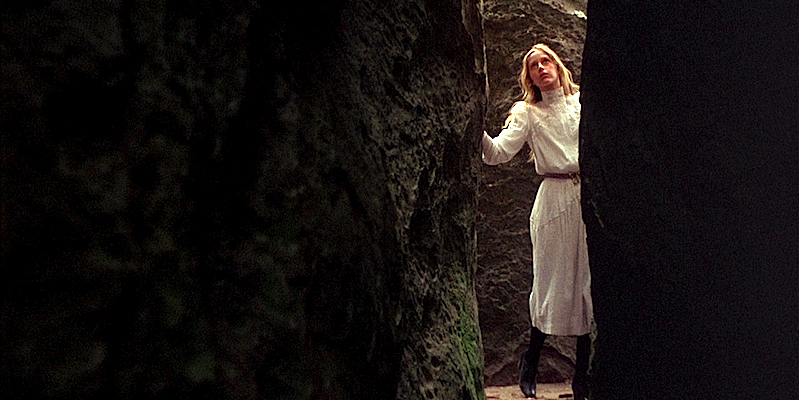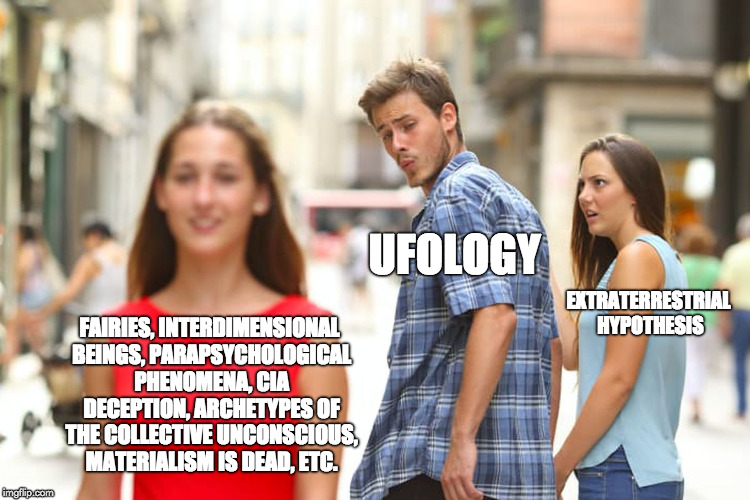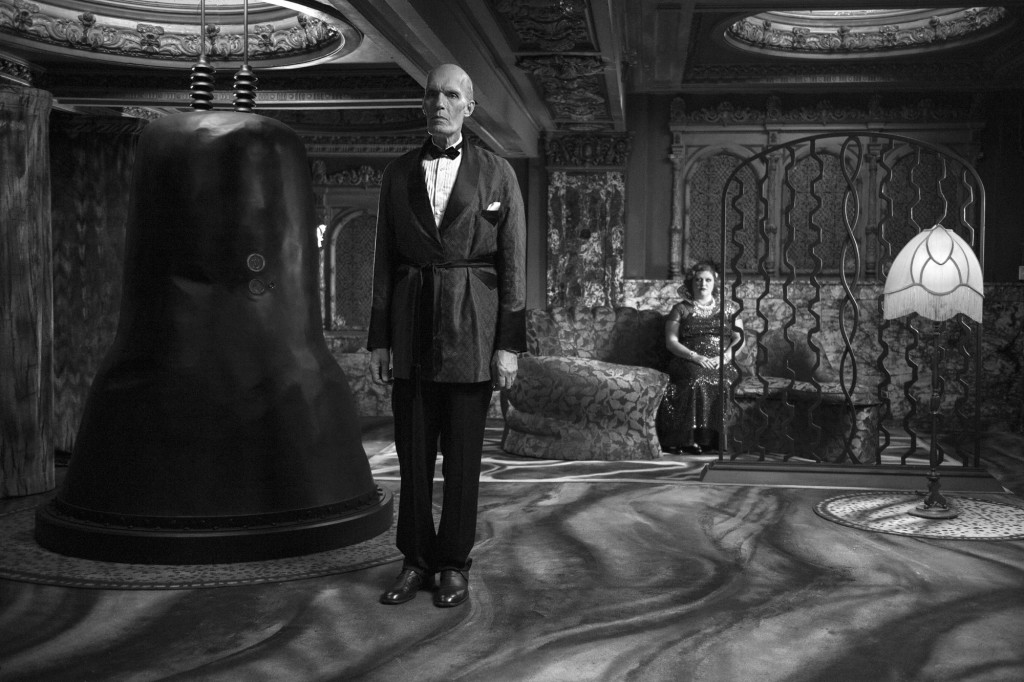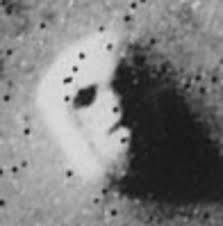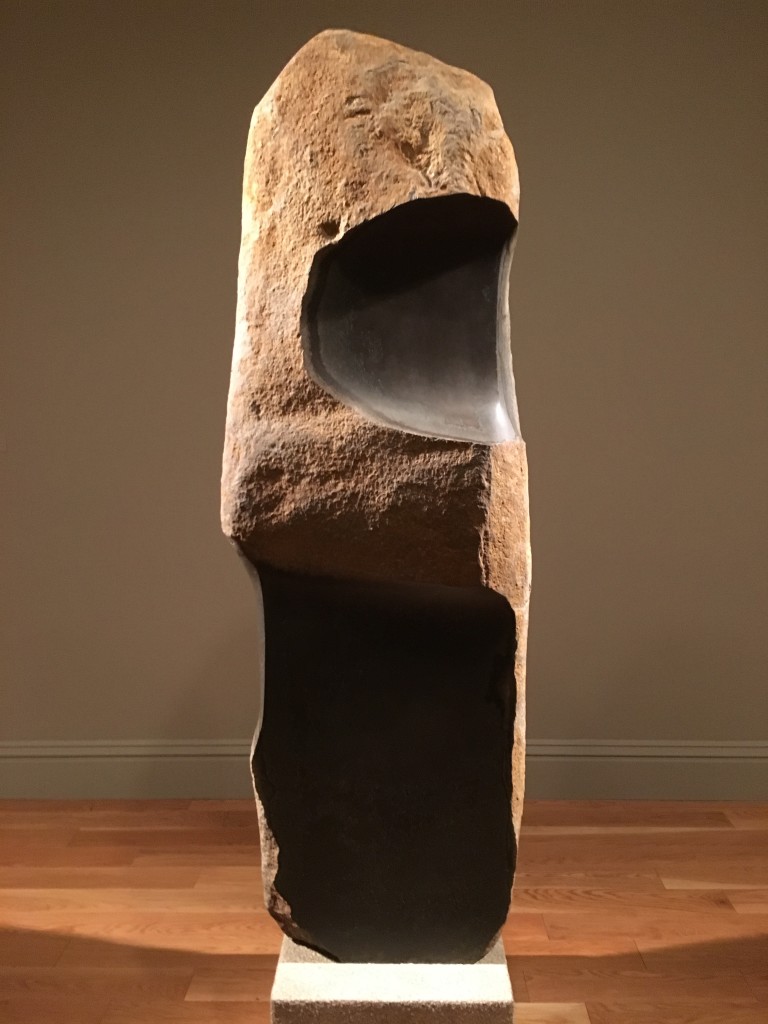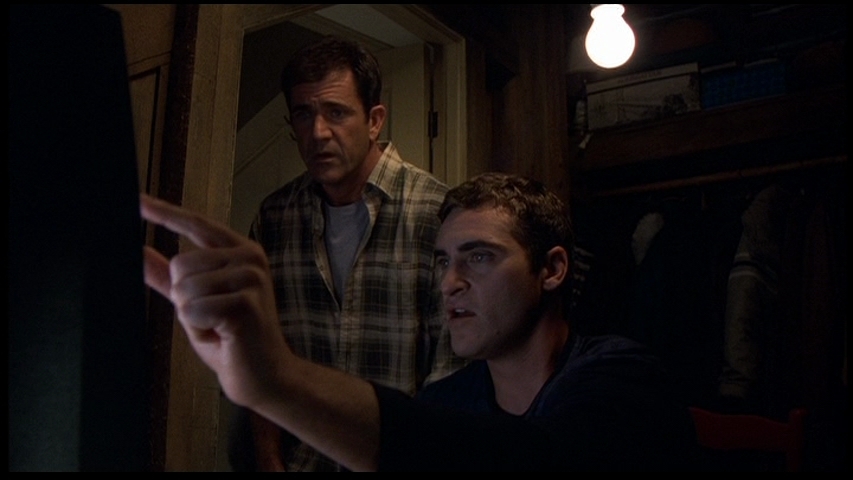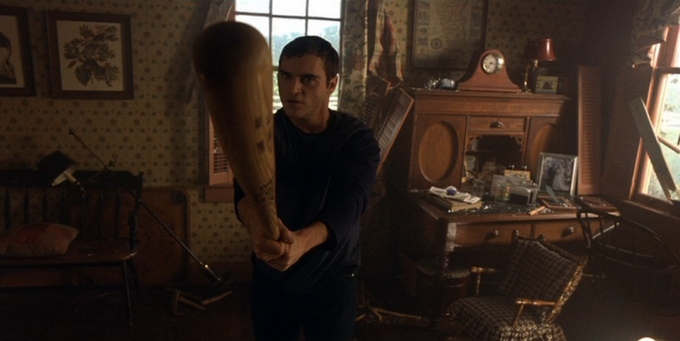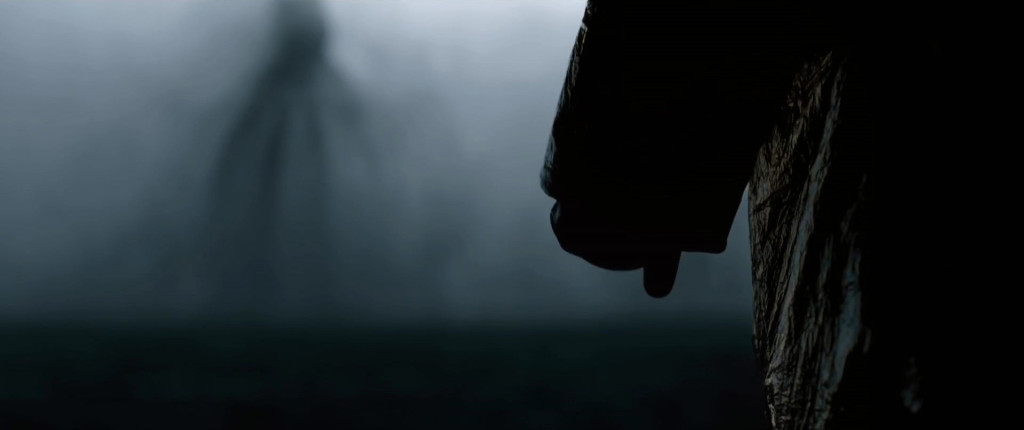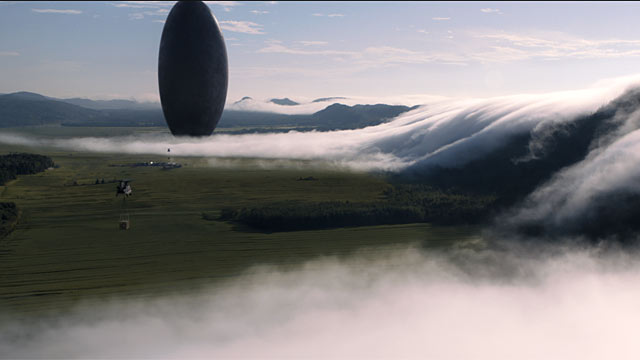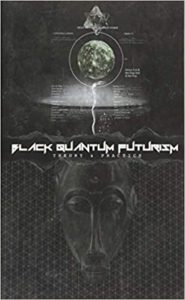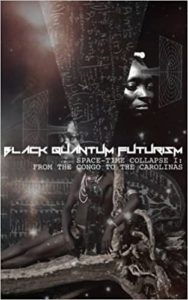The Nightshirt Sightings, Portents, Forebodings, Suspicions
Look Back in Amber: Dream Paleontology as a New Gnosis
We are four-dimensional beings. As I argue in my new book Time Loops, our behavior at any given moment is shaped not only by the exigencies of that moment and what has preceded it, but also by what comes next; we are informed by things we will learn in our future, not just by what we know from our past. It goes by many names: Teleology is an old one; syntropy is a newer idiom; retrocausation is what they call it in physics. Whatever you call it, it is a basic principle shown in the precognition and presentiment experiments of parapsychologists like Dean Radin and Daryl Bem. But those experiments, I believe, just show us the tip of the iceberg of how we—and all creatures—inhabit time.
The retrocausation paradigm in quantum physics, coupled with advances in quantum biology and other fields, is opening the door to thinking scientifically about teleological causation, not as some nifty little add-on to the basic billiard-ball nature of biology, but as possibly even the very foundation of biology. Scale up quantum retrocausation in a complex nervous system and you have what humans are gifted with: the ability to orient toward future rewards unconsciously, as well as the ability to be guided by information across our lifespan, both past and future. The really interesting thing is, because we don’t believe in it or understand how such a thing could be possible, we invariably misinterpret the perturbations caused by information refluxing from our future. Consequently, we shoehorn anomalous experiences into some easier-to-think conceptual mold like “synchronicity” or telepathy, or (more likely) disregard those experiences altogether.
Parapsychologists sometimes talk about precognition (and other claimed psi abilities) as the bleeding edge of human potential. I think of it more as human actual: It is not simply some new superpower that, once unlocked, will give us a new ability to shape our destinies. Whenever we act intuitively or creatively, paying attention to what gets glossed “the unconscious,” we are already in tune with our precognitive natures. We have always been precognitive. The unconscious, the source of our dreams and art as well as our neuroses, is simply consciousness displaced in time.
Likewise, the boons of precognitive dreamwork go way beyond using the “power of premonitions” to avert trouble or guide ourselves toward success. Again our intuition already does that—keep listening to it. Rather—and this was the biggest surprise for me over the past several years of working with my dreams in the manner J. W. Dunne recommended—the rewards are spiritual. Precognition is a new gnosis, a path of insight, one that connects us with our higher—although I prefer to say longer—Self.
Because precognition can only be confirmed in hindsight (and dreams can only be studied after they have been written down), precognitive dreamwork is, ironically, a retrospective, archaeological or even “paleontological” endeavor. It is a venturing into one’s own past, but in a way that, you will find, literally has a creative power to shape that past. It is a way to simultaneously find and make the shape of our biography.
As a kind of gnosis, precognition comes complete with its own ecstasies, its “highs,” its altered states, that are astonishing … and what’s more, almost completely unprecedented. With the exception of certain moments in Phil Dick’s Exegesis, I’m not aware of any spiritual writings describing what precognitive dreamwork has offered me on a few occasions: the utterly sublime and illusion-shattering experience of actually recognizing my own time-looping intervention in my timeline.
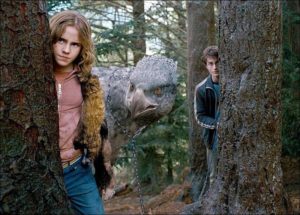 The best models for this experience are in SF and fantasy, where it is something of a staple. There is “Coop’s” attempt to contact his younger self via the tesseract in Interstellar, for instance, and the film Arrival, which I’ve discussed previously on this blog and also discuss in my book. Another vivid cinematic example I have been thinking about recently is the third Harry Potter film, Harry Potter and the Prisoner of Azkaban. I was not a huge Harry Potter fan, but Alfonso Cuaron handles time travel wonderfully in this film. Midway through, Hermione leads Harry several hours back in time using a “time turner” so they can rescue their slightly younger selves from a series of perils they had narrowly escaped in the first half of the movie. At each step of the way, they keep realizing that various anomalies they had experienced the night before (a rock hitting Harry in the head out of nowhere, a sound that distracted a werewolf pursuer, etc.) were themselves trying to get their own attention or otherwise save their own lives.
The best models for this experience are in SF and fantasy, where it is something of a staple. There is “Coop’s” attempt to contact his younger self via the tesseract in Interstellar, for instance, and the film Arrival, which I’ve discussed previously on this blog and also discuss in my book. Another vivid cinematic example I have been thinking about recently is the third Harry Potter film, Harry Potter and the Prisoner of Azkaban. I was not a huge Harry Potter fan, but Alfonso Cuaron handles time travel wonderfully in this film. Midway through, Hermione leads Harry several hours back in time using a “time turner” so they can rescue their slightly younger selves from a series of perils they had narrowly escaped in the first half of the movie. At each step of the way, they keep realizing that various anomalies they had experienced the night before (a rock hitting Harry in the head out of nowhere, a sound that distracted a werewolf pursuer, etc.) were themselves trying to get their own attention or otherwise save their own lives.
Dream journaling with an eye to precognition offers a real, literal time turner in which you can sometimes find yourself doing precisely this (albeit perhaps less dramatically than in Harry Potter): being a shaping presence in your own past. The reason is that the more attuned to dream precognition you become, the more you discover evidence of the phenomenon, and the more your amazement at these discoveries becomes included in your precognitive dreams. Your mature amazement becomes an influence in your life at an earlier point in time. I mean this quite literally.
The counterintuitive part, the “secret” if you will, is that that younger, naïve self is always unconscious; the dreamer does not, and by the laws of physics, cannot “know” what is going on, any more than the slightly younger Hermione and Harry know who is throwing rocks at their heads or rustling the bushes ahead of them. Sense—and again, a kind of vertiginous sublime epiphany—comes later, when the awake, conscious You goes back to the dream, in the form of your dream journal. The dream is not the time portal, the dream journal is. Its pages are the shale-like strata in which your most stunning paleontological discoveries are made. (This is why I keep telling you to keep a dream journal. Here, here’s a nice Amazon link to the particular journal I use for the purpose. You’re welcome.)
Let me illustrate the paleontological dream hermeneutic with a particularly striking example of mine from earlier this year.
Permian Battle
In late January, I wrote down a lucid dream that consisted of two parts. I’ll discuss the first later, but in the second part, my dream self was flying over a hillside, toward some large animals that seemed (from a distance) to be dinosaurs. This excited me greatly—I thought, how cool to visit a prehistoric landscape in a lucid dream! I was eager for a Jurassic Park-like experience. However, as I drew near, the creatures turned out not to be dinosaurs exactly but much more boring, squat, quadrupedal carnivores that I associated with some earlier period preceding the dinosaur era. The animal on my right in my dream was brown and vaguely dog-like, with a squarish head and saber-teeth; it was advancing on another creature, lumpy, squat, and black, more evil and reptilian-looking. They were about to clash in a fight, and landing between them, I had to intervene, holding the muzzles of both at arms’ reach as they tried to close on each other. Weirdly, there was a red dot, as from a laser pointer or laser gun-sight, fixed immovably on the body of the reptilian creature on my left, but I couldn’t turn my head to see what hunter was “targeting” it.
I jotted down notes on this in my notebook immediately on waking—it was probably around 6 AM—and then I wrote a couple paragraphs describing the dream in more detail in my electronic dream journal later that morning. The “fulfillment” of this dream came about 12 hours later, right after I checked my mail that evening.
 The previous fall, I had purchased a subscription to a magazine called Prehistoric Times—a sort of quarterly “fan” magazine about dinosaurs, dinosaur art, and dinosaur culture (toys, collectibles, etc.)—partly because I like showing dinosaur pictures to my small daughter, but also out of increasing personal nostalgia for my own dinosaur-saturated childhood. When I checked my mail, I was pleasantly surprised to find the new (Winter 2018) issue of Prehistoric Times, my first issue since subscribing. It contained a feature about therapsids. Therapsids (I quickly learned) were the vaguely dog- or cat-like proto-mammals of the Permian period, the period preceding the dinosaur-dominated Mesozoic era. (I remembered such animals dimly from my childhood, as the boring early land carnivores shown at the beginning of some dinosaur books, preceding the exciting Mesozoic animals every kid is really interested in.)
The previous fall, I had purchased a subscription to a magazine called Prehistoric Times—a sort of quarterly “fan” magazine about dinosaurs, dinosaur art, and dinosaur culture (toys, collectibles, etc.)—partly because I like showing dinosaur pictures to my small daughter, but also out of increasing personal nostalgia for my own dinosaur-saturated childhood. When I checked my mail, I was pleasantly surprised to find the new (Winter 2018) issue of Prehistoric Times, my first issue since subscribing. It contained a feature about therapsids. Therapsids (I quickly learned) were the vaguely dog- or cat-like proto-mammals of the Permian period, the period preceding the dinosaur-dominated Mesozoic era. (I remembered such animals dimly from my childhood, as the boring early land carnivores shown at the beginning of some dinosaur books, preceding the exciting Mesozoic animals every kid is really interested in.)
The painting on the first page of the article—the one at the top of this post—was unmistakeably and stunningly the scene from my dream: It showed, side by side, exactly the two creatures that had moved to attack each other and that I had struggled to keep apart. From the caption I learned that the evil reptilian-looking one on the left was a scutosaurus and the saber-toothed therapsid on the right was a sauroctonus. The feature was specifically on therapsid paintings by the Czech illustrator Zdenek Burian, an artist from the middle years of the century whom I already knew and liked, but this was not a picture I had ever remembered seeing, nor did any books in my collection contain pictures of these creatures. Not only the two animals in my dream, but also the dream setting was exactly like that Burian painting—sort of a low hillside.
I have recorded a couple hundred dreams that I have identified as seeming precognitive—I have written about a handful of them in previous posts on this blog—but this was probably the most crystal-clear example of dream precognition so far in my life. No amount of Freudian free-association was necessary to unpack the dream’s connection to the next day’s experience. There were no puns or other substitutions. I quite literally dreamed that picture, with the embellishment that I was in the scene, interacting with those two animals. The only odd detail not in the actual picture was the laser dot. But that dot turned out to be the key to the time loop.
 I initially scrutinized the various therapsid pictures in the magazine article, expecting maybe to find something like that dot, perhaps a printer’s blemish on one of the images. But all it took was a moment’s free-association to realize its significance: The first thing it reminded me of was the red dot of a laser gunsight on the forehead of Linda Hamilton in The Terminator, when Arnold Schwartzenegger first tries to assassinate her in a crowded bar. I hadn’t thought about that movie in years, yet what is that movie but a story about a hunter from the future traveling back in time to “target” someone in the past?
I initially scrutinized the various therapsid pictures in the magazine article, expecting maybe to find something like that dot, perhaps a printer’s blemish on one of the images. But all it took was a moment’s free-association to realize its significance: The first thing it reminded me of was the red dot of a laser gunsight on the forehead of Linda Hamilton in The Terminator, when Arnold Schwartzenegger first tries to assassinate her in a crowded bar. I hadn’t thought about that movie in years, yet what is that movie but a story about a hunter from the future traveling back in time to “target” someone in the past?
Recall that, in the dream, I couldn’t turn my head to see who was targeting this ancient creature. In fact, the out-of-sight hunter was me, about 12 hours ahead in my own timeline. The dream pre-presented my own retrospective scrutiny of these dream fauna from the point of view of amazedly, there on my living room couch, realizing that I myself was a time traveler, a hunter in my own past.* It was a dream pre-presentation of going back to the dream in hindsight.
Time Gimmickry
I have found, again and again, that dreams that turn out to have been precognitive often contain some representation of the act of returning to the dream to verify this fact. In other words, the precognitive nature of the dream is represented within the dream, like a fractal. “Time gimmicks” in dreams give the tip-off—elements having to do with time travel or “going back.” This includes rearview mirrors or juxtapositions of old and new. It only seems to happen, however, when the dream is recognized as precognitive at or near the time when the “confirming” event comes to pass, rather than at some time later. This is because dreams seem to be mnemonic (or pre-mnemonic) “bundles” binding experiences within a narrow window of time, usually an hour or two of waking life. If your realization that your dream was precognitive coincides with the experience being precognized, your realization will be included in the dream.
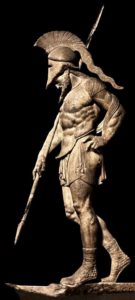 The above dream contained an additional time gimmick in addition to the laser dot. In an earlier part of that lucid dream, I had been zooming uncontrollably (I can never control my dream flight) through a vast enclosed cavern or gallery, like a vast subterranean hall, crowded with balconies that were densely packed with pale statues of ancient heroes—thousands of statues packed together on these balconies, almost like this enormous space had been converted into a storage facility for some huge trove of ancient marble statuary. I had a sense that some of the heroes were wearing helmets and light armor like ancient Greek or Roman warriors, but the only figure I remembered distinctly was an archer drawing back the string on his bow.
The above dream contained an additional time gimmick in addition to the laser dot. In an earlier part of that lucid dream, I had been zooming uncontrollably (I can never control my dream flight) through a vast enclosed cavern or gallery, like a vast subterranean hall, crowded with balconies that were densely packed with pale statues of ancient heroes—thousands of statues packed together on these balconies, almost like this enormous space had been converted into a storage facility for some huge trove of ancient marble statuary. I had a sense that some of the heroes were wearing helmets and light armor like ancient Greek or Roman warriors, but the only figure I remembered distinctly was an archer drawing back the string on his bow.
Given that the “Permian battle” scene was so clearly precognitive, I suspected this episode probably also pointed to the same magazine issue. I saw no obvious referent to such statuary later in the magazine (although the magazine did have several ads for superhero action figures). But when I flipped back to the beginning of the issue and paged through it a second time, I realized—with some amusement—that my “statues of ancient heroes” had a clear (but this time not literal) referent in the issue, on the pages immediately preceding the feature on therapsids. Since I hadn’t even been thinking about my dream at that point, I had simply missed it.
It was a feature with photos of a collector’s cramped dinosaur figurine collection, showing thousands of pale dinosaur models crammed together on shelves in a packed room of a house. I had not noticed the correspondence at first because my sublimely vast dream caverns were totally out of scale and proportion with this packed room, but the general sense was the same: “statues of ancient heroes” (many of them “lightly armored”) crammed together like in a multilayered storage facility. As I have described before, the exaggerated scale and importance of things in dreams often starkly contrast with the objective puniness or triviality of their precognitive or mnemonic referents in waking life.
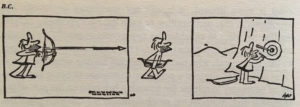 It occurred to me to free-associate on the “archer” among my dream statues, and I immediately thought of one of my favorite Dunne dream examples from the published literature, a minor case that I had written about for Chapter 8 of my book: A patient of the psychoanalyst-parapsychologist Jule Eisenbud related to him a dream about being unable to hit a target with an arrow, and the next morning his favorite comic strip B.C. by Johnny Hart showed a character drawing a target around an arrow he had shot into a wall (above). It’s not the most amazing Dunne dream as Dunne dreams go (or the most hilarious comic strip), and for various reasons, Eisenbud didn’t even count it as a true precognitive dream. But because of it, these days, archery and arrows represent for me the issues of causation and retrocausation that I have been immersed in for the past few years while writing my book. Substituting a dinosaur model in the next issue of Prehistoric Times with an ancient hero drawing back his bowstring was a time gimmick a lot like the laser dot on the scutosaurus, or an archery dream precognizing a B.C. comic strip on the same topic.
It occurred to me to free-associate on the “archer” among my dream statues, and I immediately thought of one of my favorite Dunne dream examples from the published literature, a minor case that I had written about for Chapter 8 of my book: A patient of the psychoanalyst-parapsychologist Jule Eisenbud related to him a dream about being unable to hit a target with an arrow, and the next morning his favorite comic strip B.C. by Johnny Hart showed a character drawing a target around an arrow he had shot into a wall (above). It’s not the most amazing Dunne dream as Dunne dreams go (or the most hilarious comic strip), and for various reasons, Eisenbud didn’t even count it as a true precognitive dream. But because of it, these days, archery and arrows represent for me the issues of causation and retrocausation that I have been immersed in for the past few years while writing my book. Substituting a dinosaur model in the next issue of Prehistoric Times with an ancient hero drawing back his bowstring was a time gimmick a lot like the laser dot on the scutosaurus, or an archery dream precognizing a B.C. comic strip on the same topic.
I can’t emphasize enough: Discovering a past dream representation of yourself “looking back” at the dream later is a sublime, awe-inspiring experience. For me, it is the most powerful validation of precognitive dream interpretation as a gnosis: The knower is literally included in the known. It is also a startling confirmation of what Hermann Minkowski and Albert Einstein argued about the solid, block-like nature of spacetime: The past is still here, and the future is already here, we just usually lack eyes to see it. Again, such representations will be noticed more and more, the more you become attuned to precognitive dreaming.
O Attic Shape!
It can’t be stressed enough that a precognitive dream is not about “the future.” It is about a future experience in one’s life. But more than that, it is about the thoughts, feelings, and associations that will be provoked by that experience. This goes a long way toward explaining the interesting ways dreams deviate from the real-life experiences that precognitively catalyze them.
It is unusual in my experience for a dream image or scene to so literally pre-present a real scene or stimulus in my life as the “Permian battle” in my dream did. More often, dreams distort things in the manner of the “ancient heroes” in the subterranean gallery. They did not look like dinosaurs in the dream; the sense of them came through the verbal/symbolic register, a transposition that made sense only when the visual image (Greco-Roman military statuary) was translated into words: statues of ancient heroes. (Remember, it was reconnecting with the “heroes” of my childhood, dinosaurs, that prompted me to subscribe to Prehistoric Times in the first place.) This transposition into ancient human heroes facilitated the link to archery and the B.C. dream of Eisenbud’s patient, and via that to many associations from my book.
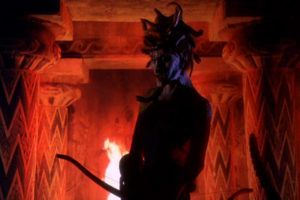 It connected, for instance, to the theme of Minkowski spacetime, where the past still exists. A vast (i.e., cosmic) storehouse packed with memorials, beings frozen in time, is a dream-representation of an idea that naturally comes to mind when I discover a dream was precognitive: a sense of awe at the “still-here-ness” of the past and the “already-here-ness” of the future. Among my other associations to the subterranean gallery full of marble ancient heroes was the confrontation between Perseus and Medusa in the original Clash of the Titans: Ray Harryhausen’s awesome animated Medusa slithers through her subterranean temple full of “statues,” which are really warriors that had been turned to stone by the Titan-archer’s terrible gaze.
It connected, for instance, to the theme of Minkowski spacetime, where the past still exists. A vast (i.e., cosmic) storehouse packed with memorials, beings frozen in time, is a dream-representation of an idea that naturally comes to mind when I discover a dream was precognitive: a sense of awe at the “still-here-ness” of the past and the “already-here-ness” of the future. Among my other associations to the subterranean gallery full of marble ancient heroes was the confrontation between Perseus and Medusa in the original Clash of the Titans: Ray Harryhausen’s awesome animated Medusa slithers through her subterranean temple full of “statues,” which are really warriors that had been turned to stone by the Titan-archer’s terrible gaze.
And I also thought of Keats’ “Ode on a Grecian Urn,” a poetic image expressing the same basic idea, of stasis and eternity and permanence. When I looked up Keats’s poem, I found that “marble men” is an explicit image in its last stanza.
O Attic shape! Fair attitude! with brede
Of marble men and maidens overwrought,
With forest branches and the trodden weed;
Thou, silent form, dost tease us out of thought
As doth eternity: Cold Pastoral!
When old age shall this generation waste,
Thou shalt remain, in midst of other woe
Than ours, a friend to man, to whom thou say’st,
“Beauty is truth, truth beauty,—that is all
Ye know on earth, and all ye need to know.”
Butch and Sundance
Eisenbud pointed out that his patient’s dream-choice of a B.C. comic for its precognitive target was itself a significant part of its meaning. I have found that precognition “likes” future stimuli having to do with juxtapositions of time. My two-part lucid dream about a dinosaur magazine is an obvious example. In early 2017, I wrote down the following dream that also exemplified the same principle:
Dream about Butch Cassidy and the Sundance Kid—a long introduction to the movie that I had not seen before, in which Butch and Sundance are reunited at Union Station in Denver and warmly embrace, Sundance tells Butch he missed him, and then they kiss. The dream shifted and they were lying together in an MRI or CT scan tube, and I was a bit surprised that they had that technology back then. On a countertop were some modern medical supplies and some sort of salve or ointment from CVS.
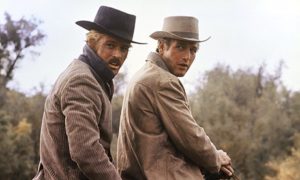 My natural thought when I dream of a celebrity (or their character) is that they may have died; I have never once been right in this assumption, yet on a few occasions my research has turned up something else even more interesting. On the day after I had this dream, I did a Google search on Robert Redford, worrying that perhaps he had passed away and thus been “reunited” with his co-star Paul Newman. Instead, Google led me straight to an article about Redford’s warm, real-life friendship with Newman—something I may have been dimly aware of years ago but certainly had no reason to be thinking of at this point in my life. Among other things, Redford was quoted as saying how much he missed Newman. That article, however, led to an even more interesting Esquire piece about Redford’s career and his early, unfair treatment by the critic Pauline Kael. There, I came across a striking passage about Kael’s “savaging of The Sting, the reunion of Redford and Newman and [director] George Roy Hill.” Kael’s review of the movie is quoted in the very next sentence: “I would much rather see a picture about two homosexual men in love than see two romantic actors going through a routine whose point is that they’re so adorably, smiley butch that they can pretend to be in love and it’s all innocent.”
My natural thought when I dream of a celebrity (or their character) is that they may have died; I have never once been right in this assumption, yet on a few occasions my research has turned up something else even more interesting. On the day after I had this dream, I did a Google search on Robert Redford, worrying that perhaps he had passed away and thus been “reunited” with his co-star Paul Newman. Instead, Google led me straight to an article about Redford’s warm, real-life friendship with Newman—something I may have been dimly aware of years ago but certainly had no reason to be thinking of at this point in my life. Among other things, Redford was quoted as saying how much he missed Newman. That article, however, led to an even more interesting Esquire piece about Redford’s career and his early, unfair treatment by the critic Pauline Kael. There, I came across a striking passage about Kael’s “savaging of The Sting, the reunion of Redford and Newman and [director] George Roy Hill.” Kael’s review of the movie is quoted in the very next sentence: “I would much rather see a picture about two homosexual men in love than see two romantic actors going through a routine whose point is that they’re so adorably, smiley butch that they can pretend to be in love and it’s all innocent.”
My dream seemed to have been pre-inspired by this passage suggesting a homoerotic “reunion” of Butch and Sundance.** Per standard dream overdetermination, the dream doubly represented the idea of a reunion by setting the dream kiss of Butch and Sundance at “Union Station,” a place familiar from my childhood. The CVS ointment or salve on the counter points associatively to the idea of an insect bite or sting. My dreaming brain’s placing of these characters in a modern CT scanner (and feeling “surprised they had the technology back then”) was another time gimmick, pre-presenting my own internet scrutiny of Redford and Newman’s relationship after the dream, and my dreaming brain’s confused juxtaposition of the computer-mediated nature of that “scan” and the sepia-toned setting of those period movies starring the real-life actor buddies.
In other words, the anachronism of Butch Cassidy and the Sundance Kid itself—a distinctly modern-feeling buddy comedy (with late-1960s Burt Bacharach score, etc.) set the better part of a century earlier (and I might add, one of my all time favorite films)—was itself folded into its precognitive significance. Anachronisms of one sort or another act as “attractors” for the precognitive brain.
Postscript: All Ye Need to Know
Another magazine I subscribe to, and also avidly read (although not to my two-year-old), is New Scientist. In a recent (July 14-20, 2018) issue, one of its editors, Rowan Hooper, penned a “Field Notes” piece about his visit to the 35th annual International Dream Conference in Phoenix. He visited the “interdisciplinary” (his scare quotes) conference to learn about the latest in scientific psychology and neuroscience of dreaming but found himself in a disturbingly mixed (one might even say interdisciplinary) group that included New Agers, psychoanalysts, and (shudder) parapsychologists expressing a profoundly distressing panoply of beliefs about dreams—such as that they may foretell future events. Having lunch with a psychoanalyst who believes dreams can be precognitive, he writes, he nearly choked on his burrito. Many people at that meeting, he lamented, expressed their belief in precognitive dreams.
“Our fascination with dreams goes back millennia, with many ancient cultures believing they carried messages from spirits or spoke to us of the future,” Hooper writes. “How sad that thousands of years later, we are still bogged down in such mysticism, when we could instead be probing what truly generates dreams, and what they tell us about consciousness and how our brains work.”
In other words, despite the famous mystery, even to scientists, of dreams and dreaming, this editor clearly went in “knowing all he needed to know” about dreams: they’re not “mystical”; they don’t speak of the future, etc. He wanted to see a homogeneous set of scientists upholding that narrowly materialistic (in the bad sense) viewpoint. “Call me naïve,” Hooper writes, “but it was a shame to find an ‘us versus them’ attitude among the non-scientists.” The psychoanalyst he had lunch with would call that projection, since Hooper himself clearly took such an attitude toward those non- or para-scientific ‘others’ and their “mumbo jumbo.” Who is the “us” and who the “them,” exactly?
Lest any New Scientist readers be on the fence about the possibilities of precognitive dreaming, Hooper provides the standard explaining-away: “No matter that with so many people dreaming each night, this is quite likely to happen by chance.” But the law of large numbers argument skeptics like Hooper always rest their cases on depends on the phenomenon in question happening rarely. In fact, those who have followed in the footsteps of J. W. Dunne and investigated their own dreams for evidence of precognitive material often come away with substantial evidence that precognitive dreams are the norm. When people can show from their own dream databases that precognitive dreams are common, even nightly occurrences (see for instance Bruce Siegel’s excellent Dreaming the Future, or Andrew Paquette’s Dreamer), then the law of large numbers argument flies straight out the window.
Lots of alleged precognitive dreams, because their relationship to a putative target consists of highly personal associations, understandably hold little weight with skeptics, who are as hostile to psychoanalytic premises as they are to parapsychological ones. If I were to relate the “statues of ancient heroes” dream episode to someone like Hooper and show him the magazine spread I alleged it precognized, he would no doubt roll his eyes. I wouldn’t really blame him. And if I related a dream like the one about Butch and Sundance, he would quite reasonably counter that if I looked long and hard enough in an Internet search about any famous person, I would eventually find some piece of text that might seem to match my dream. Fair enough. (It’s sort of the “put 20 monkeys in a room with typewriters and you’ll eventually get Hamlet” principle.)
But if I really wanted to make Hooper choke on his burrito, I would relate the “Permian battle” dream and ask how coincidence could in any way, shape, or form explain its exact correspondence to a picture in a magazine I received in the mail the next day.
 Despite my love of prehistoric animals, I never dream about them. I have on a few occasions in roughly a quarter century of keeping an electronic dream diary dreamed about trilobite-like, vaguely prehistoric sea invertebrates; and dinosaur-related books or films have appeared in a few dreams in my journals, but the number of times dinosaurs, dinosaur fossils, or similarly charismatic extinct creatures have appeared in my dreams can be counted on the fingers of one hand. And I have never in my life dreamed about Permian fauna. Again, this is in 25 years of (mostly faithfully) recording my dreams.
Despite my love of prehistoric animals, I never dream about them. I have on a few occasions in roughly a quarter century of keeping an electronic dream diary dreamed about trilobite-like, vaguely prehistoric sea invertebrates; and dinosaur-related books or films have appeared in a few dreams in my journals, but the number of times dinosaurs, dinosaur fossils, or similarly charismatic extinct creatures have appeared in my dreams can be counted on the fingers of one hand. And I have never in my life dreamed about Permian fauna. Again, this is in 25 years of (mostly faithfully) recording my dreams.
I knew practically nothing about Permian land carnivores before this dream; I did not know what they were called; and I did not know they were going to be featured in the Winter 2018 issue of Prehistoric Times. The previous issue of the magazine (I quickly verified) contained no “In the Next Issue …” teaser—not that I would have known what “therapsids” referred to in any case. I had basically forgotten about my subscription by the time this issue arrived, so its arrival was a total surprise. There is simply no way my dream about a scutosaurus fighting with a sauroctonus on the morning before getting the magazine featuring these obscure creatures was coincidental. And the fact that I wrote the dream down beforehand rules out retroactive memory distortion. More to the point, though, the correspondence, even if it was uniquely vivid, fits a very common, widely replicated pattern, undercutting the notion that it must be seen as a rare one-off (and thus “likely to happen by chance”).
Debates between psi-believers and skeptics are a lot like Keats’ Grecian Urn: Attic figures frozen in time, locked in an eternal dispute that goes nowhere. Meaning-centered phenomena resist purely scientific approaches, and this has put the study of dreams (like the study of psi) at an impasse for decades. Ever wonder why every popular science piece proclaiming the answer to why we dream (“it’s nocturnal therapy,” “it prepares us for threats,” and so on) sounds vaguely unconvincing and then is replaced by a completely new answer a few months later? It’s an argument why the humanities need to be brought into the dialogue with sleep scientists, to move things forward. That’s right, interdisciplinarity, one of the things I make a case for in my book.
The “extraordinary claims require extraordinary evidence” thing, also, needs to be re-thought. It is really just a paradigm buttress, and an excuse to avoid dealing with threatening data, by moving the goalposts. No one with access to research dollars is going to jeopardize their career by studying the question of dream precognition in a way that might produce “extraordinary” evidence. This effectively exiles the whole topic to the disreputable zone of anecdote or, at best, small studies in parapsychology journals that mainstream scientists readily ignore. Hooper writes that his head was in his hands by the end of a keynote address by Stanley Krippner, who conducted what are still the best-known dream-ESP studies a half century ago; but they were tiny studies and thus hold zero scientific weight in the world of big-budget science Hooper is used to.
Around the question of precognition and precognitive dreams, I think “extraordinary claims” should be turned around: What is really so extraordinary about dreams providing a glimpse of the future? Could the fact that people for thousands of years have believed, even assumed, this was the case be a clue worth at least taking seriously? Collective skepticism around precognition can be shown to be rooted in historical-social convention and taboo, not reason or even evidence. Physics allows information to reflux from the future. Quantum computers can scramble causal order (as you can even read in New Scientist), and a kind of computation across time may even be what gives them their power. And guess what pinkish-gray squishy organ is increasingly thought, by serious scientists, to be a quantum computer?
Once the larger paradigms (in physics and biology) shift, psychology and other fields will eventually be forced to follow. Rather than further belaboring the case for precognition to anxious, cognitive-dissonance-fearing audiences who won’t listen anyway, I think our time is best spent working out its mechanisms and its implications … as I do in Time Loops (available from an internet mega-retailer near you).
NOTES
* Not accidentally, a literary example that was also fresh in my mind at that point, because of my book, was the story “A Sound of Thunder,” by Ray Bradbury. It is about time-traveling hunters who travel to the Cretaceous period to bag a T-Rex but find upon their return that one of them had, by stepping off an assigned path, crushed a butterfly in the distant past, and thereby altered the course of history.
** Another common experience in the precognitive-dreamwork path is doing research in a book or online, spurred by a dream, and coming across a piece of text or a picture that is clearly the precognitive “source” of the dream. Phil Dick recorded several examples of this time-looping logic in his letters, for instance, and the dream about Butch and Sundance is just one of several examples of this phenomenon in my own experience.
Time Loop at Hanging Rock
Valentine’s Day, 1900. A group of Australian schoolgirls, all clad in white dresses, are driven by coach to Hanging Rock, an enormous volcanic formation in central Victoria, Australia, for an afternoon picnic. Four girls, including the most popular, Botticelli Venus-looking Miranda (played by Anne-Louise Lambert), defying the orders of the school’s stern headmistress, venture off from the group, ascending through a maze of crevices in a kind of dreamy reverie; later, one girl, Edith—the least pleasant of the lot—reappears, disheveled and upset. The rest have seemingly vanished into thin air—along with the school math teacher, Mrs. McCraw, who had followed after them.
Thus begins Peter Weir’s debut masterpiece Picnic at Hanging Rock, one of the many gems of mid-1970s cinema (and recently remade as a 6-part Amazon miniseries, which I have not seen). I have always had good memories of Weir’s 1975 film from seeing it on television when I was young, and even vaguely thought of it as a “paranormal” movie, although without remembering quite why. When I watched it recently for the first time in probably two decades, I was again stunned at its beauty, and like many viewers I was gripped by the mystery that is presented as somehow, vaguely, a “true story.” A visit to Google immediately after the credits rolled revealed a much more complex and ambiguous reality. It turned into a month of gathering and reading everything I could about the source novel and its author, Joan Lindsay.
 There are so many fascinating wrinkles to the story that it is hard to know where to begin. First, if you have never seen the film, do yourself a favor and watch it. With its gorgeous cast and costumes and scenery and a Georghe Zamfir pan-flute melody that will be stuck in your head for days, it is brilliant from start to finish. But no spoiler warnings are really necessary, because none of the questions raised in the first 30 minutes of the film are answered by the end. The mysteries only deepen as the remaining schoolgirls and their teachers and headmistress—as well as two young men who were the last to see the girls ascending the rock—attempt to unravel the mystery and deal with the consequences of the girls’ disappearance.
There are so many fascinating wrinkles to the story that it is hard to know where to begin. First, if you have never seen the film, do yourself a favor and watch it. With its gorgeous cast and costumes and scenery and a Georghe Zamfir pan-flute melody that will be stuck in your head for days, it is brilliant from start to finish. But no spoiler warnings are really necessary, because none of the questions raised in the first 30 minutes of the film are answered by the end. The mysteries only deepen as the remaining schoolgirls and their teachers and headmistress—as well as two young men who were the last to see the girls ascending the rock—attempt to unravel the mystery and deal with the consequences of the girls’ disappearance.
We never find out what happened to the girls, and there are only subtle hints of anything paranormal in the film, or even in the book, unless you are paying close attention. The paranormal is mainly in the backstory of the author, the unusual circumstances of the writing of her 1967 novel, and especially in what was excised from the text prior to publication. Lindsay’s novel turns out to be a kind of “fractal” representation of the paranormal and its fate in our culture: to be “disappeared,” just like the alluring, disobedient schoolgirls.
Time Without Clocks
The 70-year-old Joan Lindsay wrote her novel, which quickly became a classic of Australian fiction, over the course of a mere week in 1966, after a series of obsessive dreams. The whole novel came to her in these dreams, and it did have at least one obvious autobiographical component. Appleyard College in the novel was clearly based on a real private girls’ boarding school, the Clyde School in Mt. Macedon, near Hanging Rock, which she had attended as a young woman in the late 19-teens. She prefaced her novel with the words “Whether Picnic at Hanging Rock is fact or fiction, my readers must decide for themselves. As the fateful picnic took place in the year nineteen hundred, and all the characters who appear in this book are long since dead, it hardly seems important.”
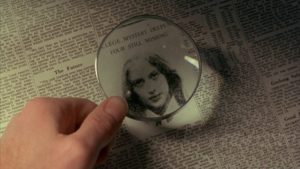 Well, you could not ask for a more powerful invitation to discover the “truth” behind the mystery. And there is nothing like the mysterious disappearance/death of beautiful young women to fire the imagination. Just ask David Lynch. The novel, with the help of Weir’s film, which the author fully endorsed, cast a spell on a nation. Especially after the film was released in 1975, Australian fans obsessively scoured newspapers from the period for reports of missing schoolgirls at Hanging Rock—in vain. One critic, Yvonne Rousseau, compiled various theories of the girls’ disappearance in her 1988 book The Murders at Hanging Rock.
Well, you could not ask for a more powerful invitation to discover the “truth” behind the mystery. And there is nothing like the mysterious disappearance/death of beautiful young women to fire the imagination. Just ask David Lynch. The novel, with the help of Weir’s film, which the author fully endorsed, cast a spell on a nation. Especially after the film was released in 1975, Australian fans obsessively scoured newspapers from the period for reports of missing schoolgirls at Hanging Rock—in vain. One critic, Yvonne Rousseau, compiled various theories of the girls’ disappearance in her 1988 book The Murders at Hanging Rock.
In reality, Hanging Rock had been a pretty dangerous place in the late 1800s. People sometimes did go missing. Prospectors returning to Melbourne from nearby gold fields were sometimes robbed and murdered there. According to a 1975 documentary about the film, a nearby town has a monument to three children who went missing sometime in the late 1800s. The Rock also was “haunted” by Australia’s colonial history and the murder of indigenous peoples, for whom the site was regarded as sacred. Visitors still regard it as a spooky, mysterious place.
Another clear influence on Lindsay’s novel was a painting that had hung in the office of her husband, Sir Daryl Lindsay, a famous Australian painter and director of the Australian National Gallery. At the Hanging Rock (below) by William Ford shows a group of Victorian picnickers under the looming formation, in what could almost be a promotional still for Weir’s film.
But a few astute readers and friends of Joan Lindsay had all along suggested that there was something else going on with the novel, and that it had to do with the author’s unusual beliefs about time. At the beginning of the story (and the film) the visitors’ watches all are found to have stopped in the vicinity of the rock. And there is an odd, easily overlooked but telling detail early in the novel when the girls who have left the group gaze down on the valley below and muse philosophically on human purpose, almost like aliens surveying people from some Archimedean vantage point; one of the girls then hears a sound like drums:
The plain below was just visible; infinitely vague and distant. Peering down between the boulders Irma could see the glint of water and tiny figures coming and going through drifts of rosy smoke, or mist. ‘Whatever can those people be doing down there like a lot of ants?’ Marion looked out over her shoulder. ‘A surprising number of human beings are without purpose. Although it’s probable, of course, that they are performing some necessary function unknown to themselves.’ … The ants and their business dismissed without further comment. Although Irma was aware, for a little while, of a rather curious sound coming up from the plain. Like the beating of far-off drums.
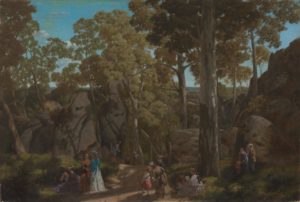 Readers who are paying attention note that a search party several hours later bangs on sheets of tin to try and signal to the missing girls. “No wonder the bloodhounds lose the trail,” Lindsay’s journalist friend Phillip Adams remarked in a newspaper column, “For the girls aren’t lost on the rock. Like Alices stepping through the looking glass, they’re moving into another dimension.” A week later, the girl who heard the drums, Irma, is found high on the rock asleep, unharmed except for a few scratches, but with no memory of what became of her friends or their math teacher.
Readers who are paying attention note that a search party several hours later bangs on sheets of tin to try and signal to the missing girls. “No wonder the bloodhounds lose the trail,” Lindsay’s journalist friend Phillip Adams remarked in a newspaper column, “For the girls aren’t lost on the rock. Like Alices stepping through the looking glass, they’re moving into another dimension.” A week later, the girl who heard the drums, Irma, is found high on the rock asleep, unharmed except for a few scratches, but with no memory of what became of her friends or their math teacher.
Lindsay in real life claimed that clocks would not function near her, and friends confirmed that their watches would stop in her presence. In her memoir Time Without Clocks, she described her own hatred of the clock-bound life most people lead. There were few clocks at Mulberry Hill, the Lindsays’ home in Victoria. She didn’t even know her own birth date until she asked another journalist friend, Terence O’Neill, to help her research it. In his own confusion of chronology, Adams described that “Long before Einstein revealed his relativity theory, in which time ceases to be something solid and dependable and becomes elastic, Joan believed that it was somehow dreamlike, that yesterday is still with us while tomorrow is already here.” In reality, Joan was still a little girl when Einstein formulated his theory—but what’s a little time warp between friends?
The Missing Chapter
The more readers pressed Lindsay for details about her inspiration, the more she clammed up—and even complained at how people kept showing up uninvited at Mulberry Hill, to get answers. Yet her various coy allusions to a true story, and to real people concealed in her novel, kept readers digging.* Amid all the speculation by readers, there were rumors of a final chapter that had been cut from the novel prior to publication, which contained the answer to the mystery.
The rumors proved … entirely true. Although the “explanation” the missing chapter provided is one that few readers could understand, let alone accept. The missing “Chapter 18,” published in 1987 as The Secret of Hanging Rock (along with a couple critical commentaries), is one of the most fascinating and beautiful pieces of “paranormal fiction” I have ever read. And the story of how it came to be excised from the novel is just as interesting, and telling.
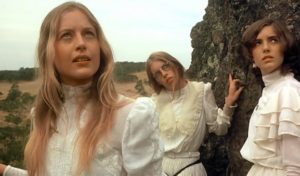 The novel as published chronicles various upheavals in the community following the girls’ disappearance. These include the re-exploration of the rock by the two young men who had last seen the girls, the recovery of Irma, the suicide of one of the other students (who the film suggests had been in love with the missing Miranda), and the descent into drink and finally suicide of the headmistress Mrs. Appleyard (played by Rachel Roberts in the movie), after several parents withdraw their daughters and their money from her school. The missing Chapter 18 does indeed return us to the Rock and to “what happened,” but it is nothing that would fit within the usual coordinates of a romantic mystery novel.
The novel as published chronicles various upheavals in the community following the girls’ disappearance. These include the re-exploration of the rock by the two young men who had last seen the girls, the recovery of Irma, the suicide of one of the other students (who the film suggests had been in love with the missing Miranda), and the descent into drink and finally suicide of the headmistress Mrs. Appleyard (played by Rachel Roberts in the movie), after several parents withdraw their daughters and their money from her school. The missing Chapter 18 does indeed return us to the Rock and to “what happened,” but it is nothing that would fit within the usual coordinates of a romantic mystery novel.
The trio of girls—the otherworldly beauty Miranda, the intellectual Marion (who gazed down on the picnickers like at ants), and the wealthy Irma—are on a high ledge, drawn toward a stone monolith that exerts a kind of spiral magnetic force, “pulling, like a tide.” Beyond it, the girls fall asleep briefly and then encounter a “clown-like figure” dressed only in her undergarments and boots—clearly the math teacher, Mrs. McCraw, whom Edith later recalled with embarrassment seeing coming up the hill in only her underwear while she was running down it. Yet the girls don’t recognize the woman—they are already in a dream-like state where reality has been transfigured.
Marion then gets the idea they should all discard their restricting corsets, which they toss off a precipice, only to see them hanging motionless in mid-air. The math teacher/stranger says “they are stuck fast in time,” at which one of the girls tells her “when you said that about time I had such a funny feeling I had met you somewhere. A long time ago.” The older woman replies, “Anything is possible, unless it is proved impossible. And sometimes even then.” She then asks for the girls’ names, even though she should know them, and notes she has forgotten her own name: Waving toward a bush, she says “I have apparently left my own particular label somewhere over there.”
It is a “trippy” exchange—indeed, like a group of people under the influence of a powerful hallucinogen. And it gets stranger. When the brainy Marion suggests they keep moving before the sun sets, the older woman utters further perplexities:
“For a person of your intelligence—I can see your brain quite distinctly—you are not very observant. Since there are no shadows here, the light too is unchanging.”
Irma was looking worried. “I don’t understand. Please, does that mean that if there are caves, they are filled with light or darkness? I am terrified of bats.”
Miranda was radiant. “Irma, darling—don’t you see? It means we arrive in the light!”
“Arrive? But Miranda … where are we going?”
“The girl Miranda is correct. I can see her heart, and it is full of understanding. Every living creature is due to arrive somewhere. …”
Which is when they see a hole open up before them:
It wasn’t a hole in the rocks, nor a hole in the ground. It was a hole in space. About the size of a fully rounded summer moon, coming and going. She saw it as painters and sculptors saw a hole, as a thing in itself, giving shape and significance to other shapes. As a presence, not an absence—a concrete affirmation of truth. She felt that she could go on looking at it forever in wonder and delight, from above, from below, from the other side. It was a solid as the globe, as transparent as an air bubble. An opening, easily passed through, and yet not concave at all.
The “hole in space” fades out, after which they observe a snake descend down a physical hole below some boulders. The woman formerly known as Mrs. McCraw then confidently decides to lead the girls into the hole. She wriggles into it, undergoing a kind of transformation as she does so (“The thin arms, crossed behind the head with its bright staring eyes, became the pincers of a giant crab”)—followed by Marion and Miranda in turn. Then to Irma’s horror another boulder falls on the hole, sealing it off.
Irma had flung herself down on the rocks and was tearing and beating at the gritty face of the boulder with her bare hands. She had always been clever at embroidery. They were pretty little hands, soft and white.
So that is how Joan Lindsay originally ended her novel: with Hanging Rock itself devouring the girls and their teacher. In contrast to the matter-of-fact tone of the rest of the book, it is more like something out of Carlos Castaneda—or indeed, Lewis Carroll. As Yvonne Rousseau wrote in her commentary to this chapter, it also bears close rereading. Among other things, there is something punnily akin to dream in these strange events: Mrs. McCraw’s crab-transformation is into a kind of claw; the corsets that hang in midair were colloquially called “stays,” and stay in spacetime is what they do. It is a stunning vision of the Minkowski block universe.
Lindsay’s Time Slip
It is certainly significant that Lindsay had experienced at least one “time slip,” which made such an impression that she related the story to several friends. Probably in 1929, her husband Daryl had been driving her to another town, Creswick, to visit his mother, and on the way Joan saw something strange. One friend, John Taylor, recalled her story in his commentary to the missing chapter: “half a dozen nuns were running frantically across a field and climbing a fence. Her husband saw nothing. Puzzled, she asked her mother-in-law if there was a convent in the area. There had been, she was told, but it had burned down years earlier.”
Lindsay’s time slip in 1929 undoubtedly was a significant influence on her beliefs about time, but so was another, more famous time slip that dated to the same period her novel was set in. She confided to her friend Adam Phillips that her writing of Picnic had been very influenced by the book An Adventure, first published anonymously in 1911 by a pair of English academics, later revealed as Charlotte Anne Moberly and Eleanor Jourdain, about an alleged shared time-slip experience while wandering the gardens of Versailles in 1901: The women reported seeing a number of people in anachronistic dress that they later determined must have been the ghosts of Marie Antoinette and her courtiers circa 1789, just before their deaths in the French Revolution.
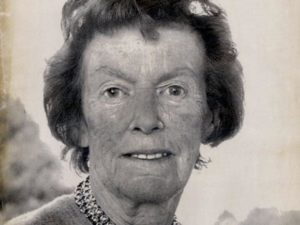 Although it is the most famous time slip, Moberly and Jourdain’s account has also proven to be one of the least persuasive to critics. One critic chalked it up to costume parties an aristocrat was known to throw on the grounds; another, Lucille Iremonger, attributed it to a lesbian folie-a-deux between the two women (because lesbians, of course, are always hallucinating). The real problem is that weeks had elapsed after the women’s visit before they even conferred on what they had seen, and both seem to have experienced different things. There is no telling how much their memories of their first visit may have been shaped by the decade of research delving into the history of the Trianon garden and Versailles as well as their subsequent visits to the gardens, or how much their memories influenced each other. If there was a real time slip, it may have just been just one of them who experienced it, the other having adjusted her memory to conform with the notion of “something strange” occurring. At this point, there is no telling.
Although it is the most famous time slip, Moberly and Jourdain’s account has also proven to be one of the least persuasive to critics. One critic chalked it up to costume parties an aristocrat was known to throw on the grounds; another, Lucille Iremonger, attributed it to a lesbian folie-a-deux between the two women (because lesbians, of course, are always hallucinating). The real problem is that weeks had elapsed after the women’s visit before they even conferred on what they had seen, and both seem to have experienced different things. There is no telling how much their memories of their first visit may have been shaped by the decade of research delving into the history of the Trianon garden and Versailles as well as their subsequent visits to the gardens, or how much their memories influenced each other. If there was a real time slip, it may have just been just one of them who experienced it, the other having adjusted her memory to conform with the notion of “something strange” occurring. At this point, there is no telling.
Still, it made for an interesting book—one that was influential on many writers, including J.R.R. Tolkien (as Verlyn Flieger discusses in her book A Question of Time). But I think even more importantly, the edition that Lindsay is likely to have read, which was published in 1931, also included an introductory note by J.W. Dunne, the aeronautical engineer and precognitive dreamer whose 1927 book An Experiment with Time is probably the most important book ever written on the subject of precognition and its relation to the Einsteinian time-elastic universe. He writes that he was asked to comment on the scientific plausibility of the women’s account, and states that “if Einstein is right, the contents of time are just as ‘real’ as the contents of space. Marie Antoinette—body and brain—is sitting in the Trianon garden now.” More than anything in Moberly and Jourdain’s text, it is that line from Dunne’s note that surely exerted its effect on Lindsay when opening her Chapter 18:
It is happening now. As it has been happening ever since Edith Horton ran stumbling and screaming towards the plain. As it will go on happening until the end of time. The scene is never varied by so much as the falling of a leaf or the flight of a bird. To the four people on the Rock it is always acted out in the tepid twilight of a present without a past. Their joys and agonies are forever new.
“An Uncomfortable Style”
You will be right to ask about Chapter 18’s authenticity: A “missing chapter” to a nationally beloved novel turning up shortly after the death of the author should always be suspect. However, in this case, there does not seem to be any question of the text being a forgery, as there are living witnesses to the original manuscript with the chapter in place.
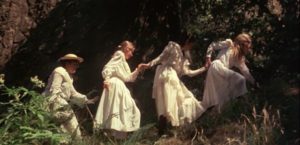 When Lindsay originally submitted her novel to her friend, publisher Andrew Fabinyi, he was enthusiastic; but he assigned it to a junior editor, Sandra Forbes, who felt uncomfortable about the ending. As described by Janelle McCulloch in her recent book Beyond the Rock, Forbes wrote in a letter to Lindsay: “I’m very doubtful about the last chapter. On the whole, would prefer to omit it altogether.” In an interview with McCulloch, Forbes asserted that the decision to cut the chapter had been agreed on by the author: “We all discussed it and it seemed the right thing to do.”
When Lindsay originally submitted her novel to her friend, publisher Andrew Fabinyi, he was enthusiastic; but he assigned it to a junior editor, Sandra Forbes, who felt uncomfortable about the ending. As described by Janelle McCulloch in her recent book Beyond the Rock, Forbes wrote in a letter to Lindsay: “I’m very doubtful about the last chapter. On the whole, would prefer to omit it altogether.” In an interview with McCulloch, Forbes asserted that the decision to cut the chapter had been agreed on by the author: “We all discussed it and it seemed the right thing to do.”
It is hard to know how to evaluate Forbes’ claim. Lindsay’s friend and literary agent John Taylor, to whom she entrusted the typed pages of the cut chapter in 1972 and who published it as The Secret of Hanging Rock in 1987, three years after her death, insisted that she intended it to be published; it was part of her original vision and clearly expressed spiritual truths that were important to her. “Certainly, she wanted Chapter 18 to appear,” Taylor wrote in his commentary to the chapter. “What artist wants to conceal an unflawed work?” Taylor claimed that despite her natural artistic wish not to excise part of her novel, she allowed herself to be persuaded by others: “She was meticulous in respecting the interests of those who were exploiting her work, and understood that it might have worked against those interests.”
Besides losing a very personal and important part of her story, the absence of the final chapter also had become a kind of negative Albatross for Lindsay by the time of her death. It left readers to concoct fictions of their own to solve the puzzle, and their demands for confirmation left her and her husband with little peace during their old age. Taylor wrote: “Although she knew perfectly well that the huge success of both book and film had a lot to do with the mystery of ‘what really happened’, she had moments of wishing she had published the final chapter and saved herself the pestering.” Lindsay gave Taylor the copyright to the final chapter after Weir’s film came out, “as part of her general horrified reaction to the flood of demanding inquiries” about the true fate of the girls. As her literary agent, it was Taylor’s job to deal with the constant questions.
Taylor, like Forbes, was not unbiased in the matter—he perhaps stood to gain from publishing the chapter—so we cannot be certain of his claims that Lindsay intended Chapter 18 to come out. Purely in terms of the bottom line, Forbes clearly made the right editorial decision, since the book would never have been as successful without the question mark it leaves in the reader’s mind. Taylor acknowledges this as well, keenly comparing the missing chapter to the Psalmist’s “stone rejected by the builders,” which becomes the cornerstone of the edifice. Chapter 18 is “the previously invisible foundation stone on whose absence the Australian film industry built itself.” The missing Chapter 18 is, he notes, “totally unfilmable.” Still, despite Forbes’ implication that the decision to cut Chapter 18 was mutual, it appears to have been a very ambivalent one for Lindsay.
Just as interesting as the chapter itself is the discomfort it aroused in her editor, Forbes. In another recent interview by Helen Goltz for the book No Picnic at Hanging Rock, Forbes recalled conversations with Taylor in 1984, after Lindsay’s death, about the possibility of publishing the missing chapter; she reiterated her earlier sentiments: “I didn’t like the final chapter, it was not written in the same style, it was an uncomfortable style and I don’t think the final chapter did the book any service to publish it.” Goltz herself seems to share Forbes’ discomfort with the chapter, agreeing with the decision to leave it out and finding it merely bizarre: “I suspect the reader will be more bewildered as to the outcome of the young women on reading The Secret of Hanging Rock.”
 These are clearly not readers of science fiction, or the paranormal. Indeed, the core issue with Lindsay’s book is that in its original form it transgressed genres. Although Forbes may not have articulated it this way, Chapter 18 turned Picnic at Hanging Rock into SF, or some kind of supernatural Gothic mystery. Especially at the time (1967), those belonged to a low-level literary ghetto where, besides there being no literary respectability, there was also no money. As Jeffrey Kripal has shown in his books like Mutants and Mystics, the collective cultural discomfort with the paranormal experiences that have driven many writers of imaginative fiction reflects just how transgressive these experiences are.
These are clearly not readers of science fiction, or the paranormal. Indeed, the core issue with Lindsay’s book is that in its original form it transgressed genres. Although Forbes may not have articulated it this way, Chapter 18 turned Picnic at Hanging Rock into SF, or some kind of supernatural Gothic mystery. Especially at the time (1967), those belonged to a low-level literary ghetto where, besides there being no literary respectability, there was also no money. As Jeffrey Kripal has shown in his books like Mutants and Mystics, the collective cultural discomfort with the paranormal experiences that have driven many writers of imaginative fiction reflects just how transgressive these experiences are.
Lindsay was transgressive in other ways besides her time slips and her inhibitory effect on timepieces. Although married, she appears to have maintained life-long erotic friendships with two women, for instance. But like many women of her generation, she felt compelled to subordinate her own artistic and intellectual talents, to be a satellite of a talented, high-achieving man.
Sir Daryl Lindsay was one of the leading Australian painters of his generation, and then a high-profile director of Australia’s National Gallery for many years. The Lindsays led an enviable life surrounded by fascinating bohemians and celebrities. Through it all, Joan had little time or opportunity to express herself or develop her own unique talents as a writer, and she received little encouragement from Daryl. Another thing her life with Daryl suppressed, according to McCulloch, was her mysticism. She had long been drawn to the mystical and the paranormal—her friends all regarded her as a psychic—but avoided talking about these matters in front of Daryl. Although I can only conjecture, it is easy to imagine Daryl may have shared Forbes’ negative assessment of Chapter 18.
Precognitive Deconstruction
As readers of this blog know, I think misrecognized precognition is behind many paranormal experiences. In cases of “time slips,” for instance, there is typically a striking learning experience about the traversed landscape in the individual’s near future, and it typically matches the vision, whether or not it really matches historical reality. Lindsay’s vision was not of nuns going about their daily activities or doing any of the ordinary things nuns might have done in their lives, but of fleeing from something, and this acts as a “tracer” pointing directly to the story told by her mother-in-law later the same day. In other words, Lindsay’s vision was likely a premonition of a mental image formed upon hearing that exciting, entropic story, not a slip into the past. I suggest that “psychics” may often be people who tend more readily than others to map such future mental images onto their present sensory experience, almost like a kind of augmented-reality app. (One wonders how much of what gets diagnosed as psychosis is really precognition unrecognized.)
And as I argue in my book Time Loops, precognition is also the source of creative genius: Writers and artists are drawing on upheavals in their own futures, and this is particularly visible with visionary and genre writers—or those who barely manage to escape a genre pigeonhole through clever reframing or, in Lindsay’s case, editorial bowdlerization. Their lives and works often show evidence of bizarre causal tautologies or self-fulfilling prophecies. Lindsay, I believe, belongs to the club of highly precognitive writers, and her novel lends itself to a kind of precognitive rereading.
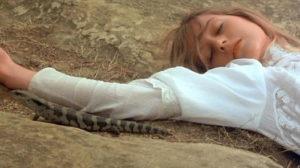 Consider: Picnic at Hanging Rock stages a traumatic disappearance—a group of schoolgirls go on a picnic and come back minus three, and minus one math teacher—and then describes the ripple effects of that disappearance. While there was no actual disappearance of schoolgirls at Hanging Rock either around the turn of the century or in the 19-teens when Lindsay attended Clyde School, there was a traumatic disappearance in Lindsay’s near future when she wrote her manuscript: none other than the cutting of her final chapter, with its beauty and strangeness and its mathematical-physical musings.
Consider: Picnic at Hanging Rock stages a traumatic disappearance—a group of schoolgirls go on a picnic and come back minus three, and minus one math teacher—and then describes the ripple effects of that disappearance. While there was no actual disappearance of schoolgirls at Hanging Rock either around the turn of the century or in the 19-teens when Lindsay attended Clyde School, there was a traumatic disappearance in Lindsay’s near future when she wrote her manuscript: none other than the cutting of her final chapter, with its beauty and strangeness and its mathematical-physical musings.
The cut was traumatic because that final chapter was the most personal statement of Lindsay’s spiritual and scientific beliefs about time. Yet as everyone agrees and Lindsay even came to agree, the novel never would have been popular had the cut not been made. Taylor confirms it was thus a source of deep ambivalence for Lindsay. These are precisely the kinds of mixed emotions that characterize precognition-worthy experiences.
We could thus read the complete dream-inspired novel as originally written in late 1966, with its final chapter, as being about the subsequent editorial cut of its final chapter and the aftereffects of that cut. In the novel, Appleyard College is beset by unwelcome, curious visitors in the aftermath of the disappearance. Mulberry Hill, the Lindsay’s home, was beset by unwelcome, curious visitors in the aftermath of the novel’s publication and especially of the movie: people wanting to find out the truth.
As it happens, the loss of the spiritual chapter, Chapter 18, wasn’t a complete excision, however, and some of the novel’s peculiarities assume a precognitive significance in light of this fact also.
One of the three girls, Irma, who has heard the beating of drums and then witnesses the disappearance of her friends into the hole, is found alive and returns to the school near the end, but without any memory of what happened. It so happens that the passage about the beating of drums (which some readers like Taylor and Phillips thought was a clue that the author was playing tricks with time) originally appeared in Chapter 18 (that is, in correct chronology). Lindsay preserved it and re-placed it, along with a few other passages, earlier in the book when she agreed to cut the rest of the final chapter. The opening paragraph, about the events being frozen in time, was also retained and re-placed to an earlier chapter. In other words, fragments of the missing chapter do appear throughout the book as published, because Lindsay saw fit to have them “rescued” from the editorial edict. The rescue and return of Irma might thus be “prophetic” of the rescue and return of these fragments.
So I suggest—though obviously it would be impossible to prove—that Lindsay’s week of dreams in the winter of 1966, which she feverishly spent her days writing into the novel that made her famous, represented “the whole package” of what was about to happen in her life as a direct result of writing those dreams down—in other words, a time loop. The core thread of prophetic jouissance is a kind of reward and excitement. What could be more exciting than writing an amazing mystery novel and then becoming widely known and admired for it (not to mention the royalties and movie rights)? But like most or all precognitive experiences, it also pointed to the survival of a loss, a cut, a sacrifice that needed to be made for that success, and it was the sacrifice of the bulk of the most radical, personal, and spiritual part of what Lindsay had written.
Fans, I suggest, were thus looking in the wrong direction for the “reality” behind Lindsay’s mystery. The story—a party that traumatically loses a few members and provokes a desperate search, as well as other ripple-effects—rather strikingly anticipates the fate of the novel itself: the traumatic disappearance of its final chapter, leaving everyone “hanging” as to its meaning, and provoking widespread obsessive search for the “true story” underlying it, as well as frustration by the author at having had her most important convictions silenced. Lindsay no doubt did want people to see it, yet felt prevented—silenced, or indeed, castrated.
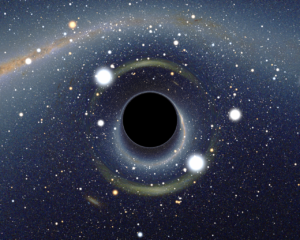 It is incredibly Freudian, really. A castration is a kind of sacrifice or threatened sacrifice that keeps things within their proper limits, a warning or punishment for transgression. In the child’s imagination, it leaves behind a “hole.” It is also Einsteinian: Although the possibility of gravitational singularities had been described in the upper echelons of astrophysics for years, they did not enter the public consciousness until, wait for it, 1967, when the term “black hole” was coined. Lindsay’s “hole in space” image was, again, written late the previous year.**
It is incredibly Freudian, really. A castration is a kind of sacrifice or threatened sacrifice that keeps things within their proper limits, a warning or punishment for transgression. In the child’s imagination, it leaves behind a “hole.” It is also Einsteinian: Although the possibility of gravitational singularities had been described in the upper echelons of astrophysics for years, they did not enter the public consciousness until, wait for it, 1967, when the term “black hole” was coined. Lindsay’s “hole in space” image was, again, written late the previous year.**
Most significantly, the girls’ stunning vision high atop the Rock, of a convex absence that was also a presence, which they could not stop gazing at with pleasure, seems symbolic of the role of the spiritual/paranormal itself in and around the book: The hole is the final chapter in which it is embedded, the excised spiritual core of the novel, the really fascinating part, the solution to the mystery, which everyone wanted to see but which no readers got to see, a presence that became an absence simply because it made a cautiously realist editor uncomfortable.
No Party Is More Important than the Hole
In his classic manual, The Art of Dramatic Writing, Lajos Egri tells a story about the sculptor Rodin and his famous massive sculpture of the writer Balzac. When he had finished and showed it to a group of his pupils, all they could do was rave at how exquisitely he had rendered the writer’s hands, held out in front of his body. According to Egri, this enraged the sculptor, who grabbed an axe and chopped off the hands. “I was forced to destroy these hands because they had a life of their own. They didn’t belong to the rest of the composition. Remember this and remember it well,” he exhorted his students, ”No part is more important than the whole!”
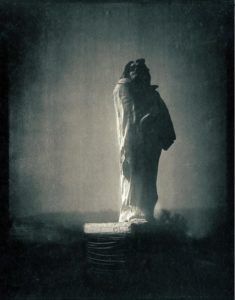 I had always remembered this story about Rodin, from when I had read Egri’s book in college. And since it seemed so appropriate to the story of Joan Lindsay and her Chapter 18, I returned to it for the sake of writing this chapter. I did not have a copy, so I was forced to search the Internet for the quote I was seeking—and that search revealed quite quickly that what Egri had written was not true. Rodin, at least as far as I could determine, never took an axe to his sculpture of Balzac to break off its distractingly wonderful hands. It was merely a bit of artful (and thus memorable) dramatic writing. The reality is both less dramatic but also more revealing—and indeed, even more illustrative of the point I am trying to make about Joan Lindsay’s excised Chapter 18.
I had always remembered this story about Rodin, from when I had read Egri’s book in college. And since it seemed so appropriate to the story of Joan Lindsay and her Chapter 18, I returned to it for the sake of writing this chapter. I did not have a copy, so I was forced to search the Internet for the quote I was seeking—and that search revealed quite quickly that what Egri had written was not true. Rodin, at least as far as I could determine, never took an axe to his sculpture of Balzac to break off its distractingly wonderful hands. It was merely a bit of artful (and thus memorable) dramatic writing. The reality is both less dramatic but also more revealing—and indeed, even more illustrative of the point I am trying to make about Joan Lindsay’s excised Chapter 18.
By the time he was planning his statue of Balzac, Rodin had come to care little about public opinion—about his works or anything else—and his plan for his statue was to depict the writer in the act of masturbating, which Rodin knew had been part of the writer’s creative process. Studies for the final sculpture show the writer gripping the end of his thrust-out member. But his need to satisfy the Société des Gens de Lettres that had made the commission no doubt contributed to Rodin’s self-bowdlerization of his original vision, placing Balzac’s hands under his robe, where it will be unclear to all but the dirtiest-minded viewer (or those who know of Balzac’s habits) what his hands are up to. In the end, it didn’t matter—Rodin lost the commission, his sculpture languished, and it wasn’t finally cast in bronze until long after his death. (It is now on prominent display at the corner of Boulevard du Montparnasse and Boulevard Raspail in Paris.) Undoubtedly, that would not have happened had Rodin remained true to his original vision; it would ultimately have been censored, kept hidden away.
Why did Egri tell his story the way he did? Did he misremember the true story? Was his unconscious so threatened at a statue showing masturbation, or of the “castration” of such a vision, that his memory twisted Balzac’s phallus into hands?
The paranormal is “obscene” in very much the same way as—although perhaps for different reasons than—Rodin’s original vision for his statue of Balzac. Its fate is to be marginalized and denied—erased—and then to haunt us in the way the repressed, per Freud, always returns. Moreover, even when a cultural authority reincorporates what has gone missing, it will often be in a distorted, “safe,” and untrue-to-life fashion, almost as though the real thing has a force field around it, leading to distortion and denial.
The fate of Joan Lindsay’s Chapter 18 is the fate of the paranormal itself in our culture: to be excised, “cut,” from the rest of life in order for everything to add up and not challenge our conventional views of time and causation. We would rather be faced with a traumatic disappearance—a kind of literary castration—and then play the game of hunting for a sensible, materialist cause (the girls were murdered, they fell down a crevasse, etc.) than confront a baffling, science-fictional vision like what Lindsay had presented in her original draft, based on her own intuitions about the nonexistence of time and the living mysteries of the Australian landscape.
Notes:
* Although no schoolgirls seem to have really gone missing at Hanging Rock around the turn of the century or later, the obsessive search for sources for Lindsay’s story did turn up the likely basis for her many coy comments that “something did happen.” According to McCulloch, during her attendance at Clyde School in the mid-19-teens, Lindsay had been editor of the school’s paper, The Cluthan. A couple years after she left the school, in 1919, a math teacher named Miss McCraw published in The Cluthan an account of a field trip of the school’s Camera Club to Hanging Rock at night, to take moonlit pictures. They departed, Miss McCraw described, as a row of “freshly clad maidens” yet returned, after difficult scrambling over rocks and brambles, in a disheveled state: “sorry objects.” The field trip evidently became a source of rumor and mild scandal among students in subsequent years.
** Particularly prescient was Lindsay’s description of what a “hole in space” might look like. For nearly five decades, until Christopher Nolan’s 2014 film Interstellar (which was science-advised by black hole expert Kip Thorne), black holes were confusedly depicted in art and science fiction films as concave whirlpools in space rather than as convex spheres. Her description of a convex hole in space not only anticipated black holes, in other words, but also fast-forwarded to a revolution in black hole iconography that was far off in the future.
Sources:
Anon., An Adventure (with a note by J.W. Dunne)
Phillip Adams, The Unspeakable Adams
Lajos Egri, The Art of Dramatic Writing
Verlyn Flieger, A Question of Time
Helen Goltz, No Picnic at Hanging Rock
Lucille Iremonger, The Ghosts of Versailles
Jeffrey J. Kripal, Mutants and Mystics
Joan Lindsay, Picnic at Hanging Rock
Joan Lindsay, The Secret of Hanging Rock (with commentaries by John Taylor and Yvonne Rousseau)
Joan Lindsay, Time Without Clocks
Janelle McCulloch, Beyond the Rock
Terence O’Neill, “Joan Lindsay: A Time for Everything” (The LaTrobe Journal no. 83, May 2009)
Yvonne Rousseau, The Murders at Hanging Rock
Welcome to the Noöverse
Check out my article in the March 2018 issue of EdgeScience, on why the extraterrestrial hypothesis should be kept on the table (with some modifications).
(And thanks to all my readers who have been patient during my writing hiatus. The book is almost done!)
The Nightshirt Guide to the Twin Peaks Rebirth
“We live in a world of opposites, of extreme evil and violence opposed to goodness and peace. It’s that way here for a reason but we have a hard time grasping what the reason is. In struggling to understand the reason, we learn about balance and there’s a mysterious door right at that balance point. We can go through that door anytime we get it together.” — David Lynch
“Luminous beings are we, not this crude matter.” — Yoda
With the new incarnation of Twin Peaks, David Lynch is inviting obsessive scrutiny, as always. That scrutiny is paying off in all kinds of ways … although it is unclear how much of it is distraction, bones being tossed to the most obsessive fans, and how much is essential for “getting” his remarkable series. I think it’s about half and half.
Lynch’s specific concern is the things that can go wrong or amiss in the spiritual economy of (re)birth.
As strange as what we’ve seen so far is—especially the astonishing, destined-to-be-legendary Episode 8 (spoilers ahead, obviously)—I am surprised at how explicit and clear Lynch is being about some of the themes and ideas that he used to make us guess at. We now actually have concrete answers to some of the biggest questions that always hovered over Twin Peaks‘ world, such as: How did the evil spirit Bob got here, and when? What is the “fire” that the spirits want us to walk with? If I have any slight worry about where this is all going, it is that we might know too much by the time it’s over, rather than being left with myriad questions, the usual Lynch experience. (But it’s not a big worry.)
 Some of the hidden stuff I feel sure is just there just to beguile the obsessed. For instance one fan has discovered that of all things the flashing windows in the jet carrying Gordon Cole et al to South Dakota in Episode 7 is not sun reflection but was added digitally, creating some kind of code … but what? I won’t go down this rabbit hole, or anything numerical; I have no head for numbers. There are other lures in the form of numerical sequences: The “15” that becomes a “3” on the electrical reincarnation machine in the rebirthing lounge in Episode 3, for instance (seen here). I have no clue what that means either (unless something is going to happen in Episode 15 that links to it). [Update 6/29/17: Michael M. Hughes notes in his comment that 315 was Dale Cooper’s room at the Great Northern, as seen on his green room key.] Nor do I know about the numbers (“One one nine!!”) blurted out by the mostly unconscious drug-addicted mom in the Rancho Rosa development (is it just 911 in reverse?).
Some of the hidden stuff I feel sure is just there just to beguile the obsessed. For instance one fan has discovered that of all things the flashing windows in the jet carrying Gordon Cole et al to South Dakota in Episode 7 is not sun reflection but was added digitally, creating some kind of code … but what? I won’t go down this rabbit hole, or anything numerical; I have no head for numbers. There are other lures in the form of numerical sequences: The “15” that becomes a “3” on the electrical reincarnation machine in the rebirthing lounge in Episode 3, for instance (seen here). I have no clue what that means either (unless something is going to happen in Episode 15 that links to it). [Update 6/29/17: Michael M. Hughes notes in his comment that 315 was Dale Cooper’s room at the Great Northern, as seen on his green room key.] Nor do I know about the numbers (“One one nine!!”) blurted out by the mostly unconscious drug-addicted mom in the Rancho Rosa development (is it just 911 in reverse?).
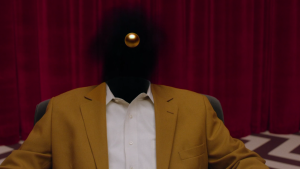 Color seems to be a code here too—the color gold, for instance. We’ve never seen so much gold in a Lynch work—it feels almost gaudy coming from him—and note its prevalence particularly in Episode 3 around Good Cooper’s debut into the real world. Jade’s jeep, the casino, the sport jacket Dougie is wearing before he goes poof (right) and the gold ball he turns into; also Dr. Jacoby’s gold-painted shovels. For the alchemists, “gold” meant (you guessed it) rebirth. The purple color of the rebirth ocean/planet (below) is also interesting, with possible reference to the “astral plane,” often associated with the color purple. There is a lot of Theosophical or pseudo-Theosophical stuff going on here, as we’ll see.
Color seems to be a code here too—the color gold, for instance. We’ve never seen so much gold in a Lynch work—it feels almost gaudy coming from him—and note its prevalence particularly in Episode 3 around Good Cooper’s debut into the real world. Jade’s jeep, the casino, the sport jacket Dougie is wearing before he goes poof (right) and the gold ball he turns into; also Dr. Jacoby’s gold-painted shovels. For the alchemists, “gold” meant (you guessed it) rebirth. The purple color of the rebirth ocean/planet (below) is also interesting, with possible reference to the “astral plane,” often associated with the color purple. There is a lot of Theosophical or pseudo-Theosophical stuff going on here, as we’ll see.
 But another code I’ve detected, and that bears greater exploration I think, consists of a series of interesting cinematic allusions. Lynch seems to be deliberately indexing both his own films but also an assortment of other directors’ works in a somewhat systematic way. Some are the usual suspects like Kubrick; others, though odd on the surface, make greater sense on examination.
But another code I’ve detected, and that bears greater exploration I think, consists of a series of interesting cinematic allusions. Lynch seems to be deliberately indexing both his own films but also an assortment of other directors’ works in a somewhat systematic way. Some are the usual suspects like Kubrick; others, though odd on the surface, make greater sense on examination.
Since I have not seen this “intertextual code” talked about yet, I’m offering it here as my own contribution to the collective fan exegesis, for what it may be worth, along with consideration of the paranormal mythemes Lynch is developing in this breakthrough show.
Lynch is the Monolith and the Ape; Drink Deep, and Descend
Remember that Lynch is a lover of cinema and its history, and has always indexed and referenced other films quite explicitly. He deliberately referenced Ingmar Bergman’s Persona in Mulholland Drive, for instance. So it’s really not surprising he’s doing it again in Twin Peaks. But I think he may be doing it here not only systematically but also semantically—sending a message with some of these film references, not just paying homage to directors he likes.
In the bardo, you can get re-routed and detained, you encounter really creepy beings, and there seem to be multiple levels or staging areas through which you must pass. You wander through it in a daze.
The most obvious references are to films by Kubrick, especially 2001. I think 2001 is the biggest single key to Lynch’s work, especially the final segment “Jupiter and Beyond the Infinite.” Most of Lynch’s films, starting with Eraserhead and Elephant Man and continuing with Twin Peaks and his films of the 1990s and 2000s (everything but Dune, Blue Velvet, and Wild at Heart, essentially), could be seen as “themes and variations” on what happens to Dave Bowman after he passes through the Jovian stargate and becomes the Star Child. (And appropriately enough, a good indicator of whether a person likes Lynch is whether they think 2001 is the most brilliant thing ever or is just meaningless psychedelia. You know where I stand: Don’t be that one man-ape off in back, picking his nose, who doesn’t take any interest in the slab—it’s there to evolve you. Go up and touch it.)
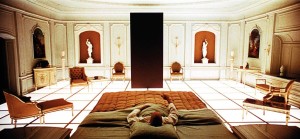 The various rooms we’ve seen so far in the ‘Rebirth Fortress’ (my name for the place where the technology of reincarnation seems to be housed, and where its caretakers seem to live) on the Purple Planet are very much like the hotel suite in 2001—ambiguous, weirdly “terrestrial” and “historical” places of transition prior to rebirth. I was particularly struck that when we enter the fortress in Episode 8, it is via a black aperture that looks exactly like the 2001 monolith. This is deliberate, and Lynch’s most explicit indicator yet that 2001 is his touchstone for all this.
The various rooms we’ve seen so far in the ‘Rebirth Fortress’ (my name for the place where the technology of reincarnation seems to be housed, and where its caretakers seem to live) on the Purple Planet are very much like the hotel suite in 2001—ambiguous, weirdly “terrestrial” and “historical” places of transition prior to rebirth. I was particularly struck that when we enter the fortress in Episode 8, it is via a black aperture that looks exactly like the 2001 monolith. This is deliberate, and Lynch’s most explicit indicator yet that 2001 is his touchstone for all this.
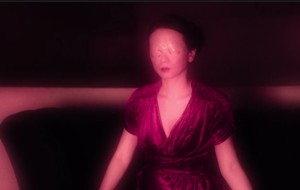 It’s not about Jupiter of course; it’s about what in Tibetan religion—or the faux Tibetan religion delivered by Theosophist Walter Evans-Wentz—is called the bardo, the dimension or plane between lives. Lynch’s specific concern is the things that can go wrong or amiss in the spiritual economy of (re)birth. In the bardo, you can get re-routed and detained, you encounter really creepy beings, and there seem to be multiple levels or staging areas through which you must pass. Nothing makes much sense, and you wander through it in a daze.
It’s not about Jupiter of course; it’s about what in Tibetan religion—or the faux Tibetan religion delivered by Theosophist Walter Evans-Wentz—is called the bardo, the dimension or plane between lives. Lynch’s specific concern is the things that can go wrong or amiss in the spiritual economy of (re)birth. In the bardo, you can get re-routed and detained, you encounter really creepy beings, and there seem to be multiple levels or staging areas through which you must pass. Nothing makes much sense, and you wander through it in a daze.
Kubrick’s own examination of the problem of rebirth and its vicissitudes was The Shining—which he made under the direct influence of Lynch’s Eraserhead (he made the cast watch it); and The Shining in turn was a major influence on Twin Peaks and Lynch’s subsequent work. The various rebirths/possessions through caretaker after caretaker in the Overlook Hotel are a template for the various incarnations of Bob. The Black Lodge with its red curtains is not only like the hotel/bardo of 2001 but also like a “redrum” (i.e., red room).
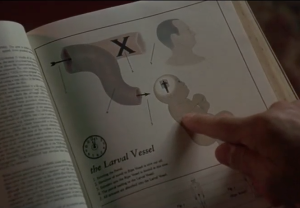 There are other films Lynch is explictly signaling, such as Spike Jonze’s Being John Malkovich. From the first, Dougie’s boss, Bushnell Mullins, a former boxer and founder/owner of “Lucky 7 Insurance,” gave me a strong vibe of Orson Bean as the eccentric Dr. Lester, president of the filing service LesterCorp on the 7 1/2th Floor of the Mertin-Flemmer Building in New York City. Mullins’ interest in Dougie’s cryptic scribbles on the stack of files he had assigned Dougie to work on at home clinched this connection for me. The allusion to Dr. Lester in Jonze’s film is, I think, deliberate: In Being John Malkovich, Lester is a nearly expired “vessel body” for the spirit of the original founder of the company, Captain Mertin, and at one point in the movie we see old diagrams in a book in his home, recalling Theosophy-esque theorizing about “larval vessels” and “ripe vessels” and the transmigration of souls from one body to another. Of all films by other directors, Being John Malkovich captures the essence of what all of Lynch’s oeuvre, and especially Twin Peaks, is about. I doubt it is accidental that John Malkovich himself “channeled” Lynch and the various characters from Twin Peaks a few years ago in a short film. (It’s not very impressive, in my opinion—John Malkovich can’t not seem like John Malkovich. Although maybe that’s the joke.)
There are other films Lynch is explictly signaling, such as Spike Jonze’s Being John Malkovich. From the first, Dougie’s boss, Bushnell Mullins, a former boxer and founder/owner of “Lucky 7 Insurance,” gave me a strong vibe of Orson Bean as the eccentric Dr. Lester, president of the filing service LesterCorp on the 7 1/2th Floor of the Mertin-Flemmer Building in New York City. Mullins’ interest in Dougie’s cryptic scribbles on the stack of files he had assigned Dougie to work on at home clinched this connection for me. The allusion to Dr. Lester in Jonze’s film is, I think, deliberate: In Being John Malkovich, Lester is a nearly expired “vessel body” for the spirit of the original founder of the company, Captain Mertin, and at one point in the movie we see old diagrams in a book in his home, recalling Theosophy-esque theorizing about “larval vessels” and “ripe vessels” and the transmigration of souls from one body to another. Of all films by other directors, Being John Malkovich captures the essence of what all of Lynch’s oeuvre, and especially Twin Peaks, is about. I doubt it is accidental that John Malkovich himself “channeled” Lynch and the various characters from Twin Peaks a few years ago in a short film. (It’s not very impressive, in my opinion—John Malkovich can’t not seem like John Malkovich. Although maybe that’s the joke.)
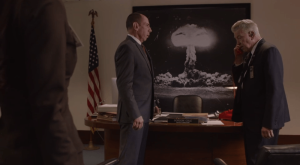 The next one, a Woody Allen reference of all things, will seem odd, but bear with me. After Episode 8, we know that Gordon Cole’s huge photo of a mushroom cloud behind his desk signals his knowledge that the bomb is directly connected to the “Blue Rose” (supernatural) cases that are his special interest. Turns out it was specifically the Trinity test on July 16, 1945 that ripped open the barrier between worlds that let an evil host through. Bob and his evil ilk are seen vomited forth by the evil white figure (see below) who was glimpsed devouring the couple on the couch in Episode 2, in front of the glass box; Bob is shown clearly as this spirit-mother’s darkest progeny. The fire the evil spirits want us to walk with is nuclear fire. Famously, the Manhattan Project’s leader, J. Robert Oppenheimer, later quoted the Bhagavad-Gita in reference to what they had wrought: “I am become death, destroyer of worlds.”
The next one, a Woody Allen reference of all things, will seem odd, but bear with me. After Episode 8, we know that Gordon Cole’s huge photo of a mushroom cloud behind his desk signals his knowledge that the bomb is directly connected to the “Blue Rose” (supernatural) cases that are his special interest. Turns out it was specifically the Trinity test on July 16, 1945 that ripped open the barrier between worlds that let an evil host through. Bob and his evil ilk are seen vomited forth by the evil white figure (see below) who was glimpsed devouring the couple on the couch in Episode 2, in front of the glass box; Bob is shown clearly as this spirit-mother’s darkest progeny. The fire the evil spirits want us to walk with is nuclear fire. Famously, the Manhattan Project’s leader, J. Robert Oppenheimer, later quoted the Bhagavad-Gita in reference to what they had wrought: “I am become death, destroyer of worlds.”
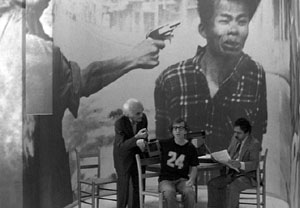 But before we knew this connection, the photo also recalled Woody Allen’s character Sandy Bates in his 1980 homage to Fellini, Stardust Memories. Bates is a film director anxious over his current production (like Marcello Mastroianni’s character in 8 1/2), and to reflect his dark mood his apartment is dominated by a gigantic blow-up of the famous b/w photograph of a South Vietnamese officer executing a Vietcong prisoner, as a reminder of the world’s darkness and atrocity. The significance of this reference may be nothing more than to subliminally activate the phrase “stardust memories” in a viewer who remembers that film—i.e., memories of our past life or origins in the stars (but see below).
But before we knew this connection, the photo also recalled Woody Allen’s character Sandy Bates in his 1980 homage to Fellini, Stardust Memories. Bates is a film director anxious over his current production (like Marcello Mastroianni’s character in 8 1/2), and to reflect his dark mood his apartment is dominated by a gigantic blow-up of the famous b/w photograph of a South Vietnamese officer executing a Vietcong prisoner, as a reminder of the world’s darkness and atrocity. The significance of this reference may be nothing more than to subliminally activate the phrase “stardust memories” in a viewer who remembers that film—i.e., memories of our past life or origins in the stars (but see below).
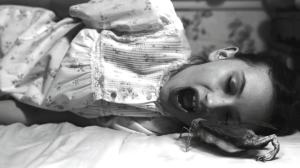 On the opposite wall of Cole’s office is another big photo most would find depressing: Franz Kafka. The first free association that comes to mind for me and I assume many people would be the word “metamorphosis”—a man reborn as a bug (most imagine a cockroach, but in the original German it is mistkafer, a dung beetle or scarab, symbol of rebirth). In Episode 8, the Giant (or, the Giant’s father?), one of the caretakers in the Rebirth Fortress, dismayed at nuclear developments on Earth and alarmed at seeing Bob en route, sends his own spirit or seed to combat that evil force. The next scene, taking place in 1956, shows a frog-like winged insect hatching from a meteorite egg, which crawls into the body of a girl, no doubt to possess or impregnate her.
On the opposite wall of Cole’s office is another big photo most would find depressing: Franz Kafka. The first free association that comes to mind for me and I assume many people would be the word “metamorphosis”—a man reborn as a bug (most imagine a cockroach, but in the original German it is mistkafer, a dung beetle or scarab, symbol of rebirth). In Episode 8, the Giant (or, the Giant’s father?), one of the caretakers in the Rebirth Fortress, dismayed at nuclear developments on Earth and alarmed at seeing Bob en route, sends his own spirit or seed to combat that evil force. The next scene, taking place in 1956, shows a frog-like winged insect hatching from a meteorite egg, which crawls into the body of a girl, no doubt to possess or impregnate her.
 [The following updated 6/29/17 in light of reader comments.] Is the bug the terrestrial manifestation of the Giant and is the girl destined to be a savior figure? Is she Sarah Palmer, Laura’s Mom? (We saw Laura’s face in the Giant’s orb before his wife(?) sends it on its way to Earth, although 1956 is still about a decade and a half too early for Laura’s ‘conception.’) Or is the bug the larval form of Bob or one of his brethren, whose eggs were also seen in the ectoplasmic vomit spewed by the ‘spirit mother’? Whatever the case, we are likely to see a Kafkaesque transformation at some point. After the episode aired, Daniel McGachey (@DMcGachey) tweeted the picture above, from a 1991 book Twin Peaks: An Access Guide to the Town. It is clearly the source for the creature. The text describes a Chinook legend about “the ancestress of the Frog Clan” who was covered with these winged frog creatures. If any readers have any further information about this bit of mythology, or know if it is genuine, please let me know in comments.
[The following updated 6/29/17 in light of reader comments.] Is the bug the terrestrial manifestation of the Giant and is the girl destined to be a savior figure? Is she Sarah Palmer, Laura’s Mom? (We saw Laura’s face in the Giant’s orb before his wife(?) sends it on its way to Earth, although 1956 is still about a decade and a half too early for Laura’s ‘conception.’) Or is the bug the larval form of Bob or one of his brethren, whose eggs were also seen in the ectoplasmic vomit spewed by the ‘spirit mother’? Whatever the case, we are likely to see a Kafkaesque transformation at some point. After the episode aired, Daniel McGachey (@DMcGachey) tweeted the picture above, from a 1991 book Twin Peaks: An Access Guide to the Town. It is clearly the source for the creature. The text describes a Chinook legend about “the ancestress of the Frog Clan” who was covered with these winged frog creatures. If any readers have any further information about this bit of mythology, or know if it is genuine, please let me know in comments.
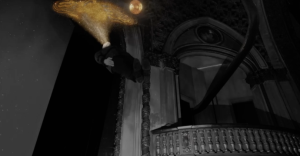 With the pictures in his office, Lynch (as Gordon Cole) seems to be signaling not only the origin of evil in our world but also possibly a pathway to redemption. The fact that the Giant and his wife—keepers of the fortress, presumably—interact with earth via a kind of newsreel projection also calls to mind cinema as the interface or mediator of rebirth. Also, as the giant’s suspended body is generating his seed/egg, his head produces a shower of golden sparkles, like stardust. After the orb is beheld and kissed by the Giant’s wife, a golden machine (@Dharmapoppins aptly compares it to a fallopian tube) projects the three-dimensional “golden orb” into the flat newsreel picture, where it then makes its way to Earth. The movie screen as uterus.
With the pictures in his office, Lynch (as Gordon Cole) seems to be signaling not only the origin of evil in our world but also possibly a pathway to redemption. The fact that the Giant and his wife—keepers of the fortress, presumably—interact with earth via a kind of newsreel projection also calls to mind cinema as the interface or mediator of rebirth. Also, as the giant’s suspended body is generating his seed/egg, his head produces a shower of golden sparkles, like stardust. After the orb is beheld and kissed by the Giant’s wife, a golden machine (@Dharmapoppins aptly compares it to a fallopian tube) projects the three-dimensional “golden orb” into the flat newsreel picture, where it then makes its way to Earth. The movie screen as uterus.
Hal Ashby’s great film Being There is another obvious reference for this series. Good Cooper (as Dougie Jones) ambles through life like the childlike gardener Chance (Peter Sellers). Like Chance, Cooper/Dougie is at this point a blank cipher on which other people project what they want to see/hear, and they guide him to success inadvertently. It is significant that “chance” as in luck (e.g., “Lucky 7 Insurance” and his luck at the casino, or in evading the hitmen) is so much a part of Good Cooper’s story at this point. Again, Lynch may simply be referencing the phrase “being there,” as in “be there” or “be here now”—i.e., be present in your life.
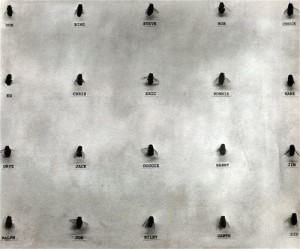 Lynch is also explicitly citing/alluding to his own works. This could easily turn into a long rabbit hole but I’ll just mention a few: “Dougie” for instance is name of the central “Rickie” in Lynch’s most famous “Rickie Board,” his 1994 Bee Board. The idea is to make a 4 by 5 array of identical objects or “Rickies”—Lynch most often used drawings of or actual dead insects like flies—and put a different name under each of them. An amazing effect is produced that each identical insect comes to take on a distinct personality because of its name. The reborn, amnesic Dale Cooper is a bit like a Rickie, a cipher being given shape and form by the name “Dougie” people use for him.
Lynch is also explicitly citing/alluding to his own works. This could easily turn into a long rabbit hole but I’ll just mention a few: “Dougie” for instance is name of the central “Rickie” in Lynch’s most famous “Rickie Board,” his 1994 Bee Board. The idea is to make a 4 by 5 array of identical objects or “Rickies”—Lynch most often used drawings of or actual dead insects like flies—and put a different name under each of them. An amazing effect is produced that each identical insect comes to take on a distinct personality because of its name. The reborn, amnesic Dale Cooper is a bit like a Rickie, a cipher being given shape and form by the name “Dougie” people use for him.
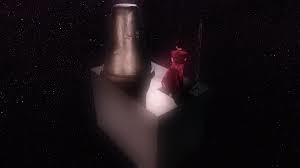 Then there’s Eraserhead, of course: The fortress on the Purple Planet through which souls pass on their way to rebirth has a definite Eraserhead vibe. Remember the “Man in the Planet” who pulls a lever and releases the sperm-like seeds that become the deformed baby. Much of Episode 3 (the space box with its lever) and Episode 8 recall this Gnostic mechanism of cosmic insemination and rebirth. That film of course is about “things that can go wrong with birth,” a theme Lynch also revisited in his next film, Elephant Man.
Then there’s Eraserhead, of course: The fortress on the Purple Planet through which souls pass on their way to rebirth has a definite Eraserhead vibe. Remember the “Man in the Planet” who pulls a lever and releases the sperm-like seeds that become the deformed baby. Much of Episode 3 (the space box with its lever) and Episode 8 recall this Gnostic mechanism of cosmic insemination and rebirth. That film of course is about “things that can go wrong with birth,” a theme Lynch also revisited in his next film, Elephant Man.
And of course there is Mulholland Drive. I’ve written before about the importance of The Cowboy as a stand-in for Lynch in his most scolding, preacher mode: Stop bein’ a smart-aleck and pay attention, is what Lynch’s ultimate message for us full-of-ourselves, wise-ass humans is. Well, the other message The Cowboy delivers in that film is “time to wake up.” It is interesting that Lynch has cast Naomi Watts as the bewildered/protective wife of the befuddled Dougie—essentially reprising her role as the innocent rescuer/helper of the amnesic Rita in Mulholland Drive—and that their son, “Sonny Jim,” is in his obsessions (and flickering on/off lamp) a cowboy. The moving scene in Episode 4 when Cooper/Dougie stares at Sonny Jim in the driveway and begins to cry represents his beginning to wake up, and I imagine we can expect Sonny Jim to play a further role in Dale Cooper’s process of awakening, possibly in Episode 9.
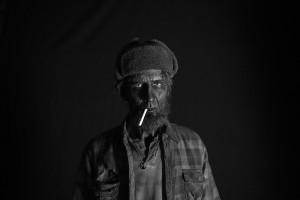 The shambling, soot-faced evil spirits that swarm in and around the famous Convenience Store (above which Mike once lived with Bob in their killin’ days) are reminiscent of the evil presence behind Winky’s diner in Mulholland Drive. “The Woodsman” who we met in Episode 8 and wants a light, kills the folks at the radio station, and hypnotizes the New Mexico town with his chant about the water and the well, etc., is like the creature behind Winky’s crossed with Abraham Lincoln (speaking in a voice that uncannily sounds like John Huston’s Gandalf in the 1977 Rankin Bass version of The Hobbit, which added a further dimension of strangeness for me). Turns out that not long before they filmed Twin Peaks, the actor who plays the Woodsman was also in a very short, very funny film called Linclone, about an evil clone of Lincoln, so there you go.
The shambling, soot-faced evil spirits that swarm in and around the famous Convenience Store (above which Mike once lived with Bob in their killin’ days) are reminiscent of the evil presence behind Winky’s diner in Mulholland Drive. “The Woodsman” who we met in Episode 8 and wants a light, kills the folks at the radio station, and hypnotizes the New Mexico town with his chant about the water and the well, etc., is like the creature behind Winky’s crossed with Abraham Lincoln (speaking in a voice that uncannily sounds like John Huston’s Gandalf in the 1977 Rankin Bass version of The Hobbit, which added a further dimension of strangeness for me). Turns out that not long before they filmed Twin Peaks, the actor who plays the Woodsman was also in a very short, very funny film called Linclone, about an evil clone of Lincoln, so there you go.
Gotta Guiding Light?
In all his interviews and published writings, Lynch projects an image of himself as a “pure artist,” right-brained, somewhat inarticulate about the meaning of his work (or unwilling to speak about it) but full of folksy wisdom. When Mitch Horowitz asked Lynch in a recent excellent radio interview (produced by my wife Laura Kwerel, so that’s a plug) whether he’d ever seen a ghost or a UFO, he said “No I haven’t” and did not elaborate. But clearly he (along with Mark Frost, his cowriter) knows a lot about the paranormal and the occult. And with the new Twin Peaks, Lynch is more clearly than ever telling a spiritual story via the medium of paranormal science fiction. Where the original series was like an occult-inflected soap opera, this one is turning into something much more epic, like a comic book, complete with superpowers and origin stories. Thus a great lens through which to view this unprecedented TV event is the work of Jeffrey Kripal, who mapped the core mythemes of the paranormal “super story” in his books Mutants and Mystics and The Super Natural.
With the new Twin Peaks, Lynch is more clearly than ever telling a spiritual story via the medium of paranormal science fiction.
Most obviously there is the “mytheme of radiation.” Ever since Lynch’s earliest work and especially in all the incarnations of Twin Peaks, energy in the form of electricity is the carrier of spirit. Lynch is obsessed with flickering lights, bad connections, old bakelite lamps and clocks, and power lines. In both Fire Walk With Me and the beautiful/devastating Episode 6 of the new series, Harry Dean Stanton’s character Carl has visions associated with the power lines that hang unnoticed over the streets of his town. And when Dale Cooper is reborn through an electrical outlet in an empty Rancho Rosa home, I was thinking: Lynch must have been reading Kripal. The strange pylons in the Fortress of Rebirth and on the space box in Episode 3 are somehow transformers of electrical-spiritual energy. Somehow, the rebirth system on our planet utilizes or co-opts human technology.
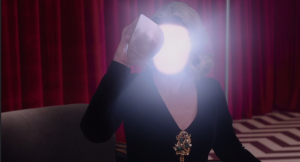 In this Twin Peaks incarnation, Lynch is also showing us more explicitly what he thinks about light as such. Early on, Laura Palmer in the Black Lodge pulls aside her face to reveal to Dale Cooper that she is a creature of light. Carl watches dumbstruck as the golden soul of the boy killed by Richard Horne’s truck ascends to the power lines above, where presumably he will be rerouted to some central reincarnational transformer. Lynch is showing his spiritual hand in this series more than ever before. As Yoda tells Luke Skywalker in The Empire Strikes Back, “Luminous beings are we, not this crude matter.” Lynch clearly agrees with Yoda. Lynch may be Yoda.
In this Twin Peaks incarnation, Lynch is also showing us more explicitly what he thinks about light as such. Early on, Laura Palmer in the Black Lodge pulls aside her face to reveal to Dale Cooper that she is a creature of light. Carl watches dumbstruck as the golden soul of the boy killed by Richard Horne’s truck ascends to the power lines above, where presumably he will be rerouted to some central reincarnational transformer. Lynch is showing his spiritual hand in this series more than ever before. As Yoda tells Luke Skywalker in The Empire Strikes Back, “Luminous beings are we, not this crude matter.” Lynch clearly agrees with Yoda. Lynch may be Yoda.
But there is also the Trinity mushroom cloud, and the Kubrick-esque journey inside it—one of the most beautiful visions I’ve ever seen on TV or in film, and a concrete historical reference I never quite expected from Lynch. Clearly this is a bad form of “radiation” that allows an unprecedented evil to gain access to our planet.
“Mutation” is another obvious mytheme throughout Lynch’s work, of course, and is the obvious result of radiation. Physical mutation describes the idea of “(re)birth gone awry,” beginning with Eraserhead and Elephant Man and Balthasar Getty’s character in Lost Highway (“reborn” with strange bumps on his head), not to mention the “evolution of the arm” (see below) and the various human body types and shapes (extremely fat, extremely thin, giants, dwarves, etc.) that appear throughout his work. In the new Twin Peaks I’m marveling at the interesting-looking actors Lynch has found to work with: people with Neandertal-esque brow ridges (Ray), weirdly sloping foreheads (the evil Richard Horne), and so on.
But then there is mutation as in “rebirth with superpowers,” and it is Good Cooper/Dougie who is showing us this new, more extravagantly sci-fi/comic-book side of Lynch. Cooper navigates the casino, seeing “Black Lodge icons” over the slot machines (“one-armed bandits,” colloquially—more on “arms” below) that will pay a jackpot; a green light flashing on coworker Anthony’s face tells him the man is lying; and lights on his “homework” guide his pencil. It is a kind of sixth sense or precognition manifesting—as it often does in real life—as literal “guiding lights.”
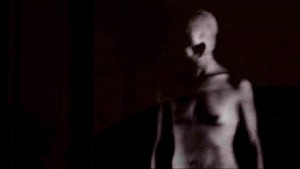 And there is the “mytheme of alienation.” This has been present from the start of the original series: Who are these entities in the Black Lodge? But it is becoming more and more explicit that they are not from or of our world, but that our own technology has allowed them to gain access. I have always wished Lynch would tell a full-on sci-fi story (forgetting Dune, of course), and now I am getting my wish. The amphibian-beetle from a meteorite egg in the New Mexico desert (which then crawls into the mouth of the sleeping girl) is the most explicitly “alien” creature Lynch has ever created, with the possible exception of the baby in Eraserhead. Then of course there is the eyeless ‘spirit mother’ (above). Lynch is more boldly saying that these “spirits” are really alien. They are not just projections of our own shadow selves.
And there is the “mytheme of alienation.” This has been present from the start of the original series: Who are these entities in the Black Lodge? But it is becoming more and more explicit that they are not from or of our world, but that our own technology has allowed them to gain access. I have always wished Lynch would tell a full-on sci-fi story (forgetting Dune, of course), and now I am getting my wish. The amphibian-beetle from a meteorite egg in the New Mexico desert (which then crawls into the mouth of the sleeping girl) is the most explicitly “alien” creature Lynch has ever created, with the possible exception of the baby in Eraserhead. Then of course there is the eyeless ‘spirit mother’ (above). Lynch is more boldly saying that these “spirits” are really alien. They are not just projections of our own shadow selves.
Spiritual Coffee
Clearly this reincarnation of Twin Peaks is pointing toward a spiritual tradition and practice, much more explicitly than any of Lynch’s previous works. The metaphysics has overtones of Theosophy (especially as smuggled via Evans-Wentz’s not-really-Buddhist-but-more-Theosophical Tibetan Book of the Dead) and Gnosticism (extraterrestrial spirits controlling rebirth on our planet, etc.). But I feel pretty confident that Lynch has no new message here that we couldn’t find in his other works, albeit perhaps more obliquely: Pay attention, wake up, dive within, and stop being a smart-aleck (in no particular order). Being good people follows from that. More than any artist, Lynch knows how to indicate the Good by means of the Bad—his work is full of unforgettable archetypes of obliviousness, lack of compassion, selfishness, and greed, as well as archetypes of innocence, compassion, simplicity, goodness. The polarity is explicit.
Remember that Lynch wants us to wake up in THIS world, the real world.
There’s no mystery about Lynch’s ultimate intent as an artist, and that is to get us to meditate. He’d specifically like us all to be Transcendental Meditators, because he thinks that’s the only real route to bliss and what he calls the “unified field.” He found TM as a young man and never looked back, and consequently proselytizes narrowly for it. But I’ve written before about how Zen meditation will get you just as quickly to the same place Lynch seems to go. That place is incredibly rewarding, and it does feel just like Twin Peaks, and you do get great ideas (“big fish”) when you’re faithful about it. I’m sure that any number of meditative/mystical practices will do the same. So, believe Lynch when he talks about TM, just mentally strike the T and the implied trademark after it: You just need the M, free of charge, and whatever flavor speaks to you … but you do need to do it, daily.
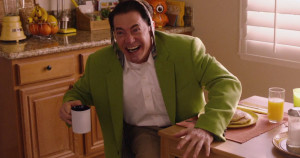 But also remember that Lynch wants us to wake up in THIS world, the real world. His puzzle films like Mulholland Drive reveal themselves to be lures to our desire to make connections, but we are meant to be spit out the other side with a renewed clarity that none of it is real, that it’s “all a recording.” He has planted a million little puzzles in Twin Peaks—we’ll all be poring over this for years—but the ultimate aim I’m sure is to bring us out the other side of our interpretive quest when we realize, with a kind of shock, that it is all a show.
But also remember that Lynch wants us to wake up in THIS world, the real world. His puzzle films like Mulholland Drive reveal themselves to be lures to our desire to make connections, but we are meant to be spit out the other side with a renewed clarity that none of it is real, that it’s “all a recording.” He has planted a million little puzzles in Twin Peaks—we’ll all be poring over this for years—but the ultimate aim I’m sure is to bring us out the other side of our interpretive quest when we realize, with a kind of shock, that it is all a show.
Thus I wouldn’t be surprised if there is some slap-you-in-the-face “Club Silencio” type scene before we are through, driving this point home. To an extent, the Roadhouse concerts sort of play that role: They break the fourth wall in a sense and create a bridge to the real world. I like to think, though, that in the last episode, the actors will all break character and appear on the dancefloor of the Roadhouse, as themselves, like the awesome celebratory end credits in Inland Empire.
The Devil Will Find Work for Idle Arms to Do
Lynch’s favorite symbol for what roots us in evil and suffering and ignorance is arms. We’ve known explicitly since Fire Walk With Me that Bob possesses people through their arms: Their arms go numb before they become his vessels. The one-armed man, remember, cut off his own arm to escape his possession by Bob’s evil companion in killing, Mike. I think arms are Lynch’s way of showing the idea of clinging/grasping as what holds us back from the good, and keeps us on the surface of life, preventing us from diving deep.
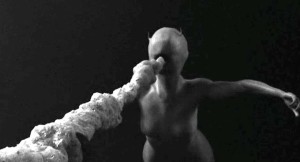 By this logic, the one-armed-man’s recalled self-amputation (from the original series) seems to represent “getting rid of grasping/clinging,” a great metaphor that every ancient Zen teacher still flickering on some eternal Chinese mountainside undoubtedly wishes he thought of. Also, recall how Laura Palmer said that sometimes her arms bend back, which we all thought was a reference to Bob (as her father Leland) tying her up in the train car where he raped and killed her … but now we have a new meaning: The supremely evil vomiting spirit mother’s arms are on backwards (something I only noticed when I looked closely at the still reproduced here). This seems like another kind of perversion of desire or attachment.
By this logic, the one-armed-man’s recalled self-amputation (from the original series) seems to represent “getting rid of grasping/clinging,” a great metaphor that every ancient Zen teacher still flickering on some eternal Chinese mountainside undoubtedly wishes he thought of. Also, recall how Laura Palmer said that sometimes her arms bend back, which we all thought was a reference to Bob (as her father Leland) tying her up in the train car where he raped and killed her … but now we have a new meaning: The supremely evil vomiting spirit mother’s arms are on backwards (something I only noticed when I looked closely at the still reproduced here). This seems like another kind of perversion of desire or attachment.
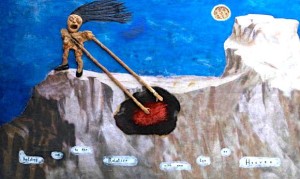 Lynch is obsessed with arms in his paintings as well: One of his lithographs is “Arm of Sores,” for instance, and many of his paintings such as “Boy Lights Fire” or “Pete Goes to His Girlfriend’s House” have evil figures with greatly elongated arms, doing or about to do mischief. And there is “Holding on to the Relative with One Eye on Heaven” (shown here).
Lynch is obsessed with arms in his paintings as well: One of his lithographs is “Arm of Sores,” for instance, and many of his paintings such as “Boy Lights Fire” or “Pete Goes to His Girlfriend’s House” have evil figures with greatly elongated arms, doing or about to do mischief. And there is “Holding on to the Relative with One Eye on Heaven” (shown here).
The neuron-like arm-tree in the Black Lodge, “the evolution of the arm,” on one hand seems to symbolize “making connections” (which we can connect to A.X.X.O.N.N. in Inland Empire)—and his/its role in Episode 7 makes this clear: It appears precisely to remind Dougie/Cooper of his FBI self-defense training: “squeeze his hand off.” In other words: reminding you of something you already know but just haven’t “made the connection.” The scary psychopath Ike the Spike clearly has “gripped too tightly” since the police have to peel his skin off the pistol grip after he flees the scene.
Lest we read too much into the arm’s “evolution,” however, remember that it was dictated principally by the refusal of Michael J. Anderson to reprise his role as the Man From Another Place (a.k.a. “dancing dwarf,” a.k.a. “Mike’s arm”) due to some personal dispute with Lynch. It’s too bad, he had much more personality than the tree, and was a better dancer.
When Will Bowie Show Up?
This is more a fan hope than a fan theory, but I think Lynch’s indirect denials to the contrary, it is altogether possible that David Bowie will show up late in the series reprising his role as Philip Jeffries, the FBI agent who disappeared in Buenos Aires after investigating someone named Judy. Lynch was able to film Catherine Coulson (the Log Lady), who was also dying of cancer and who died months before Bowie did. It would be just like the two Davids, the two greatest American artists of our time (I sort of consider Bowie American), to pull a surprise like this. Fans will go nuts. Bowie would have realized that, and being so concerned with legacy and sending a message to the future, would have done whatever he could to pop up as a surprise in Lynch’s show. These men, of all people, would have made it happen if they could.
 An added hunch: If Bowie does appear, it will be in Episode 15, the day before the big eclipse, and there may be additional Blackstar allusions or tie-ins. Remember that that song also is about a spirit rising from a dead body and being replaced by another; and remember that the video featured a headless skeleton floating in space. Twin Peaks seems to be “going there” in all kinds of ways, including the headless corpse of Major Briggs (possibly after a UFO journey that caused him to not age) and the various references to Jeffries and calls to a transforming black box in Buenos Aires, where Jeffries was last seen.
An added hunch: If Bowie does appear, it will be in Episode 15, the day before the big eclipse, and there may be additional Blackstar allusions or tie-ins. Remember that that song also is about a spirit rising from a dead body and being replaced by another; and remember that the video featured a headless skeleton floating in space. Twin Peaks seems to be “going there” in all kinds of ways, including the headless corpse of Major Briggs (possibly after a UFO journey that caused him to not age) and the various references to Jeffries and calls to a transforming black box in Buenos Aires, where Jeffries was last seen.
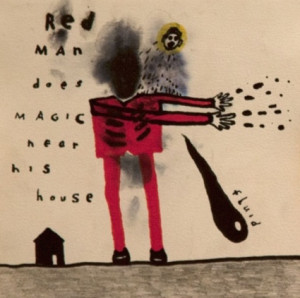 I’ve been getting a “Blackstar vibe” from this series in other ways: Lynch has been signaling his interest in ritual magic in his paintings for a few years now (see the 2013 painting at left, for instance, “Red Man Does Magic Near His House”), and though it hasn’t yet surfaced in his films, we were treated to a big time evil ritual over the wounded Evil Cooper/Bob in Episode 8, and we may see more of the same as the series progresses. That the savior of humanity from the likes of Bob might be ultimately in the hands of women (the message of Bowie’s “Blackstar” video, i.e. a ritual replacing “ISIS” and its various dark masculine permutations with Isis the goddess) seems likely in Twin Peaks too. If the 1956 girl is the vessel for the good Giant from the Purple Planet (versus the vessel for Bob or one of his fellows, see above), perhaps she will play some savior role. Whatever the case, the series certainly seems to be taking an epic direction.
I’ve been getting a “Blackstar vibe” from this series in other ways: Lynch has been signaling his interest in ritual magic in his paintings for a few years now (see the 2013 painting at left, for instance, “Red Man Does Magic Near His House”), and though it hasn’t yet surfaced in his films, we were treated to a big time evil ritual over the wounded Evil Cooper/Bob in Episode 8, and we may see more of the same as the series progresses. That the savior of humanity from the likes of Bob might be ultimately in the hands of women (the message of Bowie’s “Blackstar” video, i.e. a ritual replacing “ISIS” and its various dark masculine permutations with Isis the goddess) seems likely in Twin Peaks too. If the 1956 girl is the vessel for the good Giant from the Purple Planet (versus the vessel for Bob or one of his fellows, see above), perhaps she will play some savior role. Whatever the case, the series certainly seems to be taking an epic direction.
If Bowie appears, he might have also reserved a new unreleased song to appear in Lynch’s series (and its much anticipated soundtrack album), so I would expect some other performer (perhaps one of the cast of Lazarus?) to perform it at the Roadhouse.
Again, this is fan hope as much as fan theory, but I’m keeping my arm’s fingers crossed.
I’ll update this post as new information emerges, as readers chime in (please chime in), and most likely as I’m proved wildly wrong.
Postscript: Arms Don’t Bend Back
The question of arms and how they properly behave happened to be central to the Satori (enlightenment) experience of Zen writer and teacher Daisetz Suzuki, who brought Zen to America in the middle decades of the last century. In an autobiographical essay he described that his initial kensho, or a kind of luminous awakening attained after intense koan meditation, was only deepened and solidified by a second, subsequent realization some days later: that arms do not bend back:
After kensho, I was still not fully conscious of my experience. I was still in a kind of dream. The greater depth of realization came later … when suddenly the Zen phrase hiji soto ni magarazu, “the elbow does not bend outwards,” became clear to me. “The elbow does not bend outwards” might seem to express a kind of necessity, but suddenly I saw that this restriction was really freedom, the true freedom, and I felt that the whole question of free will had been solved for me.
This kind of “duh” realization about something as simple as the elbow joint is a distinctive Zen experience. It expresses exactly what I was getting at in my previous post, about the paradoxical freedom that comes from the limitation implied by the Minkowski block universe. Enlightenment comes from this kind of revelatory awareness of physical limitation, while ignorance (and darkness) is its denial … as in Lynch’s evil arm perversions.
Master Minkowski’s Wild Ducks (Zen and the Glass Block Universe)
Probably because I am thinking about (and trying to finish a book on) precognition and retrocausation and the glass block universe they seem to imply, I keep finding my thoughts returning to a famous Zen koan from 8th-century China. You will have heard it: Master Ma and his student Pai Chang were walking along when they encountered a flock of wild ducks. “What is that?” Ma said. “Wild ducks,” Pai Chang answered. “Where have they gone?” Ma asked? “They’ve flown away,” Pai Chang said … at which point Master Ma grabbed his student’s nose and gave it a painful twist: “When have they ever flown away!”
The considerable evidence of precognition and retrocausation points to the reality of something like the glass block, the already-ness of the future and the persistence of the past.
There are many versions of the story, and many translations of the different versions. R.H. Blyth’s version spells out Ma’s meaning a bit, in case we are confused (which we are): “When did they ever fly away?” Ma says, “They have been here from the beginning!” Blyth’s Games Zen Masters Play (where this appears) probably was a strong influence on J.D. Salinger when he was writing The Catcher in the Rye; Holden Caulfield’s constant obsession with where the ducks at the lake in Central Park go in wintertime is an allusion to this koan. (Indeed, the whole novel is sort of about it, and about the young narrator’s gradual coming to a slightly more Zen-like understanding of questions of life and death, permanence and change.)
This “public case” (the original meaning of koan) has many layers, and it is important not to think that Pai Chang, just because he got his nose twisted, was wrong in saying that the ducks were gone. In their play-by-play commentary on these ancient dharma battles, some writers declare Pai-Chang the victor, not Ma. There’s Zen virtue in telling it just like it is. But the significance of this story that is obviously relevant to my obsession with precognition is this notion of permanence that Master Ma’s words imply: “When did they ever fly away?” is like an assertion of Hermann Minkowski’s argument, based on his student Einstein’s theory of relativity, that things in the past are still here, and that things that haven’t happened yet are here already.
 If Pai Chang, with his sore nose, is a bit like Heraclitus, who found that you can’t step in the same river twice, Ma is a bit like his counterpart in these debates, the shaman/mystic Parmenides, and also his later interpreter Zeno, asserting the permanence within apparent impermanence.
If Pai Chang, with his sore nose, is a bit like Heraclitus, who found that you can’t step in the same river twice, Ma is a bit like his counterpart in these debates, the shaman/mystic Parmenides, and also his later interpreter Zeno, asserting the permanence within apparent impermanence.
I’ve always been a Heraclitus man myself, and a couple years ago on this blog I rebelled against the glass block and the Eternalism it entailed, even going so far as accusing outspoken Eternalist Alan Moore of being a hoarder: Minkowski glass-block-ism, where “every condom, every syringe, every beer can is preserved in Jerusalem’s gutters,” seemed to me like a hoarder’s cosmology. I’ve changed my mind in the intervening time. I think that, like many people when confronting these questions, I allowed my knee-jerk, heavily culture-bound assumption of free will and the open-endedness of things to prevent me from considering the possible reality, realism, and even spiritual satisfactions of Minkowski’s glass block.
The Bird is the Word
Compare “Master Ma’s Wild Ducks” with a painfully beautiful anecdote from Bede’s Ecclesiastical History of the English People about the conversion of the Anglo-Saxons to Christiantiy. In the 6th century, the Northumbrian king Edwin was confronted by pressures to renounce his paganism and embrace the new religion; uncertain what was right, he took counsel with his “ealdormen and thegns” (advisors and nobles) on this question, and one of them stated his own opinion using the metaphor of a sparrow:
This is how the present life of man on earth, King, appears to me in comparison with that time which is unknown to us. You are sitting feasting with your ealdormen and thegns in winter time; the fire is burning on the hearth in the middle of the hall and all inside is warm, while outside the wintry storms of rain and snow are raging; and a sparrow flies swiftly through the hall. It enters in at one door and quickly flies out through the other. For the few moments it is inside, the storm and wintry tempest cannot touch it, but after the briefest moment of calm, it flits from your sight, out of the wintry storm and into it again. So this life of man appears but for a moment; what follows or indeed what went before, we know not at all. If this new doctrine brings us more certain information, it seems right that we should accept it.
I’ve always thought about the cold harsh uncertain life of those men in that hall—the same people who sang stories of the monster Grendel lurking in the wild wastes and muscular heroes like Beowulf who could bring temporary peace to their windswept fragile little kingdoms. For Edwin’s counselor (and for centuries of the Venerable Bede’s English readers), Christ was a kind of hero who could save us from the cold uncertainty of what awaited us beyond this mortal life—a solace the poor sparrow could not enjoy.
Christ, with His redeeming retrocausal tachyon blood, offered the exact same solution that Master Ma was offering Pai Chang: a way out of time, yet within time.
I also always think about that sparrow, flying in one door of a fire-warmed Anglo-Saxon hall and out the opposite door back into the cold. It is just like the wild ducks in the Chinese story: Not only has it flown away and gone, but it’s also (at the same time) there permanently, indelibly etched in the mind of every reader of Bede’s passage, frozen in mid-hall. Its flickering transit is eternal; it has always been there and always will be there.
 Having been raised in an atheist household, I for long time had trouble grasping the spiritual appeal of Christianity, with its seeming focus on death and even torture (Christ nailed to the Cross). It helped my understanding greatly to eventually read Bede’s account, and much later to realize that Christ, with His redeeming retrocausal tachyon blood, may have been offering the exact same solution and the same hope to those grim Anglo-Saxons that Master Ma was offering Pai Chang: a way out of time, yet within time. Thanks to Bede, and Master Ma, I get it.
Having been raised in an atheist household, I for long time had trouble grasping the spiritual appeal of Christianity, with its seeming focus on death and even torture (Christ nailed to the Cross). It helped my understanding greatly to eventually read Bede’s account, and much later to realize that Christ, with His redeeming retrocausal tachyon blood, may have been offering the exact same solution and the same hope to those grim Anglo-Saxons that Master Ma was offering Pai Chang: a way out of time, yet within time. Thanks to Bede, and Master Ma, I get it.
Through a Glass Block, Darkly
The Ming Dynasty Zen master Han-Shan recorded a direct enlightenment experience of the glass block. According to Guo-gu Shi:
Han-shan came across the stories of a Bramacharin who had left home in his youth and returned when he was white-haired. When people saw him, the neighbors asked, “Is that man [whom we know] still living today?” The Bramacharin replied, “I look like that man of the past, but I am not he.” On reading this story “Han-shan suddenly understood that all things do not come and go. When he got up from his seat and walked around, he did not see things in motion. When he opened the window blind, suddenly a wind blew the trees in the yard, and the leaves flew all over the sky. However, he did not see any signs of motion. When he went to urinate, he still did not see signs of flowing. He understood what the text spoke of as, “Streams and rivers run into the ocean and yet there is no flowing.” At this time, Hanshan shattered all doubt and existential concerns about birth and death.
Han-Shan might want to ask his doctor about the “no signs of flowing.” But in my own humble Zen practice, I too have had these brief altered perceptions that “nothing is really happening” even when things are visibly in flux in front of my eyes. I think there’s real truth to what those guys were experiencing back on their misty Chinese mountainsides (and are still experiencing).
There is real liberation in letting go of the weighty idea that we Westerners always carry around with us, that our actions are open-ended and thus that we bear responsibility for the world.
The biggest surprise of pursuing this whole business of precognition is discovering that it was never really about expanded human potential in the sense of developing some superpower. Experiencing precognition invariably brings you face to face with the limitations of mortal life and the futility to change your fate (or wyrd, as King Edwin would have called it). It has thus, unexpectedly, acted for me as a kind of koan, reinforcing again and again these spiritually surprising experiences of stasis-within-flux.
 There is real liberation in letting go of the weighty idea that we Westerners always carry around with us, that our actions are open-ended and thus that we bear responsibility for the world. They aren’t. And we don’t. Again, at least on some deep, hard-to-describe level. Paradoxically, in a Zen way, this realization makes you more free, not less, as well as more responsible for the world around you.
There is real liberation in letting go of the weighty idea that we Westerners always carry around with us, that our actions are open-ended and thus that we bear responsibility for the world. They aren’t. And we don’t. Again, at least on some deep, hard-to-describe level. Paradoxically, in a Zen way, this realization makes you more free, not less, as well as more responsible for the world around you.
It is an evidence-based Zen realization. The considerable evidence of precognition (and more generally, retrocausation) points to the reality of something like the glass block, the already-ness of the future and the persistence of the past. Whether the block is really sturdy glass or something a bit more viscous, like tree sap, or possesses a variable viscosity, is an open question. For now, we must just say that the mysteries of the glass block passeth understanding and our vision of time really is through a glass, darkly.
No Impossible Futures
To hold firm that it really is a Minkowski universe has implications for parapsychology in addition to spirituality. I think many investigators of precognition who argue that we precognize “possible futures,” on an analogy with the quantum wavefunction, are barking up the wrong tree. If the quantum neuroscience model I’ve been advocating is right, we precognize actual futures, but obliquely, unclearly, and in ways whose non-paradoxical-ness only becomes clear in hindsight.
The brain seems to be a tesseract, a tunnel from birth to death, bringing us oblique information about our already-exising future and dressing up that information in sometimes realistic but often quite oblique or deceptive costumes.
For example, you are never going to have a completely accurate and clear precognitive dream about an outcome you would or could intercede to prevent. It’s not that the causality police will swoop in in their flying saucers to stop you; it’s just that, from a future vantage point farther along your world-line in the block universe, it didn’t happen. No amount of searching in hindsight will find spent causal arrows for an impossible event. Things that couldn’t happen, never did.
According to this view, premonitions of dangers averted don’t necessarily represent those dangers per se, but the troubled thoughts and emotions experienced in their aftermath. For instance, in a case recorded by Louisa Rhine, a woman had a vivid dream in which her baby was crushed to death by a chandelier that had been hanging over the crib. Defying her husband’s urge to just ignore the dream and go back to sleep, she went and got their baby and brought her into their bed to sleep. Two hours later, they heard a crash in the nursery.
It was not that the woman’s premonition accurately showed her an event in a possible future, “a timeline not taken.” Rather, it accurately showed her her own horrified imagining of a terrible possibility, a “what if” (what if she’d ignored her dream); and because of her action, this premonition became part of a “time loop” formation in the glass block universe. Thankfully, because her mental image refluxed in time and caught her awareness two hours earlier, and she acted on it, her baby was with her and not in the nursery when the chandelier crashed onto the crib. But I really doubt there’s an other, parallel universe where the baby was in the crib when it happened.
 We should not confuse our imagination, our ability to picture many nonexistent worlds, or our ability to picture the universe from an imagined vantage point outside history, with real perception. It’s all a brain-generated hologram, a creation of Zen’s biggest frenemy, Solaris Mind.
We should not confuse our imagination, our ability to picture many nonexistent worlds, or our ability to picture the universe from an imagined vantage point outside history, with real perception. It’s all a brain-generated hologram, a creation of Zen’s biggest frenemy, Solaris Mind.
We can imagine “many worlds” all we want—it makes for fun thought experiments—but if I am right, the interpretation of quantum mechanics that leads to the many worlds idea is an effect of denying the future’s influence on the past. Once retrocausation is fully embraced, many worlds may look less appealing or realistic. Black holes might really create new universes; but I suspect our choices from moment to moment, or the seemingly random “choices” of every particle at every instant, do not. (Talk about a hoarder’s cosmology!)
Remembering Past Life
As I’ve argued many times in these posts, the brain seems to be a tesseract, a tunnel from birth to death, bringing us oblique information about our already-existing future and dressing up that information in sometimes realistic but often quite deceptive and obscure costumes. More generally, all living organisms, and systems within living organisms, seem to metabolize time, utilizing quantum biological processes to converge on optimal and efficient courses of action more than chance would predict.
The looping formations of chemistry and cause that are tantamount to life take on increasingly subtle and beautiful forms as you scroll forward through the glass block.
The emergence of complex forms has variously been attributed to some extra feature of matter, such as “morphic fields” or “syntropy.” The latter is probably pretty close to the reality, although it is not a cosmic liking of order per se, so much as a molecular and cellular tendency to organize by post-selecting on efficient outcomes, creating an overall illusion of a kind of cosmic Platonism (seen from our now-bound point of view).
I find the possibilities of Minkowski-ism increasingly inspiring and exciting. The future doesn’t look like the past, for one thing. The looping formations of chemistry and cause that are tantamount to life (and possibly, consciousness) take on increasingly subtle and beautiful forms as you scroll forward through the glass block. This is what the second law of thermodynamics and even the theory of complex systems cannot quite predict or describe.
 The fate of the universe does seem to be toward a kind of super-intelligence, perhaps a super organism, that can actually reach back and remember itself and even remember “past life,” its pre-superconscious formations. Intelligent life in our epoch could be an early adumbration of what intelligence will become and the kinds of increasingly fractal causal loops it will manifest.
The fate of the universe does seem to be toward a kind of super-intelligence, perhaps a super organism, that can actually reach back and remember itself and even remember “past life,” its pre-superconscious formations. Intelligent life in our epoch could be an early adumbration of what intelligence will become and the kinds of increasingly fractal causal loops it will manifest.
Thus if there is a higher consciousness, and a collective (un)conscious, it is in the future. What we call our consciousness may be memory of our lives from a distant future viewpoint.* I suppose it is all along what Christians back in the day meant. The afterlife really was something “after” all our lives—a resurrection occurring in the Not Yet, at the end of days.
Postscript: Me Go Zen™ in Your Coke Forever
As I imagine Han-Shan trying to empty his bladder in(to) Minkowski’s glass-block universe “with no signs of flowing,” my inner 2nd-grader can’t not think of a really racist schoolyard rhyme that was “going around” the playground one week at Kendrick Lakes Elementary School, circa 1974. Maybe you know the one. It was somehow the punchline of a really hilarious (to a Watergate-era 2nd-grader in racially homogeneous Lakewood, CO) story that I can no longer recall. But I’ll never forget the rhyme: “Me Chinese man, me play joke, me go pee-pee in your Coke.”
This image provoked, in addition to mirth, no small amount of reflection on human malice, as I tried to wrap my 7-year-old head around the horror of a monstrous Asian urinating in a person’s beverage, and the horror of drinking said beverage. I didn’t have that many friends, so I probably didn’t serve as a vector of this rhyme, merely an appreciative audience. But now I wonder: Was Han-Shan that Chinese Man?
Is Han-Shan still and forever pee-peeing in my Coke? When did he ever stop!
Whether or not he was Han-Shan or somebody else, that Chinese man is real … especially now that he is in your mind. Zen would ask you to take the Chinese man’s pee-Coke as a koan and see where it gets you.
NOTE
* In one of my early “glass block” moments, in the mortality-dread haze not long after 9/11, I was meditating on the DC Metro on my way to work, on the elevated tracks somewhere between Vienna and West Falls Church, and I suddenly realized that “this” was all being remembered, and thus that death—at least in the near future—was impossible. “I” (or something remembering me) was clearly “still alive” at some future time point from which I was remembering that moment on the train.
I didn’t know how far ahead the memory’s vantage point was—it may have been seconds or minutes or years.** But I have found since then that it makes a nice Zen exercise to repeat “this is a memory” and overlay that perception like a projection onto your experience, and see what happens after a little while.
FRACTAL NOTE-WITHIN-NOTE
** Perhaps right now, writing this, was the vantage point from which, on the train 16 years ago, I was still alive. That would make the ‘time to afterlife’ roughly 16 years … if it is a constant, and the afterlife is merely lived memory.
What Was Your Original Face on Mars?—Zen and the Prophetic Sublime
The famous “Face on Mars,” first photographed by the Viking orbiters in 1976, was the object of much speculation in the 1980s and 1990s and continues to be. After it was identified by Richard C. Hoagland, the Face became the central icon in a narrative of ancient global destruction—perhaps nuclear war—that, some suggested, may have tragically rendered our nearest cosmic neighbor a dead world, aeons in the past. The Face, staring out at the universe, seemed like it could be both a monument and a warning to our species … if it was a face.
The Face on Mars was eminently psi-worthy. Multiple artists’ encounters with this haunting image seem to have rippled back in time.
Later NASA photographs (such as the one below) revealed greater erosion, less symmetry, and a much less human visage than Viking’s low-res cameras; it’s not a face at all, most now agree, just an oddly eroded mesa. Yet what matters for me is the meme, the haunting idea sparked by those original pictures, which captured the imagination not only of the public but also of many scientists for years.
 Even the ever-skeptical Carl Sagan felt the Face deserved study, having himself always suggested the possibility that we might find alien ruins in our solar system. Although he distanced himself from wilder speculations about the feature, the dreadful possibility of a civilization destroying itself in a nuclear war was one that was close to his heart as a disarmament activist; it also happened to be Mars’s dust storms that gave him his first model of “nuclear winter.” Later writers like Mac Tonnies and physicist John Brandenburg elaborated on the ideas of a Martian apocalypse in prehistory, and the Mars Anomaly community retains a belief that the Face is artificial and that NASA and/or its contractors have manipulated later images to make it look otherwise.
Even the ever-skeptical Carl Sagan felt the Face deserved study, having himself always suggested the possibility that we might find alien ruins in our solar system. Although he distanced himself from wilder speculations about the feature, the dreadful possibility of a civilization destroying itself in a nuclear war was one that was close to his heart as a disarmament activist; it also happened to be Mars’s dust storms that gave him his first model of “nuclear winter.” Later writers like Mac Tonnies and physicist John Brandenburg elaborated on the ideas of a Martian apocalypse in prehistory, and the Mars Anomaly community retains a belief that the Face is artificial and that NASA and/or its contractors have manipulated later images to make it look otherwise.
The Face on Mars “meme complex” falls into a very specific aesthetic-psychological category, that of the sublime. The sublime was named by philosophers and aestheticians in the 18th Century (like Immanuel Kant, Edmund Burke, and Joseph Addison) to describe the specific feeling evoked by landscapes and works of art that suggest immensity and destruction. Towering thunderclouds and storms at sea, scenes of massive destruction on a Biblical scale, and wild landscapes with ruins in them all fit into this category. (Originally, the sublime was elevated above the merely beautiful as something that mainly men were able to savor and enjoy; the ‘weaker sex’ was believed to prefer pleasant domestic scenes, flowers, and other images that were not so existentially challenging.)
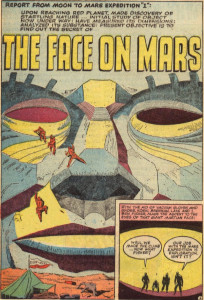 The sublime is highly relevant to psi, I believe. It happens to be precisely these kinds of sublime scenes and situations—including fires, shipwrecks, natural disasters, and haunted ruins in a dead landscape—that have always dominated people’s spontaneous accounts of ESP experiences. The many dreams and prophecies of the Titanic or 9/11 are examples, as are many of the “phantasms of the living” catalogued by the Society for Psychical Research in the 1880s. Thus it is not surprising that at least two prominent artists notably seem to have precognized the Face on Mars, the most famous “space ruin.” The best known, thanks in large part to Chris Knowles, is comic artist Jack Kirby, who wrote and illustrated a story called “The Face on Mars” in 1958—in which astronauts to the Red Planet explore a massive stone face and one of them receives a mind-transmission hologram showing the interplanetary war that laid waste the planet long ago. Kirby not only “saw” the face, in other words, but the whole meme-complex that formed around it (ancient planetary war and destruction).
The sublime is highly relevant to psi, I believe. It happens to be precisely these kinds of sublime scenes and situations—including fires, shipwrecks, natural disasters, and haunted ruins in a dead landscape—that have always dominated people’s spontaneous accounts of ESP experiences. The many dreams and prophecies of the Titanic or 9/11 are examples, as are many of the “phantasms of the living” catalogued by the Society for Psychical Research in the 1880s. Thus it is not surprising that at least two prominent artists notably seem to have precognized the Face on Mars, the most famous “space ruin.” The best known, thanks in large part to Chris Knowles, is comic artist Jack Kirby, who wrote and illustrated a story called “The Face on Mars” in 1958—in which astronauts to the Red Planet explore a massive stone face and one of them receives a mind-transmission hologram showing the interplanetary war that laid waste the planet long ago. Kirby not only “saw” the face, in other words, but the whole meme-complex that formed around it (ancient planetary war and destruction).
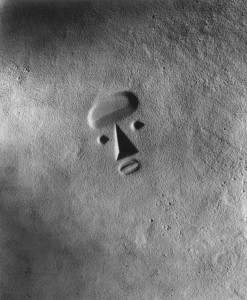 Eleven years earlier, in 1947—almost three decades before the Face was imaged by Viking—the Japanese-American sculptor Isamu Noguchi created a one-foot-square sand model for an earthwork called “Sculpture to be seen from Mars” and took a photograph of his model. All we now have is that photo, and it looks uncannily like Viking’s photograph, including the tilt at which it appears in the artist’s photo. The proposed dimensions of the earthwork, to be built in some “unused area” like a desert, are of a similar scale (Noguchi’s face was to be ten miles long, its nose a mile in height; the actual “Face” mesa in the Cydonia region on Mars is a little over a mile long). But more uncanny than the physical resemblance is the purpose of Noguchi’s earthwork: to signal the human presence to the cosmos in the aftermath of our species’ demise in a nuclear holocaust. It was, Noguchi said, “a requiem for all of us who live with the atom bomb.” At the time, following the destruction of two Japanese cities by such weapons, Noguchi worried that a world-destroying conflict was inevitable.
Eleven years earlier, in 1947—almost three decades before the Face was imaged by Viking—the Japanese-American sculptor Isamu Noguchi created a one-foot-square sand model for an earthwork called “Sculpture to be seen from Mars” and took a photograph of his model. All we now have is that photo, and it looks uncannily like Viking’s photograph, including the tilt at which it appears in the artist’s photo. The proposed dimensions of the earthwork, to be built in some “unused area” like a desert, are of a similar scale (Noguchi’s face was to be ten miles long, its nose a mile in height; the actual “Face” mesa in the Cydonia region on Mars is a little over a mile long). But more uncanny than the physical resemblance is the purpose of Noguchi’s earthwork: to signal the human presence to the cosmos in the aftermath of our species’ demise in a nuclear holocaust. It was, Noguchi said, “a requiem for all of us who live with the atom bomb.” At the time, following the destruction of two Japanese cities by such weapons, Noguchi worried that a world-destroying conflict was inevitable.
So here again, an artist seems to have prophesied not only a famous object/photograph but also the sublime meme complex surrounding it—although in Noguchi’s version, Mars and Earth swapped roles.
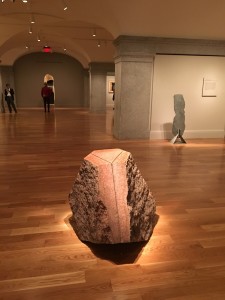 Noguchi was still alive and active in 1976, and right up to his death in 1988. He was intensely interested in science and technology all his life, including both nuclear weapons and space exploration. His 1970 granite sculpture Re-Entry Cone (right) is clearly based on an Apollo Command Module; one of his last works was a Miami monument to the astronauts killed in the Challenger disaster. So there is no doubt in my mind that he would have been aware of and interested in the Viking missions as well as the resurgent concerns about nuclear war during the Reagan era, when the ‘Face on Mars as remnant of a destroyed Martian civilization’ meme took shape. My regular readers will know that I think precognition centers on future exciting encounters and learning experiences during an individual’s lifetime. Kirby too was still alive and active at the time of the Viking missions and through the 1980s, dying in 1994 (and his comic would not have been influenced by Noguchi’s proposed sculpture, since the latter only existed in a single unpublished photograph).
Noguchi was still alive and active in 1976, and right up to his death in 1988. He was intensely interested in science and technology all his life, including both nuclear weapons and space exploration. His 1970 granite sculpture Re-Entry Cone (right) is clearly based on an Apollo Command Module; one of his last works was a Miami monument to the astronauts killed in the Challenger disaster. So there is no doubt in my mind that he would have been aware of and interested in the Viking missions as well as the resurgent concerns about nuclear war during the Reagan era, when the ‘Face on Mars as remnant of a destroyed Martian civilization’ meme took shape. My regular readers will know that I think precognition centers on future exciting encounters and learning experiences during an individual’s lifetime. Kirby too was still alive and active at the time of the Viking missions and through the 1980s, dying in 1994 (and his comic would not have been influenced by Noguchi’s proposed sculpture, since the latter only existed in a single unpublished photograph).
The Sublime Semiotics of Prophecy
The sublime, or aesthetic pleasure in signs of destruction, is essentially identical to the Lacanian notion of jouissance and to the older Freudian notion of “death drive.” It was Freud who most brilliantly theorized these childhood roots of the sublime. In his 1920 essay Beyond the Pleasure Principle, Freud described watching his toddler grandson repeatedly throwing a spool over the side of his crib and exclaiming “fort” (gone), then pulling it back and enjoying its return, “da” (there), and then doing the same thing with his own reflection in a mirror. Playing with loss and recovery is a way of conceptually mastering the idea of nothingness/annihilation. Paintings of sublime scenes stage this same pleasure at annihilation-and-return, losing and finding again, but on a grander scale.
This sense of “but I survived” is the basis of the sublime, the semiotic language of prophecy.
As I argued in the context of Thomas Pynchon’s prescient-about-prescience novel Gravity’s Rainbow (about an American officer whose sexual response anticipates V2 strikes during the Blitz), the “psi reflex” really orients to rewards, not only sexual rewards (as in Daryl Bem’s and Dean Radin’s presentiment experiments involving erotic pictures) but also the reward of surviving some chaotic or entropic threat. Although psychical phenomena and ESP have always been linked to “trauma,” this notion masks the fact that they really seem to key in on signals of survival: Implicitly, if you’re traumatized, then you’ve survived. If psi, as precognition, is a biological function, it has to have emerged and prevailed as an adaptive trait, orienting the organism toward its own future survival/reproduction or that of its kin.
 This sense of “but I survived” is the basis of the aesthetic sublime: Enjoyment of the fact that I’m still here, even amid these signs of ruin. It is why the sublime perfectly describes the semiotic language of prophecy. Some of those on the Star Gate remote viewing project, such as Edwin May and Dale Graff, have argued that our psi faculty keys in on actual entropy gradients like fires, explosions, and nuclear reactions. The accuracy of remote viewers when assigned such targets is a crucial fact, but it misses the important point that signs of entropy in the past, or symbols of entropy that never really existed, may be just as vivid to our psi eyes as the real thing.* I suspect psi, as precognition, is a fundamentally semiotic phenomenon, involving a sensitivity to associatively encoded information refluxing from the brain’s own future and not entropic ripples through spacetime.
This sense of “but I survived” is the basis of the aesthetic sublime: Enjoyment of the fact that I’m still here, even amid these signs of ruin. It is why the sublime perfectly describes the semiotic language of prophecy. Some of those on the Star Gate remote viewing project, such as Edwin May and Dale Graff, have argued that our psi faculty keys in on actual entropy gradients like fires, explosions, and nuclear reactions. The accuracy of remote viewers when assigned such targets is a crucial fact, but it misses the important point that signs of entropy in the past, or symbols of entropy that never really existed, may be just as vivid to our psi eyes as the real thing.* I suspect psi, as precognition, is a fundamentally semiotic phenomenon, involving a sensitivity to associatively encoded information refluxing from the brain’s own future and not entropic ripples through spacetime.
It was a big aha moment in my own study of precognitive dreams when I realized that sublime signifiers like ruins, as well as fossils and other “subterranean” images, which in Freudian and Jungian dream interpretation are easily taken as signs of past-ness, actually seemed to be pointers of a precognitive or future meaning. (I strongly recommend others engaged in precognitive dreamwork check to see if this holds for them as well.) It makes a counterintuitive sense: Ruins and fossils and bones and caves and other “buried” things are things awaiting discovery. They are fragments of some story still latent in the landscape, and thus they lie in one’s future, not one’s prior history. Our “unconscious minds” (whatever that means) understand this, even if our conscious selves don’t.
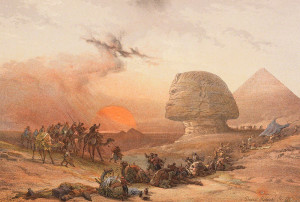 Culturally conditioned assumptions about time and memory, the persistence of the past, and the metaphoric likening of remembering to excavating traces left in the earth, have always distorted our perception of cognitive processes and only helped obscure the precognitive dimension of mental functioning. Centuries of psychology and philosophy have focused on how we are ruled by our past, without considering how the memory and history might be masks concealing our prophetic nature.
Culturally conditioned assumptions about time and memory, the persistence of the past, and the metaphoric likening of remembering to excavating traces left in the earth, have always distorted our perception of cognitive processes and only helped obscure the precognitive dimension of mental functioning. Centuries of psychology and philosophy have focused on how we are ruled by our past, without considering how the memory and history might be masks concealing our prophetic nature.
Another aspect of the sublime is extreme contrast: Pictures or stories conveying enormity versus smallness, eternity versus the immediate, and extreme age versus newness/futurity provoke this uneasy fascination with our own finitude. Noguchi’s work was sublime in exactly this sense: It savored the contrast between immensity and intimacy, alienness and familiarity, technology and nature. Hayden Herrera suggests that, in addition to being a memorial for humanity, bringing two planets and two ideas, the new and old, into juxtaposition, the face may also have been meant as a monument to Noguchi’s father, Yone Noguchi, who had died that same year (1947) in Japan. I would suggest that these immediate inspirations—grief over his father and the possible demise of humanity—acted as a concrete nucleus “constellating” a sublime premonition of the Face on Mars.
The Face on Mars was eminently psi-worthy, a kind of cosmic ‘fort-da’ in which humanity seemed to find, impossibly, its own reflection but also a distressing mirror of its own mortality, on a distant world. Multiple artists’ encounters with this haunting image seem to have rippled back in time along the resonating string of their creative jouissance.
A Religion of the Void
The Face on Mars always reminds me of one of the most famous Zen koans: “What was your original face before your mother and father were born?”**
One of the most characteristic motifs in sci-fi is the idea of traveling to the ends of the universe and finding something of our own that we have lost or forgotten.
Credit for bringing Zen to America is always given to Daisetz Suzuki, who in turn influenced popularizers like Alan Watts. As Kay Larson notes in her wonderful book Where the Heart Beats, the musician John Cage also did much to explicate Suzuki’s ideas for the art world, not only in his music but also in his books and lectures. But I think it was Cage’s friend Noguchi who probably deserves even more credit for the silent Zen transmission … to America and to science fiction. Zen, with its emphasis on Void and Nothingness, is the most sublime as well as the most science-fictional of religions.
 Zen is famously a wordless transmission: According to legend, the disciples all gathered to hear Sakyamuni Buddha deliver a sermon, but all he did was pick up a flower and twirl it in his fingers. Just one disciple, Kashyapa, “got it” and made a little smile. This was the birth of Zen. (In Japanese, the “Flower Sermon” is called nengemisho, literally “pick up flower, subtle smile.”) Every aspect of mid-century design in America was influenced by Noguchi’s work and is thus a wordless transmission of Zen not unlike the Buddha’s holding up of the flower. His techno-organic minimalist coffee tables and his Akari lamps are way more Zen, in a truly sublime way, than the famously Zen-inspired designs of Apple products, and America “got it” without even knowing. Noguchi’s designs were hugely influential. My apartment was full of cheap Ikea Akari-inspired lamps, for instance, long before I knew about Noguchi.
Zen is famously a wordless transmission: According to legend, the disciples all gathered to hear Sakyamuni Buddha deliver a sermon, but all he did was pick up a flower and twirl it in his fingers. Just one disciple, Kashyapa, “got it” and made a little smile. This was the birth of Zen. (In Japanese, the “Flower Sermon” is called nengemisho, literally “pick up flower, subtle smile.”) Every aspect of mid-century design in America was influenced by Noguchi’s work and is thus a wordless transmission of Zen not unlike the Buddha’s holding up of the flower. His techno-organic minimalist coffee tables and his Akari lamps are way more Zen, in a truly sublime way, than the famously Zen-inspired designs of Apple products, and America “got it” without even knowing. Noguchi’s designs were hugely influential. My apartment was full of cheap Ikea Akari-inspired lamps, for instance, long before I knew about Noguchi.
 They were partly influential through the vehicle of science fiction. I think Noguchi shaped the iconography of mid- to late-century SF more than anybody realizes: His sculptures from the 1940s (such as Remembrance, right) are direct precursors of Richard Powers’ pulp sci-fi covers of the 1950s and 1960s for example—they are the same techno-organic forms, rendered solidly in metal and stone instead of paint. Noguchi’s furniture, such as his classic coffee table (below), could be models for alien furnishings used throughout the original Star Trek series. And several of Noguchi’s stone and clay sculptures could easily be the model for the aeons-old star gate in the iconic Star Trek Season One episode “The City on the Edge of Forever.” If H.R. Giger’s “biomechanoids” came to define alienness post-1979, it was the more enigmatic and cerebral Zen-inspired forms created by Noguchi and transmitted via Star Trek and SF book covers that defined it prior to that.
They were partly influential through the vehicle of science fiction. I think Noguchi shaped the iconography of mid- to late-century SF more than anybody realizes: His sculptures from the 1940s (such as Remembrance, right) are direct precursors of Richard Powers’ pulp sci-fi covers of the 1950s and 1960s for example—they are the same techno-organic forms, rendered solidly in metal and stone instead of paint. Noguchi’s furniture, such as his classic coffee table (below), could be models for alien furnishings used throughout the original Star Trek series. And several of Noguchi’s stone and clay sculptures could easily be the model for the aeons-old star gate in the iconic Star Trek Season One episode “The City on the Edge of Forever.” If H.R. Giger’s “biomechanoids” came to define alienness post-1979, it was the more enigmatic and cerebral Zen-inspired forms created by Noguchi and transmitted via Star Trek and SF book covers that defined it prior to that.
 Science fiction has always been the genre most suited to expressing the sublime. One of the most, if not the most, characteristic motifs in sci-fi is the idea of traveling to the ends of the universe (via the most futuristic technology) and finding something of our own that we have lost or forgotten, something belonging to the past, even something impossibly ancient. How many Star Trek episodes had this basic premise: finding some relic of Earth’s spacefaring past, encountering (impossibly) some figure from Earth’s history or a planet whose civilization is based on some Earth society, or meeting some simulacra of a lost love? When Dave Bowman travels through the Jovian stargate only to find himself in a French Rococo hotel suite, or when Kris Kelvin travels all the way to Solaris only to find his dead ex girlfriend, these are all expressions of this same idea.
Science fiction has always been the genre most suited to expressing the sublime. One of the most, if not the most, characteristic motifs in sci-fi is the idea of traveling to the ends of the universe (via the most futuristic technology) and finding something of our own that we have lost or forgotten, something belonging to the past, even something impossibly ancient. How many Star Trek episodes had this basic premise: finding some relic of Earth’s spacefaring past, encountering (impossibly) some figure from Earth’s history or a planet whose civilization is based on some Earth society, or meeting some simulacra of a lost love? When Dave Bowman travels through the Jovian stargate only to find himself in a French Rococo hotel suite, or when Kris Kelvin travels all the way to Solaris only to find his dead ex girlfriend, these are all expressions of this same idea.
Whenever a Noguchi exhibition comes to one of the Smithsonian museums in Washington DC, like the “Archaic/Modern” exhibit currently at the American Art Museum, I walk among his sculptures and pottery and lamps and furniture with a sense of familiarity; this is the sublime sci-fi aesthetic of my childhood. It is precisely the comfort of that aesthetic (and not the ever-nauseating autumn leaves and sand gardens and bald kneeling monks) that led me to Zen when I was an adult. Zen is a sci-fi religion, totally portable and baggage-free, thus the perfect religion for space travel—a religion of the Void.
Zen is also a psi religion. Zen comes from dhyana, which just means meditation; meditation (along with dream recording) is an essential practice for developing an awareness of our precognitive functioning. As I’ve hectored you before: If you don’t have a meditative practice (whether Zen or Dzogchen or TM or something), what are you waiting for?
Ancient Faces in the Clouds of Causality
Although it is more speculative, another artist who might join Kirby and Noguchi in the MFC, the Mars Face Club, is Ron Walotsky, an illustrator best known for doing most of the covers for the Magazine of Fantasy and Science Fiction as well as many SF book covers from the late 1960s through the end of the millennium. His cover for a 1970 Pyramid Books edition of Arthur C. Clarke’s Against the Fall of Night shows a cracked landscape with an enormous upturned face earthwork on the horizon.
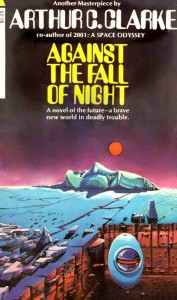 Clarke’s novel, originally written in 1953, is about a young man’s journey outside his protected city on a far-future Earth, long since devastated by an interplanetary war. There is no face in the story like the one on the cover—Walotsky, in the tradition of Powers, was embellishing—yet the whole novel is clearly on the same themes as the Face on Mars meme: the sublime contrast of ancient and futuristic, distance and intimacy, as well as dim memory of an ancient aeons-ago conflict. An ancient face gazing up at the stars seems to suggest a remnant of a civilization that once looked outward (and forward) but long since withdrew and stagnated.
Clarke’s novel, originally written in 1953, is about a young man’s journey outside his protected city on a far-future Earth, long since devastated by an interplanetary war. There is no face in the story like the one on the cover—Walotsky, in the tradition of Powers, was embellishing—yet the whole novel is clearly on the same themes as the Face on Mars meme: the sublime contrast of ancient and futuristic, distance and intimacy, as well as dim memory of an ancient aeons-ago conflict. An ancient face gazing up at the stars seems to suggest a remnant of a civilization that once looked outward (and forward) but long since withdrew and stagnated.
Revitalizing human civilization after untold years of stagnation in some protected enclave or a global dark age is nearly as common a motif in SF as far journeying only to find one’s past, and the motifs are often found together. The end of Planet of the Apes or Logan’s Run come to mind here, of course. Walotsky died in 2002; whether he was precognizing the Face on Mars when he did his illustration or was simply inspired by somewhat similar images in then-recent SF, such as the Statue of Liberty on the beach in Planet of the Apes, is impossible to say.
But the more I delved into Walotsky and his life and work, the more interesting I found him. His work is full of images of masks, for one thing, and his most interesting fine-art works were real masks made from the shells of horseshoe crabs. He described that his initial inspiration for this series, which he called “Ancient Warriors of Lost Civilizations,” came from staring at one of these shells one day, and it appeared to him like a face—in other words, the same pareidolia that led people to see a face in an eroded Martian mesa.
 Walotsky honored this vision with his masks from the late 1980s up until his death, perhaps not consciously recalling the very real “source” for this idea that, as someone with a love of space and science fiction, he would undoubtedly have seen: Carl Sagan’s Cosmos series in 1980, specifically the segment in Episode Two about the Heike crabs of the Inland Sea in Japan. The 1185 battle of the Heike clan against the Genji clan was fought on the shores of this sea, and a species of crab with a wrinkled carapace occasionally produced specimens that seemed face-like. These were preferentially saved from the fishermen’s nets, tossed back into the water (fort-da again!) … and thus an inadvertent selective breeding, over the centuries, led to a prevalence of crabs with a samurai grimace, believed in folk tradition to be ghosts of the Heike warriors.
Walotsky honored this vision with his masks from the late 1980s up until his death, perhaps not consciously recalling the very real “source” for this idea that, as someone with a love of space and science fiction, he would undoubtedly have seen: Carl Sagan’s Cosmos series in 1980, specifically the segment in Episode Two about the Heike crabs of the Inland Sea in Japan. The 1185 battle of the Heike clan against the Genji clan was fought on the shores of this sea, and a species of crab with a wrinkled carapace occasionally produced specimens that seemed face-like. These were preferentially saved from the fishermen’s nets, tossed back into the water (fort-da again!) … and thus an inadvertent selective breeding, over the centuries, led to a prevalence of crabs with a samurai grimace, believed in folk tradition to be ghosts of the Heike warriors.
The Heike crabs, with their warrior faces, are more than a bit like the Face on Mars—living monuments of an ancient destructive war. But these “ghosts” have also been shaped, sculpted, precisely by generations of human selection. There are no real ghosts, in other words, only a subtle and accelerated Darwinian process, abetted by pareidolia and forgetting—just as Walotsky may have seen and forgotten a fascinating/haunting segment in a PBS series and taken inspiration from it in his art.
Since it is only ever confirmed in hindsight, skeptics can always make a similar argument against the reality of precognition: It is the retrospective view on the past, inevitably reframed by salient events, that produces seeming prophecies, faces in the clouds of causality. The first task in the study of prophecy is establishing the extent to which our own activity in the present, scouring the past for precedents and selecting them out of a larger mass of irrelevancies, actually produces alleged coincidences instead of simply discovering them. When assessing Walotsky’s cover illustration for Against the Fall of Night, I lean toward “mere coincidence” rather than precognitive inspiration … but there is never any way to be sure.
NOTES
* Here’s a good example. One night in the Summer of 2013 (August 9, to be exact) I recorded in my dream diary: “hypnagogic vision of an old but crisp/unread paperback from the 70s about some esoteric science-fictioney topic, with a dark blue or black, orange, and red starburst cover.” The concentric colorful radiating circles suggested an explosion of light or perhaps consciousness; the next morning I went to my bookshelf to pull out an old pulp collection by Alfred Bester called Starburst, but the cover showed a moon of Mars and a rocket, nothing like in my vision.
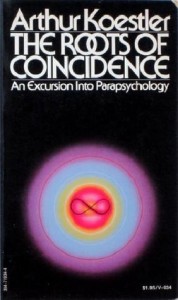 The very next day, on August 10, I was in an unfamiliar city, Providence, RI, on a trip with my wife’s family, and as I always do in new towns, I immediately gravitated to the used bookstores. Perusing the occult section of Paper Nautilus bookstore on South Angell Street, my eye fell on the black spine of The Roots of Coincidence by Arthur Koestler and I slid it out, astonished to find that it had nearly the exact cover I had seen on drifting to sleep two nights earlier. The colors were slightly more dark and muted, and there was a small infinity symbol in the center that I had not seen; but otherwise it was the same concentric starburst design in the lower two thirds of an otherwise black cover, the same familiar 1970s paperback size and feel and smell and typography, and it was on precisely the somewhat science-fictional themes that were then obsessing me. (Although I knew Koestler as a journalist on political topics, I was then unaware that the study of ESP and coincidences had dominated his interests during the last couple decades of his life.)
The very next day, on August 10, I was in an unfamiliar city, Providence, RI, on a trip with my wife’s family, and as I always do in new towns, I immediately gravitated to the used bookstores. Perusing the occult section of Paper Nautilus bookstore on South Angell Street, my eye fell on the black spine of The Roots of Coincidence by Arthur Koestler and I slid it out, astonished to find that it had nearly the exact cover I had seen on drifting to sleep two nights earlier. The colors were slightly more dark and muted, and there was a small infinity symbol in the center that I had not seen; but otherwise it was the same concentric starburst design in the lower two thirds of an otherwise black cover, the same familiar 1970s paperback size and feel and smell and typography, and it was on precisely the somewhat science-fictional themes that were then obsessing me. (Although I knew Koestler as a journalist on political topics, I was then unaware that the study of ESP and coincidences had dominated his interests during the last couple decades of his life.)
Finding Koestler’s surprising book was quite a reward, and it proved to be a crucial touchstone for me in my thinking and writing about chance and coincidence. But more importantly, it was just the first of many examples I have recorded of entropic images and symbols I have encountered in my reading, most often on the Internet, soon after receiving some kind of psychic preview in my dreams or hypnagogic states. A picture merely suggesting a entropic event like an explosion is just as fascinating to the precognitive unconscious as a real one.
** Implicit in Zen’s “What was your original face?” is an invitation to make that face. Hint: We carry much of our stress, as well as much of what we are thinking or feeling, in our face. It produces a noticeable felt shift, a profound centering, just to become conscious of whatever grimace your face has hardened into and just “blanking” the face—erasing it of all expression, completely relaxing all facial muscles.
For some, the jury is still out on what the Face on Mars is. But all of it, the whole meme, including the uncertainty, should help solve the koan about your original face. Be like the face on Mars: ancient, impassive, alien, and empty—and possibly, no actual “face” at all.
Zen, Signs, and the Arrival of Meaning
Even though they were widely panned when they came out and have now been mostly forgotten, I have a soft spot for M. Night Shyamalan’s films from the early 2000s—Unbreakable, Signs, and The Village. Signs, especially, I thought was a satisfying, intimate-scale sci-fi film about alien invasion, but it lost many of its viewers by the end because the aliens were a bit cheesy, as was the ultimate message. This is always Shyamalan’s problem: He frequently has interesting paranormal premises but can never quite pull off making them believable; you kind of have to see through the faults to appreciate what he’s attempting.
Zen is the religion of our future precognitive selves. When we step out of the linear world of desire, we enter the circular world of enjoyment, taking immense pleasure in things just as they are.
“Synchronicity” is the ideology of most Hollywood cinema, and Shyamalan is blatant about pushing belief in it as the moral of the story in Signs. After his wife’s death, Mel Gibson’s character (a former Episcopal priest) has lost his faith, no longer believes anything has meaning, etc. His kids and his younger brother (Joaquin Phoenix) hate him for this. But in the end, he rediscovers his faith in “signs” (i.e., synchronicity) when his family is threatened. He beats the alien intruder in his home by piecing together the random flotsam of his family members’ foibles into a coherent, life-saving message that the universe was all along trying to send him: his wife’s dying words that his brother, a former failed baseball player, should “swing away,” plus his daughter’s constant annoying habit of leaving half-drunk glasses of water around the house. He realizes his brother just needs to splash the alien with a glass of water using his baseball bat and then go to town on it. (I suppose, when you put it that way, it is kind of dumb.)
Denis Villeneuve’s recent masterpiece Arrival reminds me of all the best things about Signs minus the overreach, cheesiness, and problematic message. For one thing, Signs’ slow, suspenseful opening act, centered on one family’s experience, via the media, of the ominous appearance of UFOs over major cities, might as well be the template for the first act of Arrival. The structure of both films—telling the story of a tense and uncertain “first contact” via a character living under the shadow of loss—is the same; both films tack back and forth between the present alien conflict and “flashbacks” of the death of a loved one. And nearly identical to Signs is the way Louise Banks (Amy Adams’ character) in Arrival solves the problem facing her and humanity by realizing the true meaning of her random thoughts, which she had previously overlooked or misinterpreted.
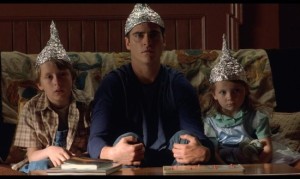 In other words, Arrival is like a permutation of the same set of thematic elements or mythemes (including even somebody’s wife’s dying words playing a key role), but they are rearranged into a much more compelling narrative in which the “meaningful events” that seem like the standard tragic Hollywood backstory (dying family member, etc.) in fact emerge as a story the character chooses, warts and all, in her future—a forestory. As I mentioned in my previous post, I don’t agree that precognition could ever be so conscious or clear as depicted in Arrival; but I admire the effort and the fact that Villeneuve told a much more interesting cinematic story on these themes than most other directors would have. The “uplift” at the end of the film is just right: a brief and inspiring peek into a world where we realize that we are prophetic beings but just don’t know it. I obviously really believe this is true—there is abundant evidence for it, both experimental and anecdotal.
In other words, Arrival is like a permutation of the same set of thematic elements or mythemes (including even somebody’s wife’s dying words playing a key role), but they are rearranged into a much more compelling narrative in which the “meaningful events” that seem like the standard tragic Hollywood backstory (dying family member, etc.) in fact emerge as a story the character chooses, warts and all, in her future—a forestory. As I mentioned in my previous post, I don’t agree that precognition could ever be so conscious or clear as depicted in Arrival; but I admire the effort and the fact that Villeneuve told a much more interesting cinematic story on these themes than most other directors would have. The “uplift” at the end of the film is just right: a brief and inspiring peek into a world where we realize that we are prophetic beings but just don’t know it. I obviously really believe this is true—there is abundant evidence for it, both experimental and anecdotal.
These similarities, but crucial differences, between Signs and Arrival are really instructive for clarifying the difference that I have tried to persuade people about on this blog: between the Jungian “everything is (already) meaningful” idea—which can only ever ultimately amount to a kind of reassuring but empty metaphysical oatmeal or, at worst, the basis for manipulation and religious dogma—and the more challenging, more thought-provoking, and more liberating perspective of Arrival, that meaning always is something that arrives from the future. We make our lives meaningful, and renew those meanings in our actions; and our best and most creative insights seem to come from reaching into the Not Yet in obscure and subtle ways.
Going in Circles
The fact that our moral and spiritual lives must be a constant active project, not just finding meaning ready-made, is a deep irony, given the objection most often raised against a universe in which fate and foreknowledge exist: If everything is predestined, why get up in the morning and do anything? Why lift a finger, since everything will happen anyway?
The predestined future includes all your “freely willed” actions that bring it about. There is no escaping the responsibility of action.
A moment’s thought reveals the fallacy there: If you don’t reach and pick up your spoon, your oatmeal will not magically levitate to your mouth. The predestined future includes all your “freely willed” actions that bring it about. There is no escaping the responsibility of action. The notion of ‘just lying in bed because what’s the point’ is to be beguiled by an image, a stage-representation of passivity, not anything real.
Predestination, the Minkowski block universe, fate, wyrd, post-selection, whatever you want to call it, presents a koan, forces us to confront the real meaty question: Instead of “do I or don’t I have free will?”—a canard—the more pertinent thing you should ask yourself is, “who am I to even ask this question?” … as well as “what should my attitude be?” Hint: In my Twitter feed, the wonderful @BabaRamDass is always advising that we adopt a spectatorial role in our lives, to identify with the witness of our actions and not the “actor.” He’s right. When you really make a practice of this, it has a transformative effect. Mysteriously, it doesn’t make you any more “passive”—the opposite, in fact.
It seems no accident that (as my wife pointed out when we saw Arrival) the heptapods’ glass screen is the same dimensions as a movie screen, and the whole experience of the film is staged to express the idea that we are basically spectators of something. This seems like a nod to Kubrick, who did the same thing in 2001—the slab is like an up-ended movie screen, and many of that film’s major moments are also spectacles or demonstrations that are watched or witnessed. “Witnessing” seems indeed to be the attitude of the heptapods toward their own existence; “If they’re scientists, they don’t ask very many questions,” as Jeremy Renner’s narration puts it during the montage.
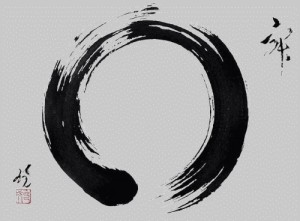 Although the choice faced by Louise Banks at the end of Arrival is particularly stark (for the purposes of telling a good story, you have to make these choices stark), and although, again, precognition would never be as vivid and clear as it is portrayed, I agree with the Zen message of the film: Life is in the enjoying of it, however things turn out. This is I believe precisely how precognitive creatures would approach life, and why I do believe Zen is the religion of our future precognitive (or, somewhat more precognitive) selves. When we step out of the world of desire (aims, goals, ambitions, cravings), which is linear and ultimately the source of frustration and suffering, we enter the world of enjoyment, which is circular/directionless and takes immense pleasure in things just as they are. I’m sure it was intentional that the Heptapods’ written language as portrayed in the film so closely resembles the brushstroke circles that are ubiquitous in Japanese Zen art and Zen book covers.**
Although the choice faced by Louise Banks at the end of Arrival is particularly stark (for the purposes of telling a good story, you have to make these choices stark), and although, again, precognition would never be as vivid and clear as it is portrayed, I agree with the Zen message of the film: Life is in the enjoying of it, however things turn out. This is I believe precisely how precognitive creatures would approach life, and why I do believe Zen is the religion of our future precognitive (or, somewhat more precognitive) selves. When we step out of the world of desire (aims, goals, ambitions, cravings), which is linear and ultimately the source of frustration and suffering, we enter the world of enjoyment, which is circular/directionless and takes immense pleasure in things just as they are. I’m sure it was intentional that the Heptapods’ written language as portrayed in the film so closely resembles the brushstroke circles that are ubiquitous in Japanese Zen art and Zen book covers.**
Postscript: The Alien and Death
On his blog, David Halperin has a great post on Arrival, reading the story in terms of its interesting similarities to the UFO abduction literature, e.g., Strieber. He rereads the future events in Louise Banks’ visions as really past events (the way the viewer assumes throughout the first half of the film). Although I’m all for deconstructing paranormal stories by removing the paranormal element and seeing what you are left with, in this case it is only an interesting thought experiment; there is no evidence this is (at all) what the filmmaker, scriptwriter, or Ted Chiang had in mind.
Misrecognized precognition may be precisely what enables the brain to turn our denial of death into a paranormal experience.
Halperin doesn’t want to believe in precognition (or the paranormal in general) and thus finds the precognitive aspect of the story silly. Obviously I don’t agree, and I would cite ample experimental evidence in my defense here (and recommend he actually take the J.W. Dunne challenge before he dismiss precognition). But I do like his insights about the relationship of “the alien” and death, as part of the secret equation in these narratives. Somehow UFOs and aliens may be manifestations of our desperate denial of death, he suggests, and I think this is spot-on. Both Signs and Arrival draw the equivalence vividly. However, I think misrecognized precognition may be precisely what enables the brain to turn our denial of death into a paranormal experience.
For Halperin, the alien is the dead (imagined, conjured into being). What if the alien is instead the dying … ourselves, or our loved ones, in the future? Death is an “alien” thing, as Halperin says, and it is always by definition from the future that it arrives for us. Could some “alien encounters” be precognitive of a diminutive, frail, pallid, bald loved one dying of cancer, or ourselves in such a condition, seen in the mirror?
In Strieber’s collaboration with Jeff Kripal, The Super Natural, he acknowledges his recognition that the weirdly erotic feminine alien for which he is so famous was really somehow related to his wife Anne. It makes me wonder whether his “visitor experience” could have been informed partly by premonitions of Anne’s struggle with cancer decades later, and whether experiences of “greys” more generally are not precognitive of a distinctly new (in the late 20th Century) experience: caring for family members undergoing chemotherapy/radiation treatments. It can only be a hypothesis—the only way to examine this would be to look at family histories of “abductees,” both prior and subsequent histories. A tall order, I’m sure.
There is much in the abductee literature and Strieber’s own writings resembling the Victorian construct of hysteria, and in their classic 1895 text on the subject, Josef Breuer and Sigmund Freud noted that the origin of hysterical symptoms is often a period of caretaking in a patient’s past. For example in one case study, “Fraulein Elisabeth Von R.” developed hysterical leg pains after feeling sexual attraction for a man, which she denied expressing because she was then busy caring for her dying father. The conflict between the grave, self-denying business of caring for a mortally ill family member and sexual or otherwise life-affirming feelings that feel morally incompatible with that situation precipitates a “symptom.”
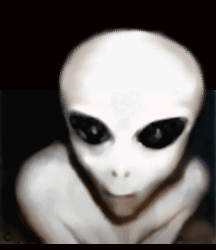 Precognitive symptoms originate from similar scenes, and similar conflicting emotions (which I have sometimes called “jouissance“), in a person’s future. The conflict might not only be sexual feelings, but also the most basic reward signal, “but I survived,” which is unbearable in the context of grief for a loved one (or shock at the loss of anonymous others, as in a disaster like the Titanic or 9/11). As I’ve argued elsewhere, it is precisely that sublime reward signal of survival in the context of loss or destruction that appears to become “displaced in time.” Because no one believes in precognition, those displaced emotions and experiences will almost always be misunderstood and misinterpreted.
Precognitive symptoms originate from similar scenes, and similar conflicting emotions (which I have sometimes called “jouissance“), in a person’s future. The conflict might not only be sexual feelings, but also the most basic reward signal, “but I survived,” which is unbearable in the context of grief for a loved one (or shock at the loss of anonymous others, as in a disaster like the Titanic or 9/11). As I’ve argued elsewhere, it is precisely that sublime reward signal of survival in the context of loss or destruction that appears to become “displaced in time.” Because no one believes in precognition, those displaced emotions and experiences will almost always be misunderstood and misinterpreted.
I wonder if it is our fear of death that leads us to fear and thus deny that our synchronicities and OOBEs and other paranormal experiences are really precognitive. Death is the ultimate bad thing lying in wait for us in our future. Among other tactics for beating death is simply killing (or ignoring) the messenger.
NOTES:
* The other film comparison that comes to mind with Arrival is Don’t Look Now, Nicolas Roeg’s 1973 masterpiece also on the theme of misrecognized precognition. In that narrative too, the inciting incident is the death of a child (such a scenario is, I suppose, low-hanging fruit for a storyteller who wants to establish ultimate loss and grief as the counterweight to subsequent events in a story about fate and foreknowledge); and as in Arrival, the psychic protagonist, the girl’s father John Baxter (Donald Sutherland), misrecognizes all subsequent premonitions as meaningless coincidences, including a vision of his wife that leads him to believe she was abducted, propelling him to his own murder.
Minus the full-on tragic dimension, this is really the way precognition works, particularly the way rationalists resolutely in denial of our more extraordinary natures will find themselves falling victim (usually in less consequential, merely annoying or neurotic ways) to the logic of the precognitive unconscious. The only “mistake” in Don’t Look Now is that (if I’m right) John Baxter would have seen and misinterpreted a vision of something preceding his death, not a vision of his funeral afterward.
** On the afternoon before first seeing Arrival, my thoughts for no apparent reason went to a Daisetz Suzuki lecture on those brushstroke circles that I had read about several years ago in the context of their influence on the composer John Cage; then in the movie, when the heptapods first produced their writing on the glass, I was happily amazed. This is precisely how precognition works—for all of us—a subtle skewing of our thoughts toward exciting and rewarding experiences in our (usually imminent) future. That same afternoon, the earworm in my head was a line from a Simon and Garfunkel song, “Somethin’ tells me it’s all happening at the zoo…”—also directly relevant to the climactic plot twist in Arrival.
Just pay attention—precognition is a constant process in our thoughts. And yes, by the very nature of the beast, it is usually impossible to prove that it’s not hindsight bias. Usually, but not always.
Altered States of Reading #6: Stories of Your (Future, Past) Life
Few films could better illustrate the workings of precognition than Denis Villeneuve’s excellent new film Arrival, based on a 1999 story “The Story of Your Life” by Ted Chiang. If you’ve seen the trailers, it will give nothing away that it is about a first-contact situation, and the attempt of a linguist, played by Amy Adams, to communicate with the visitors. It is only a slight spoiler to say that cracking the aliens’ code requires thinking differently about time. But do not read the rest of this post if you have not seen the film, as much depends on the twist ending that I am going to discuss.
Prophecy is a quiet, unconscious signal of reward on a noisy channel; you only really know it was prophecy, and see exactly how your actions had operated to fulfill it, after the fact.
The minor spoiler is that thinking in the aliens’ written language, “Heptapod B,” gives Amy Adams’ character an altered, precognitive vantage point. The big, very satisfying plot twist in Arrival rivals that in The Sixth Sense: The linguist’s realization about time reveals that what seems (at least to the viewer) like memories of her past are really visions of what is to come. That theme should be very familiar to readers of this blog.
One of the things Arrival gets right about prophecy is that it is not about events in some generalized future history, but about emotional upheavals, both major and minor, in our own future timeline. Future emotional experiences reflux backward and subtly inform our actions and our thoughts in the present. Adams’ character gets a crucial clue to her present situation from a vision of herself reading the book on Heptapod B that she is destined to write in her future. (In several of my posts I’ve described this “reading our own future writings” as a motor of creativity.) In the film’s climactic scene, she proves herself to the Chinese general by telling him his wife’s dying words, something she is able to do because he will remind her of this event, and of those words, months or years later at a gala in her honor. (This is the exact mechanism—producing information we will learn later—by which mediumship works, as I described in my recent post on that subject.)
However, linear human language is not the only (or even the main) thing standing in the way of accessing a broadened view of our own relation to time. For one thing, even if the future is set in stone, our awareness of it could only ever be oblique until events come to pass and it becomes clear in hindsight. Prophecy occurs in the future perfect tense: What we will have known, what will have turned out. It is an unconscious phenomenon.
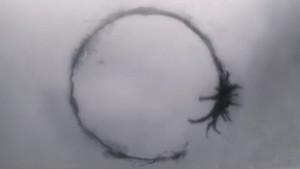 My only slight quibble with Arrival is that, once Adams’ character understands that she is seeing her own future, that future remains too clear to her, and thus theoretically too open to her intervention. She chooses it anyway, despite knowing it will have a sad outcome, and thus no harm done from a paradox point of view. In Chiang’s “The Story of Your Life,” the parts of the story that lie in the narrator’s future are told in the simple future tense: She feels compelled to fulfill her knowledge of what will come, because with the altered mindset of thinking in Heptapod B, outcomes take on a new kind of psychological necessity; it is satisfying to fulfill them. But by the necessary logic of post-selection, it really wouldn’t—and in my experience doesn’t—work that way.* Prophecy is a quiet, unconscious signal of reward on a noisy channel; you only really know it was prophecy, and see exactly how your actions had operated to fulfill it, after the fact. Future perfect, in other words, not simple future.
My only slight quibble with Arrival is that, once Adams’ character understands that she is seeing her own future, that future remains too clear to her, and thus theoretically too open to her intervention. She chooses it anyway, despite knowing it will have a sad outcome, and thus no harm done from a paradox point of view. In Chiang’s “The Story of Your Life,” the parts of the story that lie in the narrator’s future are told in the simple future tense: She feels compelled to fulfill her knowledge of what will come, because with the altered mindset of thinking in Heptapod B, outcomes take on a new kind of psychological necessity; it is satisfying to fulfill them. But by the necessary logic of post-selection, it really wouldn’t—and in my experience doesn’t—work that way.* Prophecy is a quiet, unconscious signal of reward on a noisy channel; you only really know it was prophecy, and see exactly how your actions had operated to fulfill it, after the fact. Future perfect, in other words, not simple future.
Whether we possess “free will” (and thus prophecy must remain an unconscious process because of that), or whether consciousness itself is an illusion, I don’t know. Those seem to some like the only philosophical options in a universe that includes retrocausation. I’m not so sure if that is the case, but I’m not that bothered by the problem: As a Zen-ist, I think both “free will” and “consciousness”—at least, as the terms are being used in the current culture scuffles around scientism and materialism (boo, hiss)—are MacGuffins. It doesn’t matter how we choose to talk (or write) about the human experience: Whether we say “the mind is material/based in the brain” or whether we say “it’s all consciousness,” doesn’t matter. Either way, we’re still here, the sun still rises in the morning, nothing has changed. Ceci n’est pas une pipe. No hay banda. It’s all a recording.
Simple Past Lives or Past Perfect Lives?
In an earlier installment I argued that supposed memories of past lives are more profitably thought of as prophecies of things we will learn in our future, using the fictional example of Max Ehrlich’s 1973 novel The Reincarnation of Peter Proud; the story works just as well, and indeed is just a tad more intellectually satisfying, thinking of it as a story about misrecognized precognition. (Phil Dick thought so too.)
Because precognition is so hard to think, the mind naturally grasps at the easier, linear-causal explanation: that a past life is being remembered in this one.
A vivid, real-life example susceptible to exactly such a reframing is police detective Robert L. Snow’s memoir of his own presumed past-life regression experience and his subsequent startling discovery of its meaning, Portrait of a Past Life Skeptic. At the start of the book, the past-life-curious Snow had read Coming Back by Raymond Moody, and while intrigued, was skeptical, given all he knew from his own work about the susceptibility of hypnosis subjects to false memory implantation.** But after a fortuitous encounter at a party with a therapist friend who told him her colleague conducted past-life regression in her practice, he accepted his friend’s dare to give the process a try and see for himself what he thought of it.
During the 45-minute, $60 session, which he tape recorded, Snow was stunned to find himself mentally transported back to the late 1800s, in the body of a painter, with vivid scenes of some of the art he had created, including a portrait of a woman with a hunchback. The vividness and “reality” of the experience was startling to him, and this compelled him to take the experiences seriously. He decided it should be a simple matter to scour art books at his local library and find the paintings he had seen, to gain verification that the experience was really based on cryptomnesia, artworks he had somehow seen and forgotten in his past. But weeks of investigation turned up nothing.
Then, a couple months later, Snow and his wife took a trip to New Orleans, where they idly visited some antique shops and art galleries. In the back of a small store, Snow was stunned to find the very portrait of the hunchback woman he had seen himself paint in his regression:
Whirling around, I stared open-mouthed at the portrait, reliving an experience I’d had once when I grabbed onto a live wire without knowing it, the current freezing me in my tracks as huge voltage surged up and down my arms and legs. Very similar to that experience, I simply stood frozen in the art gallery for what seemed like a long time, electricity racing up and down my arms as I stared at the portrait of the hunchbacked woman. …
Police officers don’t like to encounter startling coincidences, such as the finding of this painting, because we so very often find that these events are actually staged events made to look like coincidences. Yet I didn’t see how that could be the case in this situation.
The gallery owner was able to tell Snow the name of the artist, James Carroll Beckwith, along with a bit of information about his life. Snow then made Beckwith a “case,” uncovering considerable more information that corroborated details remembered and recorded in his regression experience, including where and when Beckwith had lived and died, awards he had won, and his general attitude to his career.
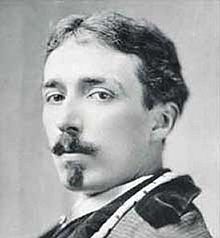 On a visit to the Indianapolis Museum of Art to gather more information on the artist, Snow encountered a second painting he had also seen during his regression, and experienced the same electric sensation. At every turn, each new discovery eroded further his initial conviction that he had simply produced those memories from some past encounter with Beckwith’s art that he had forgotten. For instance, during his regression he had found himself arguing with someone about the bad lighting on one of his paintings in an exhibition. He then found, reading Beckwith’s diaries, nine separate incidents of the artist “having a row” over bad lighting or display of his pictures. There was no way that, as someone with no prior experience or knowledge of art, he could have known about Beckwith in this degree of detail.
On a visit to the Indianapolis Museum of Art to gather more information on the artist, Snow encountered a second painting he had also seen during his regression, and experienced the same electric sensation. At every turn, each new discovery eroded further his initial conviction that he had simply produced those memories from some past encounter with Beckwith’s art that he had forgotten. For instance, during his regression he had found himself arguing with someone about the bad lighting on one of his paintings in an exhibition. He then found, reading Beckwith’s diaries, nine separate incidents of the artist “having a row” over bad lighting or display of his pictures. There was no way that, as someone with no prior experience or knowledge of art, he could have known about Beckwith in this degree of detail.
“It all fit,” Snow writes. “There was no one startling and gigantic fact, just one small confirmation after another.”
Thus the experience in the hypnotist’s office and the subsequent research project became for Snow much more than a case; it became something akin to a religious—or at least, metaphysical—conversion. Unable to imagine another explanation for the veridical nature of his “regression,” the detective braved potential ridicule and career hassles by writing and publishing a book on his experience as the basis for his newly-won conviction of the reality of past lives.
But even if it is less easy to wrap our heads around, there is another, even more parsimonious explanation for his experience, and it is precisely that of the plot twist in Arrival: All the information he assumed was a “memory” a previous existence over a century earlier was really information he would later discover or uncover in the course of a very exciting personal journey that was ahead of him in this lifetime. His book is a chronicle of these discoveries, and is perhaps even analogous to Amy Adams’ character’s future definitive study The Universal Language: Translating Heptapod B, which she consults in a key scene. Snow’s narrative, at every turn, is one of confirmation—of extracting and piecing together a “story latent in the landscape” he traversed. There were few details in his hypnosis session that were not confirmed in some way, which should to us be a tip-off that those confirmations were really possibly the source of his experiences during the hypnotic trance.
Prophetic Jouissance
Snow’s “confirmations” of material he had precognized were strikingly both unsettling and rewarding, the “jouissance” we see again and again with confirmations of psi experience. Unfortunately, because precognition is so hard to think, the mind naturally grasps at the easier, linear-causal explanation: that a past life is being remembered in this one. But we must not forget that that “past life” can only be confirmed in books and paintings and other sources of information the individual will encounter in the here and now—altered states of reading, yet again.
Misrecognized precognition could be a powerful, hitherto unexplored model of religious conversion and conviction.
What we need to assume as part of this is “time loops,” the crucial, paradoxical-seeming but in fact necessary PhilDickian nuance to the precognitive life. Snow might have encountered the hunchback portrait on his own, but he would not have done the subsequent research on Carroll had it not been for the regression experience that made the initial hunchback portrait encounter so uncanny. His research produced information that would pre-appear in that experience, and the journey was rewarding and thus precognized in a trance because of the unfolding excitement of solving a detective story … a detective story about a person he gradually came to believe was himself. As long as precognition is misrecognized as something else (e.g., “synchronicity” or “past lives”), and as long as it focuses on rewards, as I argue it always does even when it seems to be about “trauma,” then it will have a self-confirming tendency and thus not be paradoxical. No grandfathers harmed.
Some jolt toward personal growth is part of the excitement seen again and again in the most compelling synchronicity narratives, and it is the most basic kind of reward that precognition operates on. Carl Jung’s story of his patient’s precognitive dream about the scarab is, so to speak, the “archetypal” example. We are oriented toward exciting and validating discoveries in our future; the reward of a therapeutic insight or moment, suddenly feeling like a bigger, more complete and whole person, with greater self-knowledge—or what Jung called “individuation”—is a very powerful reward. This is why, as open-minded psychoanalysts like Jule Eisenbud noted, psi (as precognition) manifests so consistently in the therapeutic encounter; patients precognitively orient toward their own growth, not to mention pleasing their therapists by validating their theories.
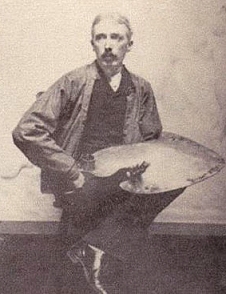 In Snow’s case, already in the first chapter of his book we have a significant detail about why this particular figure of James Carroll Beckwith might have resonated so strongly, and thus been so rewarding to learn about over the course of his detective adventure.
In Snow’s case, already in the first chapter of his book we have a significant detail about why this particular figure of James Carroll Beckwith might have resonated so strongly, and thus been so rewarding to learn about over the course of his detective adventure.
Snow, who is the author of several other books about police work, says he wanted to be a writer when he was young, and that he never had an aspiration to be a police officer. Yet life often has other plans for us, and his life took him down probably the most diametrically opposed path imaginable: into the military and then, because police work was a growth career at a time he needed a job, toward being a police detective.
The life of a portrait painter, delving into each sitter as an adventure in representation rather than a crime scene, reflects the same interest in the minutiae of human life as detective work, including its tragedies and pains (e.g., the woman with a hunchback), but it does so from an aesthetic point of view that Snow’s life path had never allowed him to express. We would note that, in the course of his investigation of and writing about Beckwith, Snow literally actualized or realized this other, softer—we might say “more right-brained”—side of his personality. (Snow also discovered that Beckwith, like him, had harbored certain disappointments and misgivings about his career, thus delving into this 19th-century artist’s life might have been like gazing into a strange kind of mirror, indeed almost a “bizarro” version of himself.)
Snow’s “past life regression” was thus, in all likelihood, really a precognitive experience of a richly rewarding midlife journey of personal growth and conversion toward an exciting—as well as reassuring—new way of thinking. Besides opening him to his previously unexpressed artistic side, it carried along with it the implication of immortality, which is something that everyone in midlife becomes highly concerned with. But we should not miss here how prone to (self-)deception and manipulation the therapeutic context may be around issues of anomalous memory, particularly when it involves techniques like trance. As has been shown by Jack Brewer in his recent The Greys Have Been Framed, the whole field of alien abduction “research” also has a lot to answer for, in this regard.
The fact that Snow was effectively “converted” by his experience to a new metaphysics (that of reincarnation) suggests to me that misrecognized precognition could be a powerful, hitherto unexplored model of religious conversion and conviction, a possibility I will explore in future posts.
Postscript
Detective Snow made an unfortunate mistake in his investigation: failing to purchase the hunchback painting (which the gallery owner promised he could have “for a reasonable price”). Even if it were expensive, it would have been worth it, establishing an essential habit I have discussed in previous posts: honoring and commemorating your psi (or more generally paranormal) experiences, even when it entails some kind of sacrifice.
When you establish a habit of honoring your psi experiences—in my case, it often involves a usually inexpensive purchase of some dreamed-about book on eBay, or taking the time to watch a dreamed-about TV show or movie—you are in fact creating the conditions for precognitive events to manifest more and more. Commemoration is part of the reward and “post-selection” that the precognitive faculty orients toward. Being a prophet means habitually or even ritualistically honoring your prophecy when it is fulfilled; that moment of “honoring” is frequently the temporal terminus of the time loop, the wellspring of prophetic jouissance.
NOTES
* An interesting detail in Chiang’s story that is left out of the film is that the crucial clue to unraveling the heptapods’ mindset and language comes from Fermat’s principle of least time, according to which light always takes the fastest possible path to its destination. It is the rule that accounts for refraction of light through different mediums like water or glass, and it is another example of a physical principle that makes no sense in the absence of retrocausation, since photons need to “know” where they are going in order to take the right path. Had I known about Fermat’s principle, I would have listed it among the various examples of retrocausation-suggestive phenomena in my last post. The sure tip-off of such phenomena is that they compel us to ask how particles or photons “know” what to do before they do it. (Thanks to Chris Savia, a real-life heptapod, for encouraging me to read Chiang’s story.)
** Recovery of repressed memories through hypnosis is total BS, as hopefully most anomalists are by now aware … although I suspect they aren’t. First, there is little evidence that ordinary traumas are “repressed” in the way that Freud suggested; people who have been sexually abused as children and whose abuse can be corroborated typically remember these events spontaneously, for instance after seeing a news report that puts a new “adult” framing on what until then had been a baffling and hard-to-understand childhood event. “Memories” recovered in hypnosis, on the other hand, are typically much less easily corroborated, suggesting they are not memories but something else. Critics of regression therapy point to a robust research literature in memory distortion and creation of false memories: Trance-induced experiences may be the product of a collusion—likely unconscious and unintended but nevertheless extremely dangerous—between the subject and the therapist. But trance is also a highly psi-conducive state, leading me to suspect that much of the supposed abduction material produced in hypnosis may be precognition of future events given a sci-fi-inflected framing by the therapist’s or their own cultural expectations.
The Time Eye: Nuts and Bolts of a Biological Future Detector
Rubbing my temples and squinting, I foresee that no less a science writer than James Gleick will very shortly be publishing a book called Time Travel. Unlike his most famous book, Chaos, which was incredibly forward looking—introducing a whole generation to a really cool new concept, “the butterfly effect” (i.e., the way a butterfly flapping its wings in Hong Kong influences the weather in New York a week later)—Time Travel is … er, will be … oddly backward looking, a retrospective view of H.G. Wells’ sci-fi trope and its impact on our culture. It will only barely, glancingly, remark on the emerging science that is destined to make time travel, or at least time-traveling information, a reality.
I foresee that despite brief obligatory musings on John Wheeler and wormholes, Gleick will use the word “retrocausation” only once in the book: “Retrocausation is now a topic,” he will say, and leave it at that. Mostly, he will reiterate again and again how time travel is obviously impossible, and that it’s only a meme, a literary device, a metaphor for our increasingly sped-up and time-obsessed society. Causes precede effects, and that’s that.
God really doesn’t play dice; he’s truly a master archer instead, a divine Legolas who can swiftly turn and shoot causal arrows in both directions.
I’m a big admirer of Gleick, but this will be a pretty unfortunate oversight on his part. Retrocausation is indeed a topic, one that is about to sweep over our culture like a tidal wave. How did he miss it?
The idea has been there from the beginning in modern physics’ upper echelons: Effects can theoretically precede their causes. But only in the past decade or so has the technology finally existed to test the idea. An increasing number of truly mind-blowing experiments are now confirming what Yakir Aharonov, for example, intuited already in the 1960s—that every single causal event in our world, every single interaction between two particles, is not only propogating an influence “forward” in the intuitive billiard-ball fashion but also carrying channels of influence backward from the future to the present and from the present to the past.
Until now, physicists have misinterpreted this whole half of causation as “randomness”—quantum indeterminacy. But Einstein never liked randomness as an inherent property of nature, and Aharonov wasn’t satisfied either. Newly developed experiments utilizing methods to “weakly measure” particles at one point in time and then conventionally measure a subset of them at a second, later point in time—or “post-selection”—are showing Aharonov was right and that Einstein’s intuitions were on the mark: God really doesn’t play dice; he’s truly a master archer instead, a divine Legolas who can swiftly turn and shoot causal arrows in both directions. Every interaction a particle has with its environment or with an experimental measurement apparatus perturbs seemingly “random” aspects of its behavior, such as its spin, at earlier points in its history. In 2009, a team at Rochester University actually used measurement of a portion of a laser beam at time point B (post-selection) to amplify those photons when measured, weakly enough to not disturb them too much, at an earlier time point A—retrocausation, in other words.
 Other hints of causality’s two-faced-ness have been staring physicists in their one-way faces for a long time. Take for example the curious phenomenon known as “frustrated spontaneous emission.” It sounds like an embarrassing sexual complaint that psychotherapy might help with; actually it is a funny thing that happens to light-emitting atoms when they are put in surroundings that cannot absorb light. Ordinarily, atoms decay at a predictably random rate; but when there is nothing to receive their emitted photons, they get, well, frustrated, and withhold their photons. How do they “know” there is nowhere for their photons to go? According to physicist Ken Wharton, the answer is, again, retrocausation: The “random” decay of an atom is really determined retrocausally by the receiver of the photon it will emit. No receiver, then no decay. As in the Rochester experiment, some information is being passed, via that emitted photon (whenever there eventually is one), backward in time.
Other hints of causality’s two-faced-ness have been staring physicists in their one-way faces for a long time. Take for example the curious phenomenon known as “frustrated spontaneous emission.” It sounds like an embarrassing sexual complaint that psychotherapy might help with; actually it is a funny thing that happens to light-emitting atoms when they are put in surroundings that cannot absorb light. Ordinarily, atoms decay at a predictably random rate; but when there is nothing to receive their emitted photons, they get, well, frustrated, and withhold their photons. How do they “know” there is nowhere for their photons to go? According to physicist Ken Wharton, the answer is, again, retrocausation: The “random” decay of an atom is really determined retrocausally by the receiver of the photon it will emit. No receiver, then no decay. As in the Rochester experiment, some information is being passed, via that emitted photon (whenever there eventually is one), backward in time.
Or consider entanglement, every anomalist’s favorite quantum quirk. When particles are created together or interact in some way, their characteristics become correlated such that they cannot be described independently of each other; they become part of a single entangled state. If you then send these two particles—photons, say—way far away from each other, even to the ends of the universe, they will behave identically when one of them is measured. If you measure photon A and find that it has certain spin or polarity, the other one is guaranteed to have an identical or corresponding value, as if they somehow communicated with each other long-distance to get their stories straight. This phenomenon was originally a prediction made by Einstein and two of his colleagues, Boris Podolsky and Nathan Rosen (collectively known as “EPR”), as a way to show that quantum physics must be incomplete. Entanglement seemed paradoxical, and thus impossible, because somehow it would involve information traveling between those particles at a speed faster than light (i.e., instantaneously), thus violating the theory of Relativity. Yet in 1964, a CERN physicist named John Bell published a theorem proving that the EPR prediction actually held; subsequent experiments supported the existence of such states.
As told by David Kaiser in his fascinating book How the Hippies Saved Physics, Bell’s theorem lies at the heart of today’s revolutions in quantum computing, telecommunications, and cryptography. However, no one has ever been able to explain how entanglement works; it is just another of those many quantum bizarreries that are supposed to be just taken on faith. But Cambridge University philosopher and specialist in the physics of time, Huw Price, thinks the answer is to be found, once again, in retrocausality: The measurement that affects one of the two entangled particles sends information back in time to the point when they became entangled in the first place; thus that future event in the life of one of the particles became part of the destiny of the other particle—a kind of zig-zagging causal path.
Every time a photon bumps into another photon, that bump doesn’t just alter or nudge the properties of those particles in a forward direction; it is a transformation and an exchange of information in both directions. To shift to the quantum computing idiom of someone like Seth Lloyd, it “flips bits,” correlating the measurable properties of those photons and sending information also into the past of both photons, to influence how each behaved the last time it interacted with another particle, and how those other particles behaved in their previous interactions … and so on, back to the beginning of the universe.
It is really important to think about all this correctly. It does not mean that, tucked away safely in a few laboratories there are funny, exceptional situations where trivial eensy weensy effects precede trivial eensy weensy causes. No, the entire “way things go” is a compromise or handshake agreement between the ordinary, easy-to-understand “one thing after another” behavior of things that Newton said was all there is, and another opposite vector of influence interweaving with and deflecting and giving shape to events, a vector of influence that Newton’s brilliantly persuasive Laws effectively hid from our view for three whole centuries. It took the first generation of quantum physicists to detect that Newton’s Laws were flawed, that there was something else going on; it took nearly a century more of research and theorizing to begin to confirm that maybe this thing they had been calling “indeterminacy” all along was hiding the missing retrocausal link to our understandings of cause and effect.
A Future Detector
Now, if it is possible to detect the future in apparatuses in laboratories, you can bet that life, too, has found a way to build a future detector on the same principles, and that it is possibly even basic to life’s functioning. Post-selection, as Paul Davies has suggested, is possibly the basis for the arising of life; I argued in a previous post that it is responsible for the basic skewing or “queering” function of life, the way it “tunnels” toward order and complexity more often than bare chance of randomly jostling chemicals would predict. A biological future detector using weak measurement and post-selection would have been the first sense, the basis of all later organismic guidance systems.
Conceptually, a future detector is not unlike a simple eye, but in the time dimension instead of space.
Consider: A single-celled paramecium can hunt and learn from its experience without anything we would recognize as sense organs or a nervous system. Humble slime molds too can learn and solve mazes—their behavior is nonrandom, yet they lack a “brain” or any complex sense organs to give them information. You can bet that in both these cases there is some more basic intelligence at work than mere trial and error, and that it is precisely the cellular pre-sense I have proposed. Indeed, as if to confirm my speculations, a study reported by Fernando Alvarez in the Journal of Scientific Exploration shows that our friends the planarian worms are actually precognitive of noxious stimuli up to a minute in advance. If this is the case, they are truly little prophets.
The microtubules that were long thought to be just structural features in cells have for a few decades been suspected by forward-thinking biologists to be somehow the basis for a cellular nervous system, and although the quantum computing processes outlined by Stuart Hameroff in his publications with Roger Penrose are above my pay grade, I’ll wager the cellular pre-sense I’m proposing is subserved by these structures. Microtubules are perfect tubes of molecular proteins, each shaped like a pocket able to hold an electron at distances that would enable entanglement. Recent research has confirmed that these constantly expanding and contracting tubes, which form star-like, possibly brain-like “centrosomes” at the heart of single-celled organisms, do transport energy (which is just information) within cells according to quantum principles. It is surely no accident that they are especially abundant and complexly arrayed in neurons.
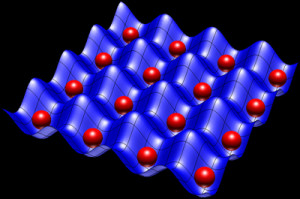 Basically, a quantum computer is a lattice or matrix of quantum-coherent atoms or particles. The most famous property of quantum computers is their greatly enhanced capacity for complex calculation by using the magic of superposition; the computer can simultaneously take multiple paths to the right answer to a problem. But increasingly it is becoming clear that quantum coherence is the same thing as entanglement; and one property of entanglement is that, insofar as entangled particles are sequestered from outside interference, time is irrelevant to the system: A measurement of one particle or atom affects its entangled partners instantaneously. Theoretically, using post-selection and weak measurement, you can even send information into a quantum computer’s past. In a previous post I described one method for doing this devised by Seth Lloyd, using quantum teleportation—essentially a version of “quantum tunneling” in the temporal rather than spatial dimension. But there may be even simpler ways of achieving this, along the lines of the Rochester experiment.
Basically, a quantum computer is a lattice or matrix of quantum-coherent atoms or particles. The most famous property of quantum computers is their greatly enhanced capacity for complex calculation by using the magic of superposition; the computer can simultaneously take multiple paths to the right answer to a problem. But increasingly it is becoming clear that quantum coherence is the same thing as entanglement; and one property of entanglement is that, insofar as entangled particles are sequestered from outside interference, time is irrelevant to the system: A measurement of one particle or atom affects its entangled partners instantaneously. Theoretically, using post-selection and weak measurement, you can even send information into a quantum computer’s past. In a previous post I described one method for doing this devised by Seth Lloyd, using quantum teleportation—essentially a version of “quantum tunneling” in the temporal rather than spatial dimension. But there may be even simpler ways of achieving this, along the lines of the Rochester experiment.
Conceptually, it is not unlike a simple eye, but in the time dimension instead of space.
Imaging the Future
Consider the most basic type of eye in the animal kingdom: an enclosed pit with a photoreceptive retina at the bottom. In the absence of such a pit, there is very little a photoreceptor array can determine about the environment: It can tell you the presence of light and its intensity or frequency, but it cannot “image” the environment. This is a bit analogous to how the back-flowing influence of future interactions is interpreted by us as randomness or chance—generally we can’t say anything more specific about it, so it appears as a kind of noise that, at most, can be quantified (i.e., probability).
No grandfathers were harmed in the making of this precognitive biological guidance system.
But when you do what evolution gradually did (many, many independent times), which is set photoreceptors inside a recess that is mostly enclosed except for a small pupil-like opening overhead, akin to the aperture in a camera, you actually gain much more information from the in-falling light even though you have eliminated most of that light in doing so. Even in the absence of a magnifying lens (which came later and improves the photon-gathering capacity), a narrow aperture acts as a pinhole camera to project an inverted image onto the photoreceptive cells. All the sudden, you have the ability to capture a picture, a re-presentation, of what is outside in the environment, such as a predator or prey.
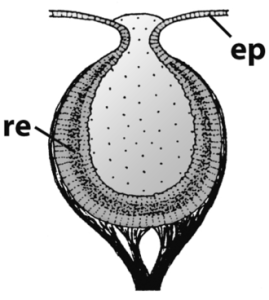 The pupil, the aperture, is a “selector” of light rays—by selecting only a small bundle of rays, it generates much more coherent information about energetic events unfolding in space, facilitating what Alfred Korzybski called space- and energy-binding (i.e., finding food). The basic pre-sense subserved by intracellular quantum computing would be, in contrast, a temporal sense, a time eye, which amounts to an ability to skew behavioral options in the direction of a “right answer”—a reward that lies ahead of the organism in time. It is a “right answer detector”—in other words, a post-selector, and thus a time-binder. To understand how it works, just turn the simple optical eye sideways, along the x-axis of time instead of the y-axis of space. Instead of a rain of light being constrained by a narrow aperture to form a coherent image on the surface below it, the rain of future causal influence in a sensitive quantum computer needs to be constrained at time point B to form a coherent “image” at the earlier time point A. Suddenly that random noise of future influence becomes coherent and carries information that is meaningful for the organism.
The pupil, the aperture, is a “selector” of light rays—by selecting only a small bundle of rays, it generates much more coherent information about energetic events unfolding in space, facilitating what Alfred Korzybski called space- and energy-binding (i.e., finding food). The basic pre-sense subserved by intracellular quantum computing would be, in contrast, a temporal sense, a time eye, which amounts to an ability to skew behavioral options in the direction of a “right answer”—a reward that lies ahead of the organism in time. It is a “right answer detector”—in other words, a post-selector, and thus a time-binder. To understand how it works, just turn the simple optical eye sideways, along the x-axis of time instead of the y-axis of space. Instead of a rain of light being constrained by a narrow aperture to form a coherent image on the surface below it, the rain of future causal influence in a sensitive quantum computer needs to be constrained at time point B to form a coherent “image” at the earlier time point A. Suddenly that random noise of future influence becomes coherent and carries information that is meaningful for the organism.
In other words, to create a time eye, evolution needed to do do exactly what the experimenters at Rochester did: create a system that weakly measures some particles and then measures a subset of them a second time. This requires the system to have a “measuring presence” at two points in time, not just one, the same way a primitive eye requires bodily tissue at two different distances from the external “seen” object (the retina and the pupil). That is no problem at all for an organism that is continuous in time just as it has extension in space.
Most minimally, the constraint, the “aperture” in this system, would be another measurement at a later time point, which is only possible if the organism has survived that long. Survival at time point B causes a detectable perturbation or deviation of a particle’s behavior at a prior time point A inside a microtubule quantum computer. A single such temporal “circuit” would not provide much useful information; but an array of such circuits representing multiple options in a decision-space, operating in tandem, would be a meaningful guidance system, orienting the organism toward that positive outcome: for instance, moving to the left versus moving to the right. If a move to the left sends an “I survived” message back a few microseconds in time, by causing a detectable perturbation or deviation in an electron’s spin, whereas a move to the right causes no such a deviation, and the organism is wired to automatically favor the option with the deviation, then this system—multiple precognitive circuits or “future eyes” linked together to guide behavior—will tend to produce “the correct answer” at a greater than statistically random frequency.
My guess is this is probably (at the crudest level) how microtubules are working as a cellular guidance system. All later “precognitive” systems, such as in the planarian brain or the human brain, are built on this basic platform. It is the basis of all intuition, for instance, and as I’ve suggested, the real nature of the unconscious: The brain, via 86 billion classically linked neurons, each controlled by myriad little quantum computers, is a mega-quantum computer that computes literally four-dimensionally, across its timespan, detecting (faintly) the future at multiple temporal distances out from the present, via post-selection. The “future” that each neuron is detecting is its own future behavior, nothing more—or, perhaps, those microtubules are conditioning the signaling at specific synapses, such that it is really individual synaptic connections that either tend to “survive” (by being potentiated/reinforced) or not. In either case, when assembled into a complex array of interlinked neurons, whole “representations” of future emotions and cognitive states can potentially be projected into the past—or at the very least, the behavior of neural circuits can be mildly conditioned or perturbed by those circuits’ future behavior in response to external stimuli, just as they are strongly conditioned or perturbed by past behavior in the form of the long-term potentiation that subserves memory.
In a complex brain where countless circuits compete for influence in various opponent systems, “reward” has replaced “survival” as the most relevant signal. Right neuronal/synaptic answers are rewarded. This basic orientation toward reward, coupled with its largely unconscious functioning, is why time paradoxes are not an issue for this future detector: There is no tendency to act to foreclose an unconsciously “foreseen” or fore-sensed outcome. Also, as in the experimental systems using weak measurement, the future signal remains noisy, more a “majority report” than anything coherent and unmistakeable. There is lots of room for error, and thus no grandfathers were harmed in the making of this precognitive biological guidance system.
The Planarian Effect
Although this theory has its hand-wavy elements—we still don’t know exactly how quantum computing works in microtubules—it is a lot less hand-wavy than “syntropy” and “morphic resonance” as accounts of how complex systems orient toward orderly future outcomes. We need not imagine anything intrinsic in the fabric of space, time, and causality that gives rise to “attractors” in the future. Order and complexity are mediated by precognitive cellular intelligence, and at higher levels, by brains. The already unimaginably complex classical interconnection of neurons that we can crudely study with today’s imaging tools is just one level of information processing, but it is built over a more fundamental level of quantum computing that we still have not even begun to map.
Peering into my future-scope, I can see that “post-selection” is going to be the concept du jour of the next decade.
And if I am right, we will no longer need to appeal to even hand-wavier notions of “transcendent mind” or “extended consciousness” to explain our basic pre-sense. As I’ve said again and again on this blog, consciousness (whatever it is or isn’t) is a big maguffin, the fake rabbit all the dogs are chasing around the racetrack. But we should applaud the chase, and even place bets, because the search for quantum consciousness will, as an unintended byproduct, fill in the nitty-gritty details of how the basic biological future-detector, the time eye, works … and thus make all the psi-skeptics eat crow.
 Peering into my future-scope, I can see that “post-selection,” the causal Darwinism that makes the time eye possible without paradox, is going to be the concept du jour of the next decade, the way Gleick’s “butterfly effect” was the concept du jour of the late 1980s. Maybe they will call it the “planarian effect,” for the way a loud noise at 3:00 PM affects the waggle of a worm at 2:59.*
Peering into my future-scope, I can see that “post-selection,” the causal Darwinism that makes the time eye possible without paradox, is going to be the concept du jour of the next decade, the way Gleick’s “butterfly effect” was the concept du jour of the late 1980s. Maybe they will call it the “planarian effect,” for the way a loud noise at 3:00 PM affects the waggle of a worm at 2:59.*
NOTE:
*The previous most interesting discovery about planarian worms was made by memory researcher James McConnell back in the 1960s: If you subject one planarian worm to conditioned learning, then grind it up and feed it to another unconditioned worm, the cannibal worm acquires the first worm’s memories (see “Memory Transfer Through Cannibalism in Planarians“). Don’t try this at home. Unfortunately, McConnell’s methods and findings were subsequently criticized, but recent studies do show that decapitated planarians can grow new heads with their old memories intact, suggesting that their memories may indeed somehow be chemically rather than neuronally encoded, and not entirely in their wee brains.
The Ancient Art of Memory & the Modern Science of Dreaming
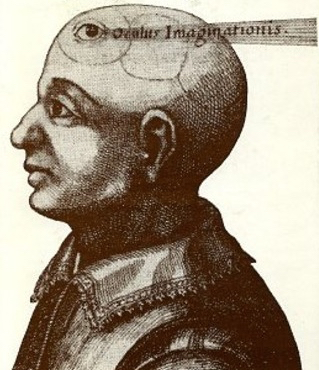 Check out my essay on dreaming and the ancient art of memory (hint: they operate on the same principles), the lead article in this month’s special issue of New Dawn magazine.
Check out my essay on dreaming and the ancient art of memory (hint: they operate on the same principles), the lead article in this month’s special issue of New Dawn magazine.
You can also read the essay with its graphics by downloading a copy of Special Issue Vol 10 No 4 (PDF version) for US$5.95. The issue also contains articles by Bernardo Kastrup, Ervin Laszlo & Kingsley L. Dennis, Michael Grosso, Micah Hanks, and many others.
